You are using an out of date browser. It may not display this or other websites correctly.
You should upgrade or use an alternative browser.
You should upgrade or use an alternative browser.
Reviews by cash1489
Filters
Show only:
Loading…
cash1489
New Head-Fier
Pros: Bulletproof Build Quality
Great Balanced Sound with Tons of Detail
Powerful Amp Section
Great Balanced Sound with Tons of Detail
Powerful Amp Section
Cons: Soundstage Could Be A Little Wider
TL;DR
With improvements in its detail and separation, the iFi hip dac2 is a worthy upgrade to the original.Intro
Back in January of 2020, iFi dropped a new battery-powered portable amp that was slimmer and lighter than anything they had released to date. It was called the hip-dac, named as such because the design resembled a hip flask.I felt the design was ingenious because the flask shape was a tried and tested concept of pocketability, plus it looked pretty slick. In my review, I raved about its ability to drive full-size headphones with enthusiasm, and I also loved the crisp, transparent sound.
I plainly wasn’t alone, because the hip dac has proven to be extremely popular. I talk to folks all the time who profess their love for its sound.
Well, at the beginning of this month, iFi unveiled the sequel, the $189 hip dac2. It’s $20 more than the original, and while the looks/features are pretty much the same (outside of a cool new orange paint job), the internals have received similar upgrades to its desktop cousin, the ZEN Dac V2 (our review here).
These enhancements are said to make the hip dac2 more transparent than its predecessor, as well as open the door for full MQA decoding, which the first one didn’t do.

So the question is with the first hip dac being so good, can the new one improve significantly on its ability to provide one of the best battery-powered DAC/Amp experiences for under $200?
Or,
if you already have the hip-dac, should you upgrade to the new one?
Well read on, and I’ll let you what I think!
Disclaimer: The review unit I have on hand is provided on loan by iFi Audio. No input has been given regarding the content contained in this evaluation. The hip dac2 will be returned at the end of my trial.
Specs
| Formats supported | DSD PCM DXD MQA | 256/128/64, Quad/Double/Single-Speed 384/352.8/192/176.4/96/88.2/48/44.1kHz 384/352.8kHz 384/352.8kHz |
| Digital Inputs | USB 3.0 Type ‘A’ (USB2.0 compatible) | |
| Headphone Outputs | Balanced S-Balanced (S-E) | 4.4mm 3.5mm |
| Power Output (@1% THD) | Balanced S-Balanced (S-E) | 400mW@32Ω; 6.3V@600Ω 280mW@32Ω; 3.2V@600Ω |
| Battery | Lithium-polymer 2200mAh | Approx. 8 hours |
| Power System | Charging via USB-C, BC V1.2 compliant up to 1000mA charging current and 6.3 volts | |
| Power (max) | <2W idle, 4W max | |
| Dimensions | 102 x 70 x 14mm 4.0″ x 2.8″ x 0.6″ | |
| Weight | 125g (0.28 lbs) |
Build/Features
So, as I said earlier, externally the hip dac2 looks almost exactly like the original, save the new metallic orange color. The size and weight, noted above, remain the same.I was ok with the teal blue on the first hip dac, but I LOVE the orange on the new model. It just looks more premium to me, like those Audi R8’s that come in a similar color.
That said, features and power are the same, with output rated at 2.0V / 400mW @ 32 ohms via the 4.4mm balanced jack and 280mW @ 32 ohms via the 3.5mm unbalanced jack. iFi’s excellent XBass processing for bass boost returns as well, along with their PowerMatch 2-level gain control. They also use the same volume control pot.

On the rear of the unit, they have brought back their unique USB-A connector with allows the use of USB OTG cables as well as the Apple Lightning to USB Camera Adapter for connection to iPhones.
As with the first hip dac, the USB-A connector will not charge the battery (rated for 8 hrs.), for that you have to use the USB-C port next to it. Battery life is good, but watch out for a decrease in sound quality when the battery gets low.
As far as the DAC chip, the hip dac 2 uses the same Burr-Brown chip as the original and therefore supports the same audio files: PCM up to 32-bit/384kHz, and DSD 256 (11.2 MHz).
So What’s The Difference?
So far, I’ve spent a lot of time talking about the similarities between the first and second hip dac, so I’m sure you’re wondering about the differences.Well, as I said before, the differences are mostly internal. To begin with, like the new ZEN Dac V2, the hip dac2 now has a 16-core XMOS processor/microcontroller pulled from the flagship Diablo and NEO DAC/amps.
This chip, which processes data received via USB, is now said to deliver double the clock speed and four times the memory of the old 8-core chip.
Because of the new XMOS chipset, the hip dac2 also becomes a full MQA decoder like the iFi Diablo, NEO, and ZEN Dac 2. This means that it does all the MQA processing inside of the DAC, and because of this, it can authenticate “MQA Studio” files, which are files where the sound is supposedly approved by the artist/producer or verified by the copyright owner.

A blue light on the front of the DAC signifies “provenance”, which in MQA parlance means you’re playing an MQA Studio file and hearing the exact sound that was approved in the studio.
The original hip-dac was just an MQA “renderer”, which means it could only play MQA files that were first decoded by software like the TIDAL app.
This is significant because there are very few battery-powered full MQA Decoders that are as compact and have the same level of power output as the hip dac2.
According to iFi, the new hip dac also has an upgraded crystal clock which removes more jitter or digital distortion than the one in the first model.
Sound
For my sound tests, I connected the hip dac2 both to my HP Envy X360 laptop and my Samsung Galaxy S21 Ultra using the included USB-C adapter. As far as headphones go, I used the $350 Hifiman SUNDARA, as it’s relatively neutral and matches up pricewise.To test the output power, I also tried the Mr. Speakers AEON Flow Closed, which is tricky to drive. Without the PowerMatch gain engaged, it took about three-quarters of a turn on the volume knob to get them going.
However, with the gain button turned on, the hip dac2 needed less than a half-turn on the knob to get them up to a good listening volume. This amp should drive anything but the most inefficient planar headphones, which are probably not a good match for this battery-powered product anyway.
By the way, with the SUNDARA, I used it with PowerMatch turned off, and the volume knob just below a half-turn.

This was all via the Single-Ended output, so that should give you an idea of just how potent this amp is. For kicks, I hooked up the SUNDARA up to the balanced out just to gauge the power coming from there, and I barely got the knob up past a quarter-turn before killing my eardrums. That was on the low gain setting.
Tonal Balance
As with the first hip dac, the tuning of the hip dac2 DAC/Amp is overall pretty balanced, with a slight elevation in the upper mids and the midbass for a tad bit of warmth. For the most part, it doesn’t add anything to the music other than a little bit of sparkle up top. The perspective is decidedly forward, giving you a front-row seat at the show.
If you want a little extra warmth you can turn on the XBass, but it will come at the expense of a little bloom in the mids. I don’t think it’s necessary for the SUNDARA personally, but for headphones that sound a little too flat, XBass is the best at adding in some excitement without totally muddying up the midrange.
Detail
I liked the detail on the original hip dac, but the hip dac2 definitely has more crispness than the first one. Top-end detail and harmonics are extremely rich, with strings and vocals just a little more filled out on the new model than on the old one. It’s a similar experience to when I compared the ZEN Dac and ZEN Dac V2.

I guess the only thing some could say is that the new presentation borders on too analytical, especially with something like the SUNDARA, which trends that way with certain music. I don’t think so, I rather enjoy the crispness, although it can come across as synthetic at times, especially with Planars.
Soundstage and Imaging
As far as Soundstage goes, it has a stage that’s more deep than wide. But the depth was decent for a DAC/Amp under $200. It seems just a little bit deeper than the original hip dac.
When I listened to “Afro-Bossa” by Duke Ellington and his Orchestra, The width of the soundstage just went beyond the earcups and I could hear some decent layering from front to back.
The drums appeared clearly at the back of the stage, while the horns appeared up front on either side. The separation of elements in the mix had just a little more definition than on the original hip dac.
Listening to “Unplugged” by Eric Clapton, I was pleased with how well the hip dac2 placed the vocalist and background guitarists in their own little bubbles. I would say imaging is very good for the price point, with delineation approaching DAC/Amp combos in the next price tier.
I would’ve personally liked to hear just a little more soundstage width, but it was in no way a dealbreaker.
In General…
If you know what the first hip dac sounds like, then I wouldn’t expect wholesale changes in the overall sound signature, but instead a refinement of the sound with more transparency and detail. The second hip dac is a little more analytical than the first, but not to the point of fatigue. To me, the additional resolution allows the hip dac2 to pull out more music information which gives you a more vivid picture of what’s going on in a recording. At the end of the day, expect a more intimate performance with a lot of presence.
Comparisons
That said, I didn’t quite get the spatiality or separation of the $249 EarMen TR Amp which I also had on hand. On the hip dac2, the elements of the mix, while rich and detailed, felt a little more squeezed in, with everything placed almost on top of one another.

However, the hip dac2 sells for $60 less, and I would say it gives you about 90 percent of the TR-Amp’s separation. Not to mention it has a balanced output and full MQA decoding, which the EarMen amp doesn’t. It’s also a lot slimmer and lighter.
Compared to the $199 THX Onyx, which is a USB DAC/Amp in the same price range as the hip dac2, I felt the iFi had more focused imaging and better detail, but the Onyx had a wider soundstage.
The Wrap Up

If you’re looking for a battery-powered portable DAC/Amp combo under $200, the iFi hip dac2 is hard to beat. It has an excellent mix of features, remarkable power, and most importantly it sounds damn good. If you have the original hip dac, I wouldn’t say there’s a wholesale change to the sound, but I believe the additional detail and transparency make it worth the upgrade. Highly Recommended!
This review was originally posted at hifitrends.com
Last edited by a moderator:
cash1489
New Head-Fier
Pros: Beautiful Design
Smooth, Crisp, Balanced Sound
Expansive Soundstage
Smooth, Crisp, Balanced Sound
Expansive Soundstage
Cons: No Hard Storage Case
Sound is a little edgy up top
Sound is a little edgy up top
The Low Down
While the good looks, quality build, and reasonable price may get them in the door, the Sivga SV021's ($149) sensational comfort plus detailed and expansive presentation keep them hanging around.These nice closed-back dynamic headphones have a naturally open sound that makes them a joy to listen to, and the plush earpads will make sure you feel good while doing so. They’re also very sensitive, so you can drive them with any device.
That said, they do scale up well with a quality DAC/Amp combo like the Audioquest Dragonfly Cobalt.
There is some roll-off at the extremes of the audioband, which keeps it from fully competing with more expensive offerings, but their lively, open presentation makes them sound a lot more expensive than they are. Just keep in mind, there is a bit of peakiness up top that comes out on certain songs, so if you're sensitive to upper mids/lower treble, then that's something to think about. They also do better with lower gain sources.
The only thing they’re missing is a hard storage case, but they do come with a nice box to store and protect them at home.
Good-sounding closed-back headphones are hard to come by, especially for $149! So if you’re looking for a decent sounding closed-back headphone at a value price, check it out!
(Check out our review of the SIVGA Phoenix Open Back Headphones!)
Build/Comfort
The Sivga SV021, otherwise known as “Robin,” is a closed-back headphone with sumptuous lacquered wood earcups and plush protein leather earpads. The sleek metal headband is also covered in plush protein leather.The color scheme of tan leather juxtaposed against the aluminum frame and rosewood cups makes the Sivga SV021 look more premium than you would expect for the cost. The matching tangle-resistant detachable cable adds to the luxurious look.
Speaking of detachable, the earpads are removable as well. In addition, a bayonet mount makes for quick replacement when the originals are worn out.
As far as wearing comfort goes, the light clamping force combined with the cushy memory foam earpads makes these very nice to wear for long listening sessions. And even though the clamp is light, it still keeps the headphones firmly placed on your head. So it’s really nicely judged.
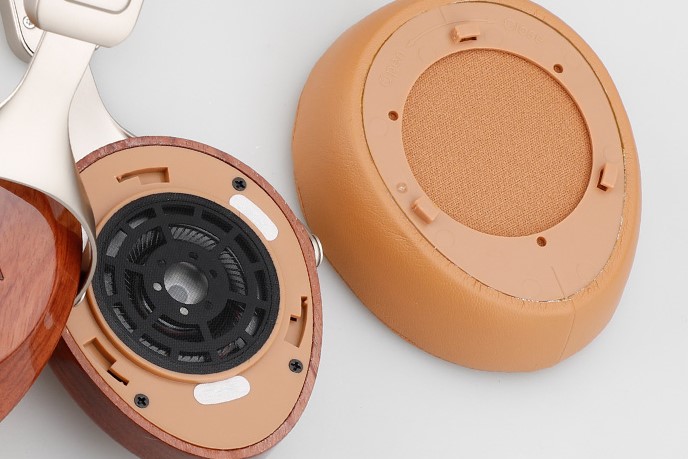
I also liked how the cups adjusted smoothly and clicked securely in place. They have a wide range of adjustment, so you will have no issue with fit if you have a big noggin like mine. The teardrop-shaped openings in the pads also had plenty of room for my big ears, which was nice.
Inside the cups, you will find large 50mm diameter drivers with thin polycarbonate diaphragms and 3mm Neodymium magnets for a powerful dynamic performance.
While I didn’t find a whole lot to complain about in terms of build, it’s worth mentioning that noise isolation is rather weak for a closed-back headphone. It’s better than an open-back but not great compared to other closed models.
Also, inside the box, there aren’t many extras. You get a cloth-carrying pouch along with a 3.5mm to 1/4“ adapter, and that’s about it. I would’ve loved to see a hard-carrying case like the one that comes with their Phoenix headphones.
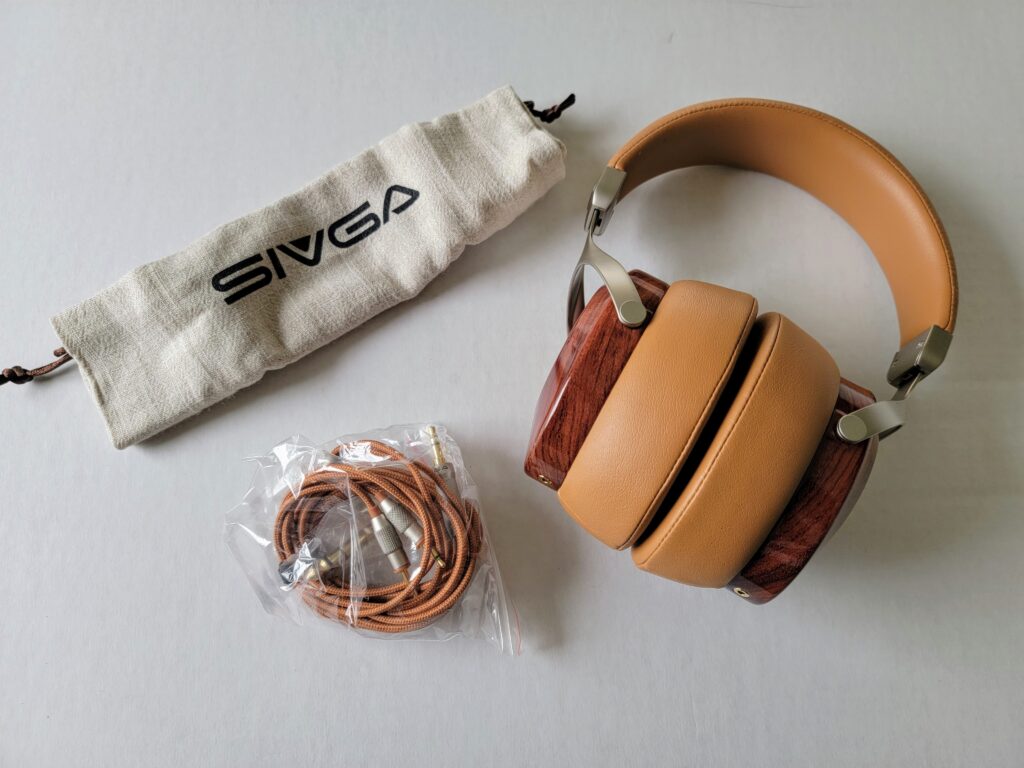
However, with the SV021 selling at such a great price, I can’t complain too much, especially with nice cases selling for as little as 10 bucks on Amazon.
Listening To The Sivga SV021
For my listening tests, I hooked the SV021 up to many different DAC/Amp combos. My two favorites were the $79 Audirect Atom2 and $159 iFi Audio ZEN Dac V2, as they both were a good value just like the headphones, and they had a nice mixture of warmth and detail.Their sound played well with the SV021, which benefited from their warmth and dynamics. They also curtailed the Sivga’s slight bit of peakiness in the upper mids, which to me is this headphone’s main weakness.
If I had to sum up the SV021 sound in one word, it would be “musical.” I know many people don’t like that word since it can be vague, but to me, it means a sound that pulls you into the music, which these do.
Plenty of budget headphones can do this, like the Hifiman SUNDARA or the Grado HEMP, but those are open-back headphones that cost more than double what the SV021 costs. It’s quite another thing for an inexpensive closed-back headphone to be so open and engaging when playing music, especially for $150.
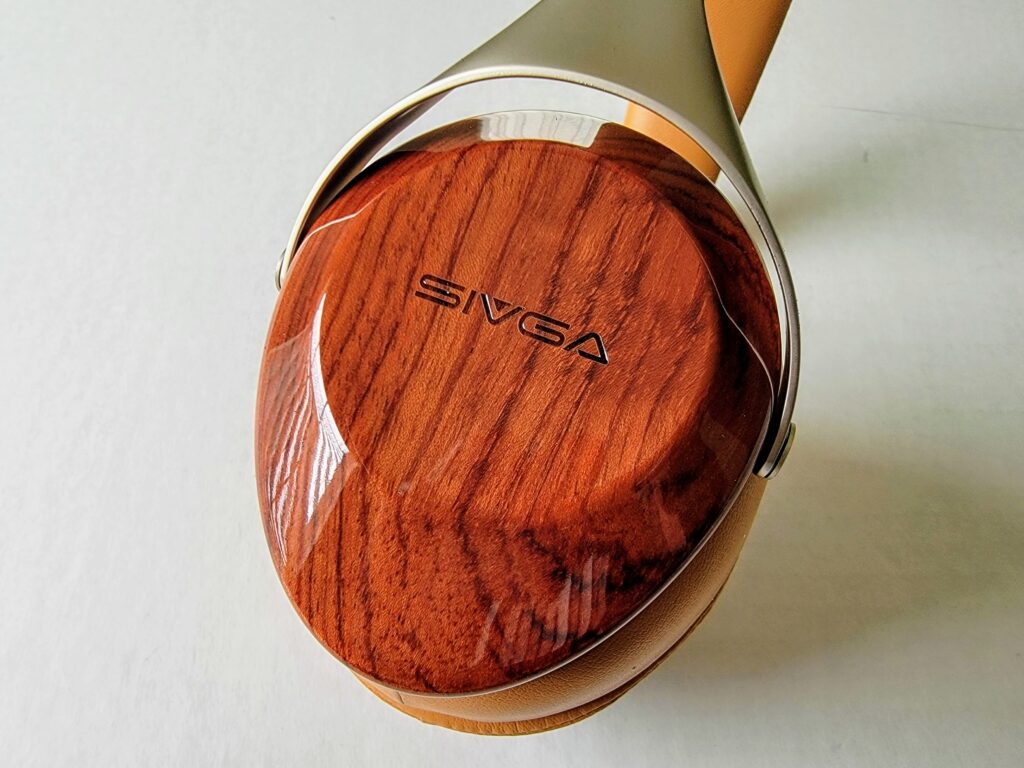
In terms of detail, the SV021 had good macro and micro detail, although the macro detail was much better, as expected from a budget headphone. That said, although the top end detail was slightly rolled off, removing some of the air you get from more expensive offerings, there was enough there to give me a “big picture” view of the recording space.
As this headphone has something of a V-Shaped sound signature, the mids were more recessed than I usually like. As I said earlier, there is also a tad bit of edginess in the upper mids, but this flaw only became overly distracting when there was hardness coming from a budget DAC/Amp in the chain.
The edginess was hardly noticeable with more refined setups, and the overall the Robin came across as very . There wasn’t any bleed from the upper bass, and the timbre of instruments like strings and drums was quite natural.
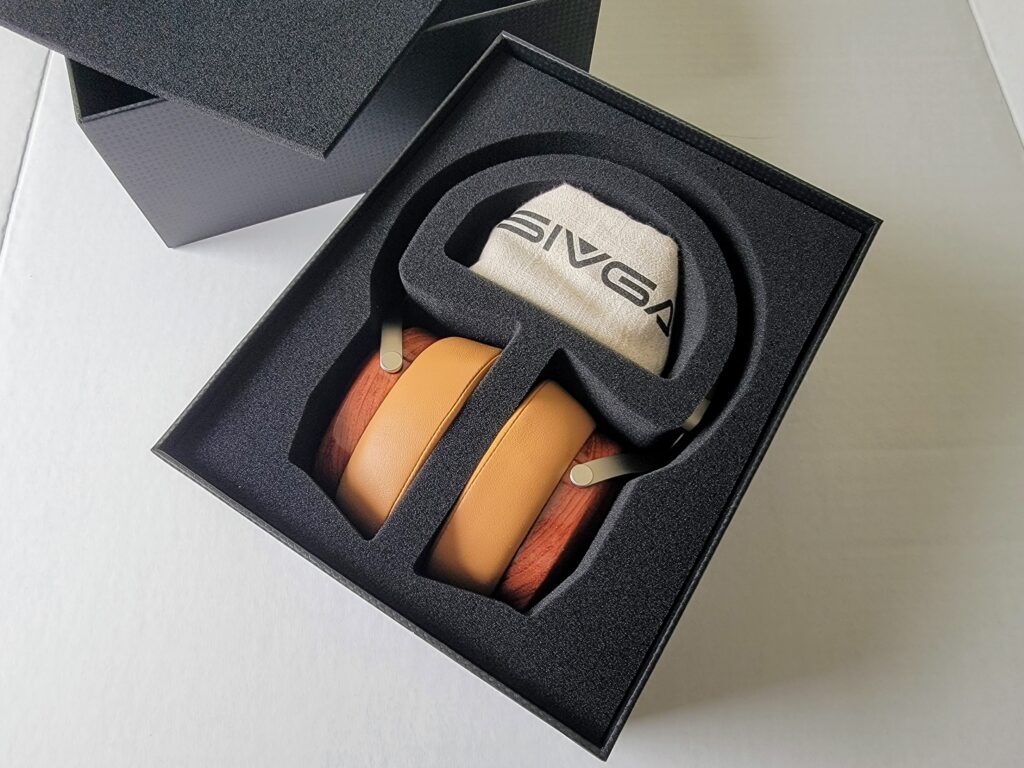
The bass on the SV021 isn’t articulate, but this headphone gives you more than enough mid-bass punch to make things interesting. However, you don’t get the sub-bass rumble as you would get from a Meze 99 headphone.
This is probably the best approach with a closed-back headphone, as a lot of rumble can quickly throw the tonal balance out of wack, making the low end too distracting. That said, bassheads may want a little more depth down low.
Regarding separation, the Robin was good, as they did a decent job of pulling out all the elements of the mix. For example, listening to “Hammer Falls” by The Wandering Hearts, I was impressed by how well all the guitar parts and various harmony parts were broken out.
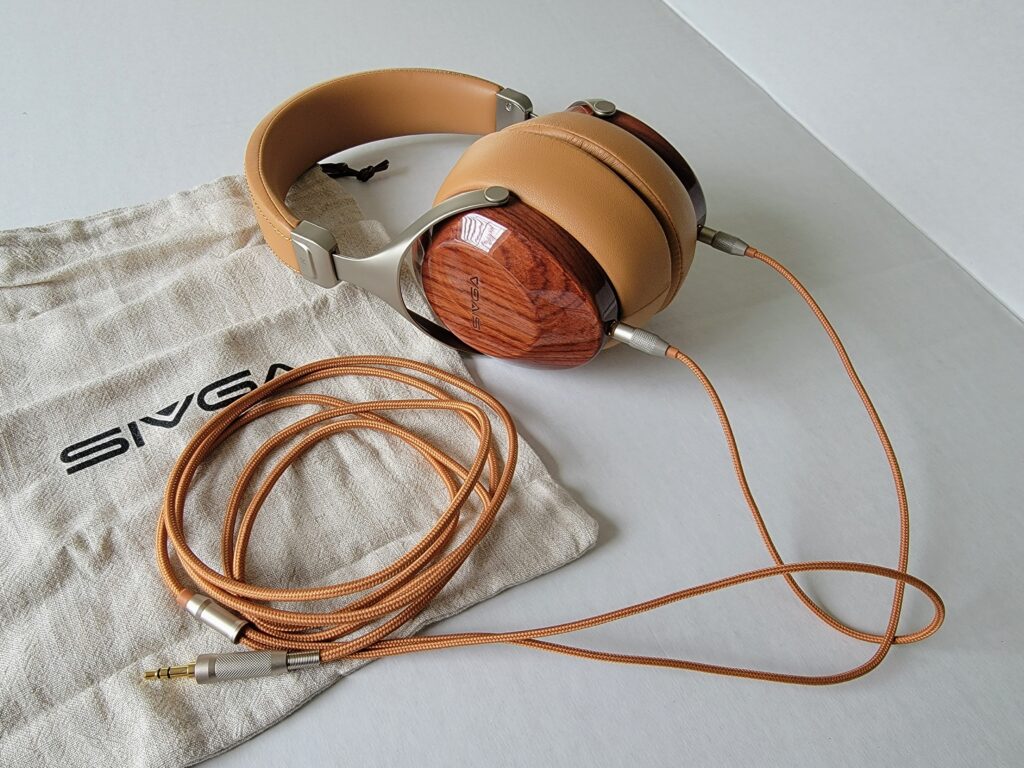
The strings were also rich and full-bodied, which demonstrated how well these headphones reproduced timbre. Due to the top-end roll-off, I didn’t quite get the micro-detail one would get from a more expensive headphone (like the SUNDARA, for example), but the strings were still pleasing.
When it came to Dynamics, the Macrodynamics were really good. Microdynamics were sufficient enough to give me an inkling of spatiality. The difference between quiet and loud passages was quite pronounced, especially for a headphone at this level.
When I compared it to the Drop x Sennheiser HD58X Jubilee, another headphone I like at the SV021’s price point, the HD58X did better with Microdynamics, meaning you could actually hear "into" the music better, but I liked the Macrodynamics on the Sivga headphone a little more.
As far as Soundstage and Imaging go, this is the area the SV021 really impressed me. It’s tough to make a closed-back headphone sound somewhat open and speaker-like, and the ones that succeed usually sell for $500 and above. So the fact that Sivga achieved this in a headphone that costs 150 bucks is amazing.
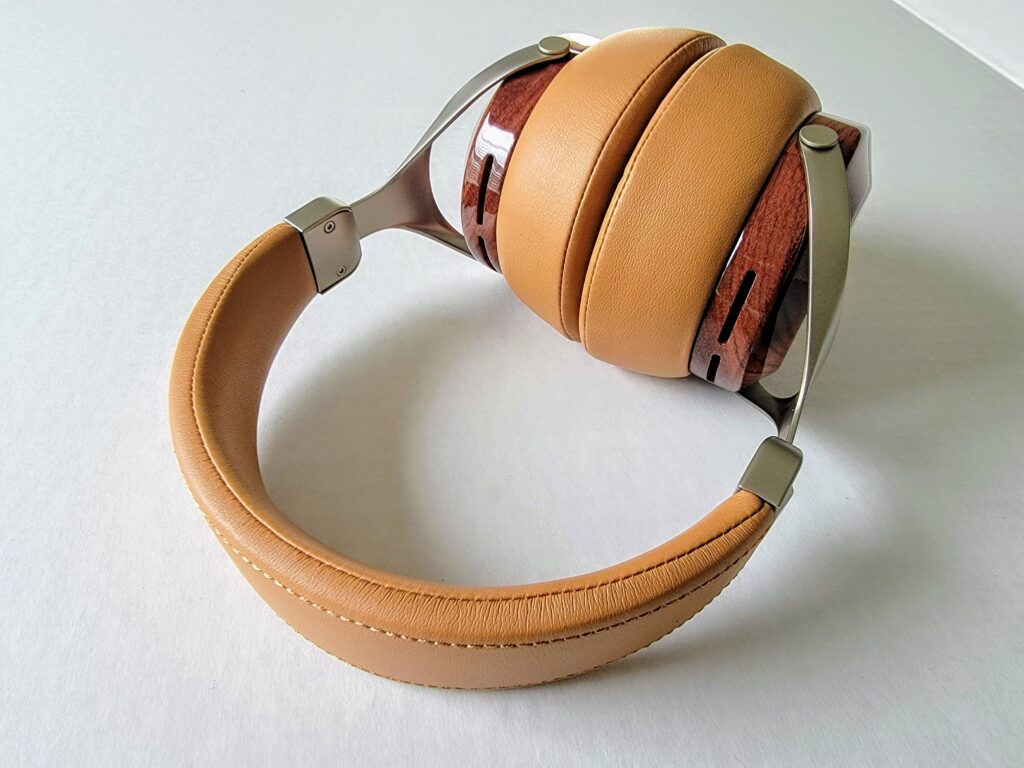
It won’t compete with more expensive open-back headphones, but it sure holds its own against open-back headphones in its price range.
Again, when comparing it to the open-back Drop HD58X, it actually had a bigger soundstage and less of the “three-blob” left, right, center effect. That said, it didn’t have quite the full panoramic sound or the soundstage width of the aforementioned SUNDARA.
The Wrap Up
With its warm, expansive sound, not to mention its beautiful design, the B]Sivga SV021[/B] has become a quality option for a sub $500 closed-back headphone. So if you're looking for budget audiophile cans to play your tunes while working, these should be on your list...This review was originally posted at hifitrends.com
Last edited by a moderator:
NymPHONOmaniac
seem like semi-open back HP to me...due to venting ports on the cups. Kinda AKG K141mk2 ...
what about sound leakage bro??
what about sound leakage bro??
Gevi
Yeah I have been also hesitant on them regarding isolation.
However from what I have read so far, it doesn't seam to be that noticeable.
However from what I have read so far, it doesn't seam to be that noticeable.
cash1489
New Head-Fier
Pros: Solid Build
Sound Has Excellent Balance and Separation
Powerful Amp Section
Sound Has Excellent Balance and Separation
Powerful Amp Section
Cons: Sound Lacks Just A Tad Bit of Depth
Summary
Shanling Audio has done some good stuff when it comes to DAC/Headphone Amp combos, both portable and desktop. Their BA1 Bluetooth Desktop DAC Amp scored high marks when we reviewed it earlier this year, providing a nice balanced sound for both headphones and hi-fi.
They also have the $45 UA1 portable DAC/Amp, a budget audiophile favorite due to its clean, detailed sound and relatively robust amp section.
Both of those are built around the ESS ES9218P combo Dac/Amplifier chip, but today we’re looking at the new step-up from the UA1, the $85 Shanling UA2 DAC/Amp combo. It has an ES9038Q2M ESS DAC Chip (which decodes DSD512 and PCM up to 32/768) along with a separate Ricore RT6863 chip to handle amplification.
HIFIGO.COM-SHANLING UA2 ES9038Q2M Portable USB DAC Headphone AMP
It also has a 2.5 Balanced output along with the 3.5mm single-ended jack and a detachable USB-C cable which adds some flexibility. When you plug into the balanced jack, you get 195mw of juice into 32 ohms, making it one of the most potent DAC amps out there, especially under $100.
If you don’t care about MQA, the UA2 will give you an excellent crisp, balanced sound that will work with all but the most power-hungry headphones, especially if you plug into the balanced jack. It also works well with iPhones due to its USB-C jack, which lets you swap in a lighting cable.
Disclaimer: The Shanling UA2 was sent to us by Shanling in exchange for our honest review. It doesn’t have to be returned once the review is complete.
Build/Features
The Shanling UA2 DAC Amp is yet another stick-type DAC Headphone/Amp with a USB connection on one end and a 3.5mm jack on the other end for your headphones or IEMS. It also gets its power from your phone or laptop and bypasses the likely inferior DAC in your device.
However, where the UA2 DAC differs from other DAC Amps is with its detachable USB-C cable, which plugs into a USB-C connector on the end of the DAC. This allows you to swap out the included cable with a USB-C to lightning cable (sold separately) for your iPhone.
The UA2 also sets itself apart with an additional 2.5mm balanced output, almost unheard of at this price point. I personally only know of two other sub-$99 devices with this feature.
I like the look and feel of this DAC. The slim bar shape looks slick and fits nicely in hand, plus the all-metal casing looks built to last.
On one side, you have the two headphone jacks, both balanced and single-ended, along with a tiny led that indicates the PCM sample rate/DSD output, and on the other side, there’s a female USB-C connector for the detachable USB cable.
I like that the LED has five different colors to differentiate the PCM sample rates, which gives a more accurate gauge of the conversion taking place. This contrasts with other DAC/Amps that only provide two or three different indications for the whole range of sample rates.
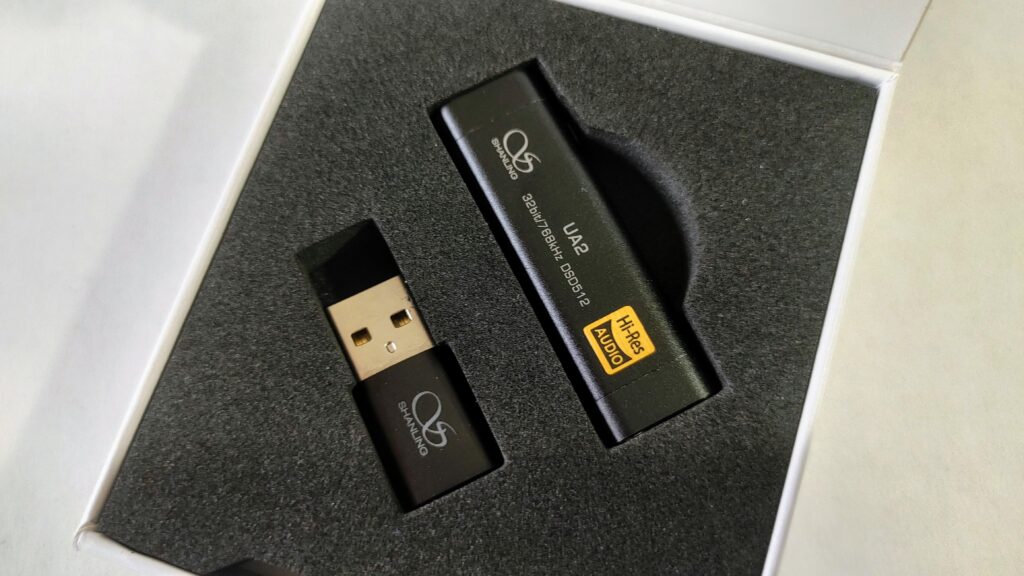
On the right side of the UA2, there’s a little button marked “Mode” that allows you to connect it to portable game consoles like the Nintendo Switch.
I’m not too familiar with this protocol, but from my understanding, if you hold it down while connecting it to the Switch, it will allow you to make a USB-C connection that works with the device. Then you can get better sound when gaming.
In the box, along with the DAC/Amp unit and the short USB-C to USB-C cable, you also get a USB-C to USB-A adapter so you can connect the UA2 to a laptop.
Inside of the UA2, you get a DAC section based around the well-respected ESS ES9218P Dac chip; a chip used to significant effect in the Khadas Tone2 Pro, another DAC/Amp we recently reviewed.
Coupled with the DAC chip is a Ricore RT6863 Amplifier chip designed to work with ESS chips. Shanling claims they picked it for its low-noise characteristics. The specs look good when it comes to power, with a respectable 125mW into 32 Ohms coming from the SE output and a remarkable 195mW into 32 Ohms coming from the Balanced output.
That 195mW spec puts the UA2 in about the top third of portable DAC/Amp units, and it drove my Hifiman SUNDARA with absolutely no problem, bringing them to a comfortable listening level at about a quarter volume.
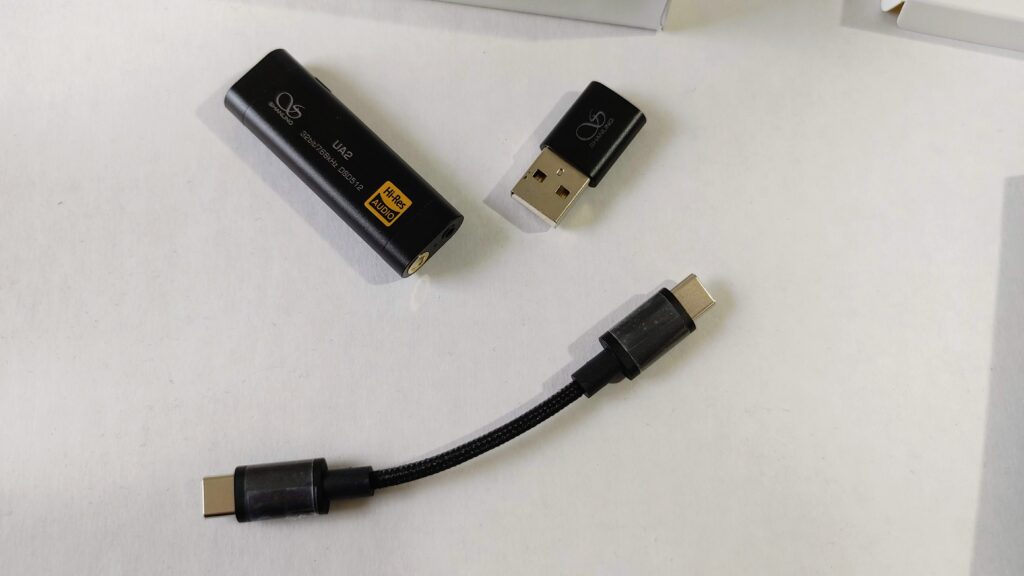
Even the single-ended jack had some decent muscle, driving my Mr. Speakers (Now Dan Clark Audio) AEON Flow Closed headphones to a pleasant listening level at about 50% volume, albeit with some constricted dynamics.
Like the UA1 and BA1, Shanling provides some additional adjustment of the UA2 with an app. It’s called the Eddict player, and it will let you change the gain or the digital filter. Unfortunately, this is only available for Android devices (sorry, Apple folks).
I liked the way UA2 sounded out of the box, so I didn’t mess around too much with these settings, but they are nice options to have. Especially if you like to tweak things or you have a very sensitive set of IEMs.
Funny enough, you can also use the Eddict app to play music stored on your phone, but not through the Shanling DAC. At least it didn’t work on my Moto G Power (2020) phone I use for testing.
Listening to the Shanling UA2 Portable USB DAC/Amp
For my listening tests, I connected the UA2 up to both my Moto G Power Android phone and my iPhone XR using a short USB-C to Lightning cable in place of the included USB-C to USB-C cable.
I also connected it to my HP Envy X360 laptop using the included USB-C cable and USB-A adapter.
For most of my testing, I streamed Hi-Res music from Qobuz (30-day free trial), using a pair of $349 Hifiman SUNDARA headphones.
The UA2 connected quickly to all devices, even the iPhone XR using an aftermarket lighting cable from Shanling.
As I said earlier, on either the Single-Ended or Balanced output, the UA2 had no problem driving the SUNDARA to its full potential, producing excellent macro and microdynamics. If I had to sum up the UA2’s sound with one word, it would be “rich.”
As I initially listened using the single-ended connection, I found the top end quite smooth and refined, which was nice to hear from such an inexpensive DAC. I’ve heard way too many budget dacs that accentuate the highs way too much in the name of producing “detail.”

This is especially true with lesser implementations of the ESS DAC chips.
It was nice to hear that wasn’t the case here, as the UA2’s detail was present without excessive sparkle. There was a slight roll-off at the very top, but it impacted air very little, which was good. If you like a super lively sound up top, then you may consider the UA2 a little dark sounding. I didn’t.
On the contrary, I think the UA2 did a great job of smoothing out the rough edges sometimes present on the SUNDARA without dulling the sound too much.
Throughout the midrange, vocals and instruments sounded quite natural in texture, and the bass presentation through the Hifiman headphones was tight and articulate, faithfully bringing across Christian McBride’s upright bass on “Blues Connotation” from his new project “The Q Sessions.” His instrument punctuated and drove the performance as it should have due to the UA2 doing such a great job of resolving his string work.
As far as depth and separation are concerned, I was astonished at well this $85 unit separated the elements of the mix, putting the drum, bass, and horn in their own little “bubbles.” The depth was good for the price, but better layering can be had at higher price points.
That said, you would probably have to spend double the price to get a vast improvement.
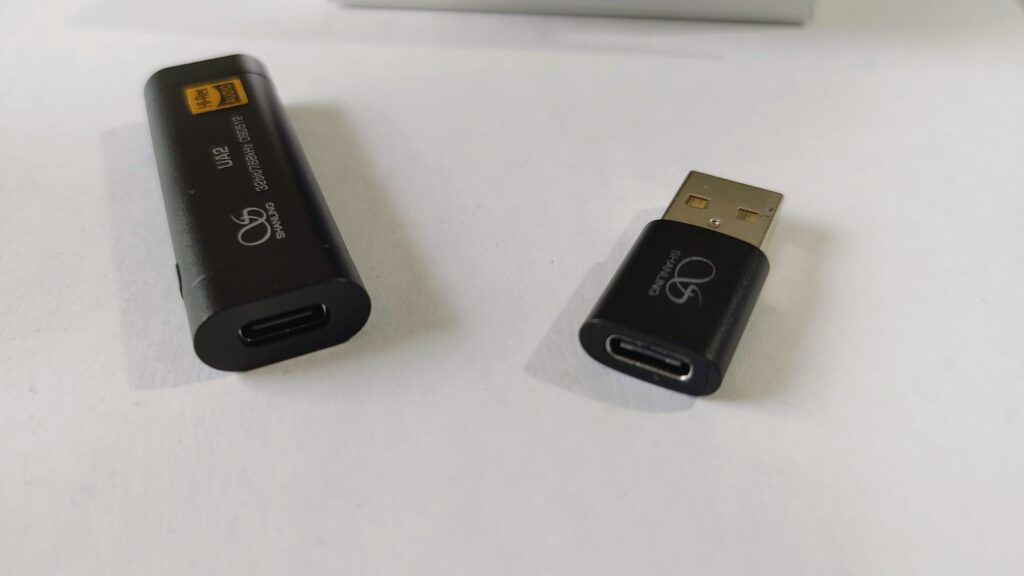
Moving over to the balanced output, the separation got even better, and the depth was more apparent as well, but still not to the level of a more expensive DAC/Amp combo.
What really astonished me when listening from the balanced output was how much better this little DAC resolved the characteristics of the different instruments. The separation was also much more pronounced.
On the balanced output, all the instruments were fleshed out amazingly well, even when they played simultaneously. You could hear exactly what the horn, bass, and drum were doing at all times, which is remarkable for such a cheap device. Many sub $100 DACs will mash the more intricate parts of the mix together, but not so with the UA2.
That said, if you really concentrated on it, you could hear that the highest notes of instruments, especially the horns, were a little truncated, but not to the point of distraction.
Comparison with the Shanling UA1
Just for kicks, I decided to make a quick comparison with the UA1, the USB DAC Amp the UA2 now sits above in the Shanling line-up. The UA1 is about half the price of the UA2, only produces about half the power, and doesn’t have the detachable cable or Balanced output of the UA2.
That said, for $45, the UA1 has decent power (85mW into 32 ohms), and it’s even more compact than the UA2, which may appeal more to some.
As far as sound is concerned, the UA1’s single-ended output compared quite well with the single-ended output of the UA2. When using the SUNDARA, the UA1 drove them just about as well as the UA, even though it didn’t have the same headroom.
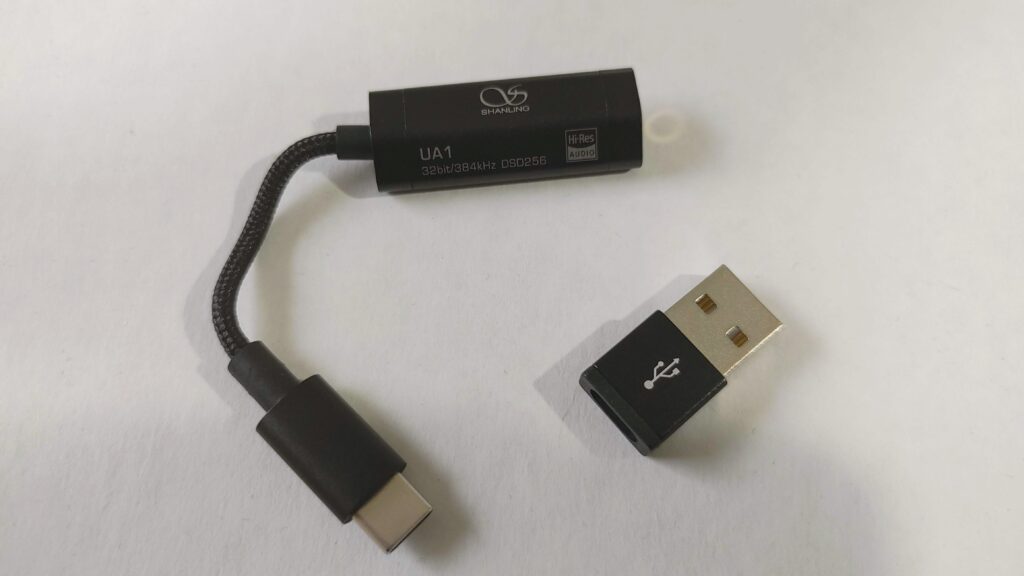
The UA1 was a little more lively on the top and bottom when compared to the UA2, which some may prefer. The UA1’s extra sparkle and rumble did provide a little extra excitement to the mix. However, I personally felt this came at the expense of a little refinement.
I felt the UA1’s separation and depth on the single-ended output came up slightly behind what you get from the single-ended output of the UA2 and well behind the UA2’s balanced output.
That said, the UA1 is really good for a $45 DAC Amp, and I would recommend it to anyone looking for an inexpensive companion to the SUNDARA. If you’re really sensitive to edginess up top or want a little more separation, I would spend a little more and get the balanced output on the UA2.
The Wrap Up

I really dig the UA2. I love the compact metal casing, the detachable cable, and the balanced output option. Both the balanced and single-ended outputs can drive a wide variety of headphones, and the detachable cable makes it easy to use with an iPhone. The sound is also really good, especially on the Balanced side with its excellent separation and tonal balance.
If you don’t care about MQA, and you have a pair of headphones that you can run balanced, the Shanling Audio UA2 is a top-flight DAC Amp Combo, available for a song. Highly Recommended!!
This review was originally posted at hifitrends.com: https://hifitrends.com/2021/05/23/s...c-amp-combo-has-jaw-dropping-power-and-sound/
Last edited by a moderator:
Loukasss
Hi, great review. Thanks to that i decided and bought the UA2. It’s incredible. The only thing i wanted to know is: Where can i buy the Lighting cable to connect the dac to my Iphone. Thanks for all. See ya 

cash1489
New Head-Fier
Pros: Slim Lightweight Build
Detailed Natural Sound
Decent Instrument Separation
Detailed Natural Sound
Decent Instrument Separation
Cons: No DSD
Lacks A Little Power
Lacks A Little Power
Summary
Yes, the Dongle DAC/Amp market is super crowded right now, but that hasn’t stopped Periodic Audio from dropping their own branded dongle DAC at a reasonable price of $49.
It’s called the Periodic Audio Rhodium DAC, and it has 32bit/384kHz high-res PCM decoding, along with 30 mW of power to boost their earphones. Periodic is all about mobile hi-fi, so they made Rhodium extra light and slim for use on the go, but that also means it doesn’t have as much juice as its competitors.
That’s said, I love the streamlined design for use with a smartphone, as it isn’t bulky and doesn’t flop around.
There’s no DSD decoding, which is not a big deal since there aren’t many people playing DSD on their mobile phones. I would’ve liked to see an LED indicator for sample rate, however.
Overall, it’s a clean-sounding DAC/Amp with excellent natural detail and separation for the price, but don’t expect to fire up any power-hungry headphones with it.
If you’re a Periodic fan, and you’re picking up (or already own) their earphones, the Rhodium will be a good match aesthetically, ergonomically, and sound-wise (Which makes sense because that’s what it’s designed for). It’s a no-brainer for the price.
Outside of that, you need to weigh the beautifully smooth sound and compact dimensions against what type of headphones/earphones you plan to use and how much power you need.
Disclaimer: The Periodic Audio Rhodium DAC was sent to us by the manufacturer in exchange for our honest review.
Build/Features
If you’re not familiar with Periodic Audio, they’re a cool brand that markets various in-ear headphones and accessories with names pulled from the Periodic Table. Their mission is to be “a mobile-first Hi-Fi company whose primary value proposition was high-quality audio performance.”
To that end, they primarily manufacture simple to use, comfortable to wear IEMs (earphones) that have excellent sound quality.
They also have a portable headphone amp called Nickel, which I reviewed back in 2019, and I was astonished at how powerful and clean it was for its size. It’s about the size of a 9-volt battery and supplies 250 mW into 32 Ohms.
While that is impressive, it’s analog-only, so to get the best performance, you need to pair it with a DAC, or at least a source with a good DAC installed.
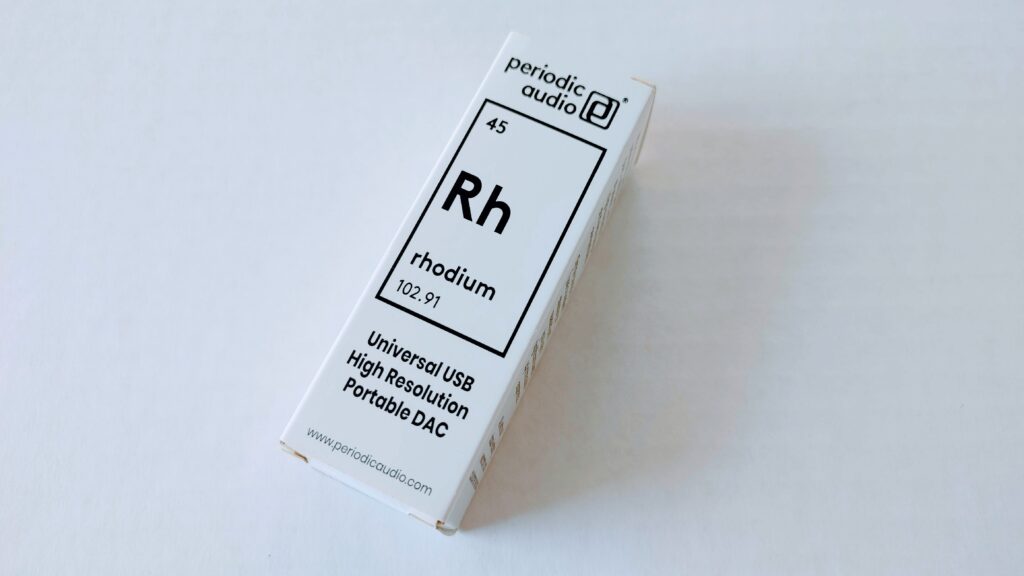
That’s where Periodic Audio’s latest product, the Rhodium DAC, comes in. It’s a USB DAC/headphone amp capable of high-res 32bit/384kHz PCM decoding, as well as 30 mW power output (or 1Vrms) into 32 Ohms.
It’s not advertised, but word on the street is they are using a Realtek DAC/Amp chip. As usual, Periodic shows their work by posting measurement charts on the website.
There's no MQA, and I wouldn’t expect it at this price, but the lack of DSD decoding is a bummer.
The Rhodium is a very slim dongle with USB-C on one end and a 3.5mm headphone jack on the other. It’s quite similar in size to the dongles that are included with many smartphones today.
That’s by design, as Periodic wanted it to conform to their “mobile-first” ethos, meaning it should be well suited for use on the go. They definitely got that right, as it is the perfect length and width to stay out of the way as you walk around.
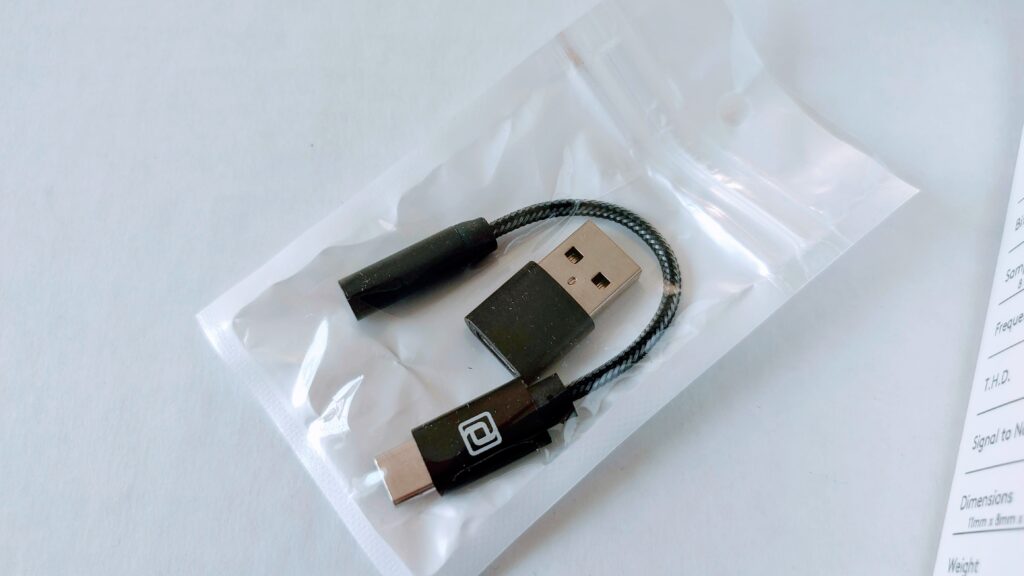
The stiff braided cable also keeps it from flopping all over the place, which I like a lot.
However, that compact size does come at a cost. That’s because, at 30mw, Rhodium is not the most powerful dongle style DAC/amp out there. Some around the same price have double the output power, but they are larger and more cumbersome to use.
Since Rhodium is primarily intended for use with sensitive earphones (the type Periodic sells), they prioritize sound quality over class-leading power output.
They claim their high-quality oscillators and specially selected capacitors provide superior performance to the dongles included with smartphones.
Even though this DAC/Amp is mainly intended for mobile use, it comes with a USB-C to USB-A adapter, which makes it also suited for use with laptops.
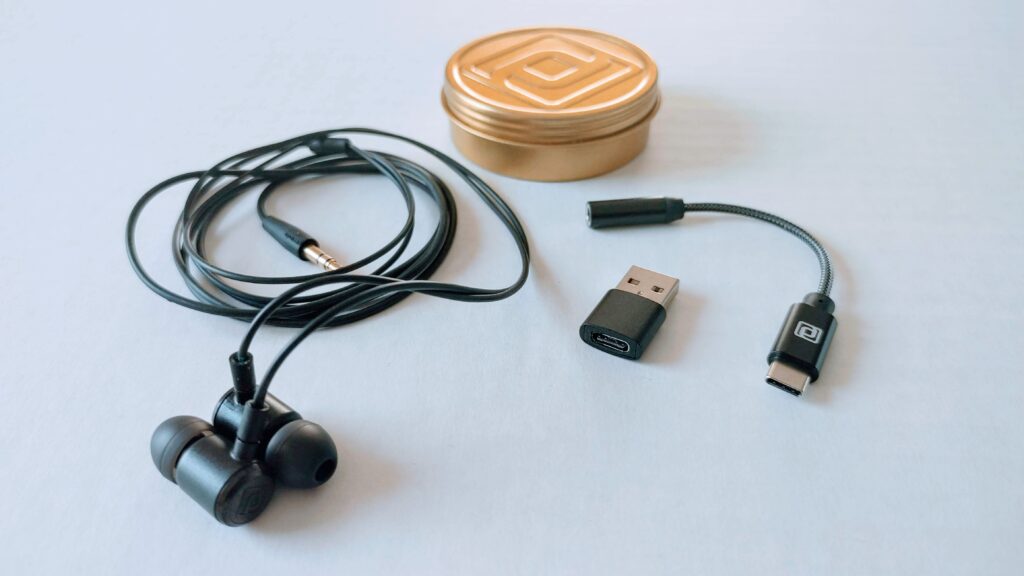
While it won’t give you too much of a power upgrade, it should give you a little upgrade in sound quality over the laptop sound card.
Listening To The Periodic Audio Rhodium Dac Amp
For my testing, I started with the Rhodium and the Periodic Audio Carbon IEM($399, sold sep.) connected to my Moto G Power test phone. I played hi-res files from Qobuz via the UAPP (USB Audio Player Pro) app.
In terms of sound quality, I have to say I liked the Rhodium quite a bit. I’m really sensitive to edgy-sounding dacs, and unfortunately, many manufacturers boost the treble on budget gear to create some “detail.”
I’m happy to say that wasn’t the case here, as the Rhodium had a smooth treble but not so smooth as to blunt all the air present in the recording. The mids were natural and sweet, nicely presenting the texture of strings and other instruments. The Bass was deep and controlled the way I like it.
The extension was a little rolled off on either end of the audioband, but not overly so. It actually gave this DAC/Amp an organic “tubey” sound which was pretty nice. If you like a whole lot of sparkle up top, you may find the Rhodium to be a little dull.

As far as separation and layering are concerned, this DAC Amp combo did a good job, especially for the price point.
I listened to the new 24/192 Christian McBride EP, “The Q Sessions” on Qobuz, and I was delighted at how it was able to play the songs with depth.
I was able to hear the instruments somewhat in their own little bubbles and certain instruments layered behind the others. It’s amazing what these little chip DACs can achieve today.
Of course, the Rhodium will not give you the detail or separation of some of the $100-$200 models out there, but at $50, it makes a nice little upgrade for the USB-C to 3.5mm dongles that come with phones nowadays.
As far as power is concerned, like I said earlier, Rhodium’s power output was on the low side. It drove high-sensitivity Over-Ear headphones like the Focal Elear, but I had to turn the volume in UAPP up to about 80% of maximum.
Even at 80% volume, it drove the Elear with full dynamics, and the sound quality was good. So you can use Rhodium with some full-size headphones in a pinch, but you won’t have a lot of headroom.
The Wrap Up
The Periodic Audio Rhodium is a nice DAC Amp combo for those looking to upgrade the sound coming from their smartphone, especially if you’re doing a combo with the Periodic IEMs. It's perfect for that.
I like the lightweight, sleek build, as well as the natural, relatively detailed sound. I just wish it had a little more juice for full-sized headphones.
This review was originally posted at https://hifitrends.com/
Last edited:
cash1489
Thanks for the Edit, I meant to say Carbon!! LOL
HiFlight
The Periodic Audio Carbon + Nickel combo is my favorite combo for delivering superb quality audio in a tiny package! This in addition to outstanding customer service and a 5 year warranty on all their products (which are all made in the USA).
cash1489
New Head-Fier
Pros: Awesome Build Quality
Comfortable Fit
Exquisite Balanced Sound
Comfortable Fit
Exquisite Balanced Sound
Cons: Slightly Recessed Midrange
Giving You The Low Down On The Best True Wireless Earbuds Under $200!
About a year and a half ago, UK-based Cambridge Audio introduced its first True Wireless Earbuds, the Melomania 1. They are still amongst the best TWS earphones under $100, as chronicled in our story, “Best Buys: Our Picks For The Best Wireless Earbuds Under $100!”
As we said in that post, the Melomania 1 offers a substantial amount of detail and musicality for the price, and they’re comfortable to boot.
However, they miss some of the latest features offered in True Wireless Buds, including touch control, app control, and upgraded amp sections, as seen in the latest earphones from Grado and Hifiman.
Well, Enter the Melomania Touch, Cambridge Audio’s upgrade to the Melomania 1, and it’s a rather appealing package. Like the Aforementioned Grado and Hifiman earphones, they offer audiophile-grade amp circuits, along with some contemporary touches they lack, like an app that lets you adjust EQ amongst other things, and battery life amongst the best on the market.
Cambridge Audio also manages to offer this flagship model for $149.95, which is lower than all the other premium buds on the market. The others range between $200 and $300, and while some have active noise canceling, several, including the Grado and Hifiman, do not. The Melomania Touch doesn’t have ANC either, but it does offer a “transparency mode,” which allows you to hear outside sound without taking the earbud out of your ear.
To me, all these features wouldn’t mean much if they didn’t have above-average sound quality, and I’m happy to say that they do. They also have a sleek design and comfortable fit, making them a clear-cut choice for those looking for a top-end Wireless Earbud without a top-end price. Read on for more detail on these remarkable new earphones.
Disclaimer: The Melomania Touch was sent to us as a sample in exchange for an honest, unbiased review.
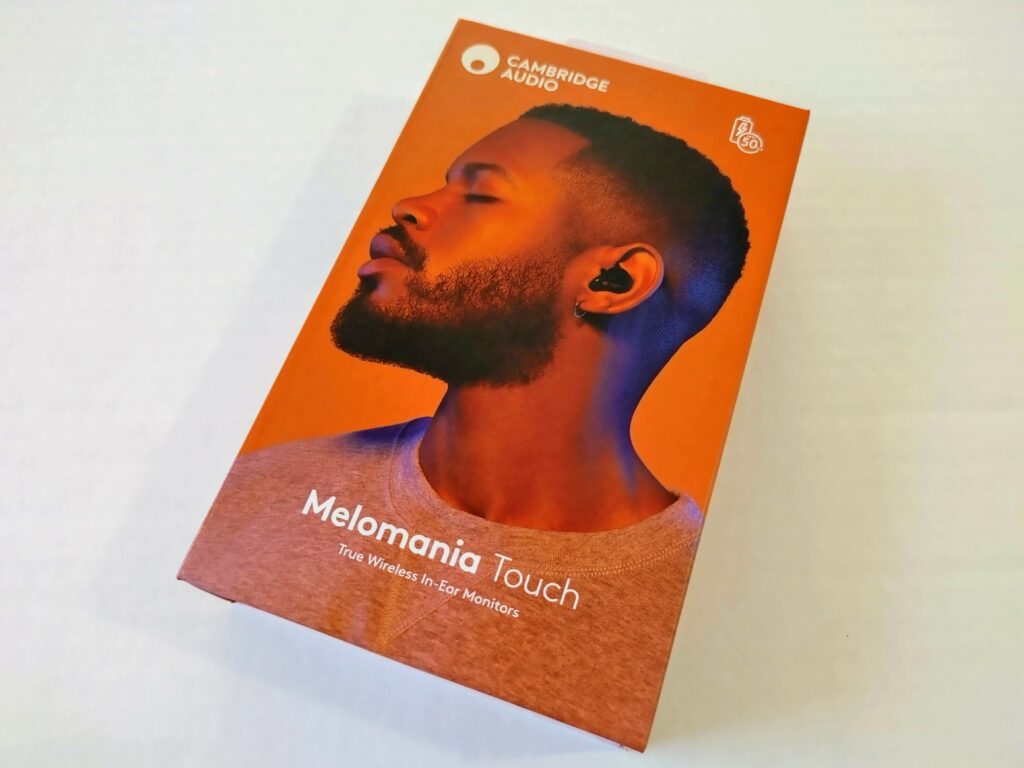
Build and Features
When it comes to build quality, the Melomania Touch is top-notch. Both the earpieces and case have a sophisticated look without being too flashy. The lightweight earpieces (6g) are made of a glossy polycarbonate, which adds visual interest, and the compact charging case is covered in textured protein leather, which gives it a luxury look and feel.
As the name suggests, each wireless earbud has a touch control surface that controls music playback, handsfree calling, volume, virtual assistants (Siri or Google Assistant), and the Transparency Mode mentioned above.
As I’ve said in the past, I’m somewhat dubious about touch controls on earphones because, in the past, they have been hit or miss. However, recently I’ve found that more and more manufacturers are getting them right, and the Melomania Touch is another example. The controls on these earphones are intuitive and responsive, which made me happy since I hate tapping incessantly on an earbud to make it do what I want it to do.
Inside the earphones is one 7mm graphene-coated driver per side. The graphene allows the drivers to be both very stiff and lightweight. That allows the Melomania Touch to reproduce music with exceptional depth and clarity. Wireless connectivity is handled via Bluetooth 5.0, which provides signal stability and is pretty much the norm nowadays.
This BT 5.0 implementation incorporates the AAC and apt-X audio codecs, which means you should get close to CD-quality sound from both Apple and Android devices. No apt-X HD or apt-X LL compatibility.
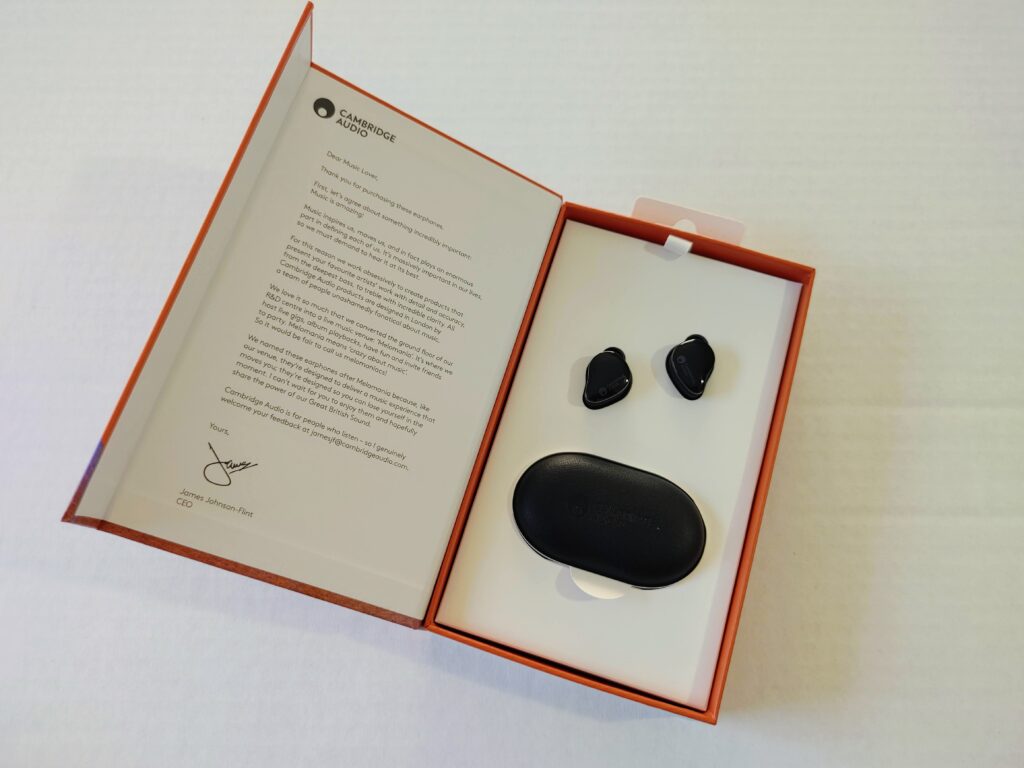
However, they are compatible with Qualcomm’s TrueWireless Stereo Plus technology, which means even more stable connections, even better battery life, and lower latency connections if you have a phone with a compatible Qualcomm Snapdragon SoC (845, 855, 865). This is because the phone can connect to each bud directly instead of one at a time like other models. This means the buds don’t have to pair to each other across your head.
My LG V60 has the Snapdragon 865, and I did notice the benefits of low latency when watching videos. The video and audio were almost perfectly in sync, much better than I’ve noticed with other TWS earphones (especially without apt-X LL).
IPX4 sweat and water resistance make these earbuds good for exercise, provided you have the correct size silicone ear tips and fins (which fit into the upper folds of your ear) installed. They will help the earpiece stay in your ear while you are moving around. The proper fit will also give you the best sound quality. A card included in the package gives instructions on getting a proper fit.
That’s not to say it’s hard to get a good fit. Once you find the right size tip and fin (several of each are in the box), all you have to do is give the buds a light press into your ear, and they should seal properly. Once I got the right seal, I found the overall fit to be quite comfortable.
They almost seemed to have a custom fit, a testament to the sleek, sculpted shape of the earpieces. They fit like a good set of wired IEMs. Cambridge Audio says they used data points from over 3000 pairs of ears to get the right shape, and I feel like they are spot on.
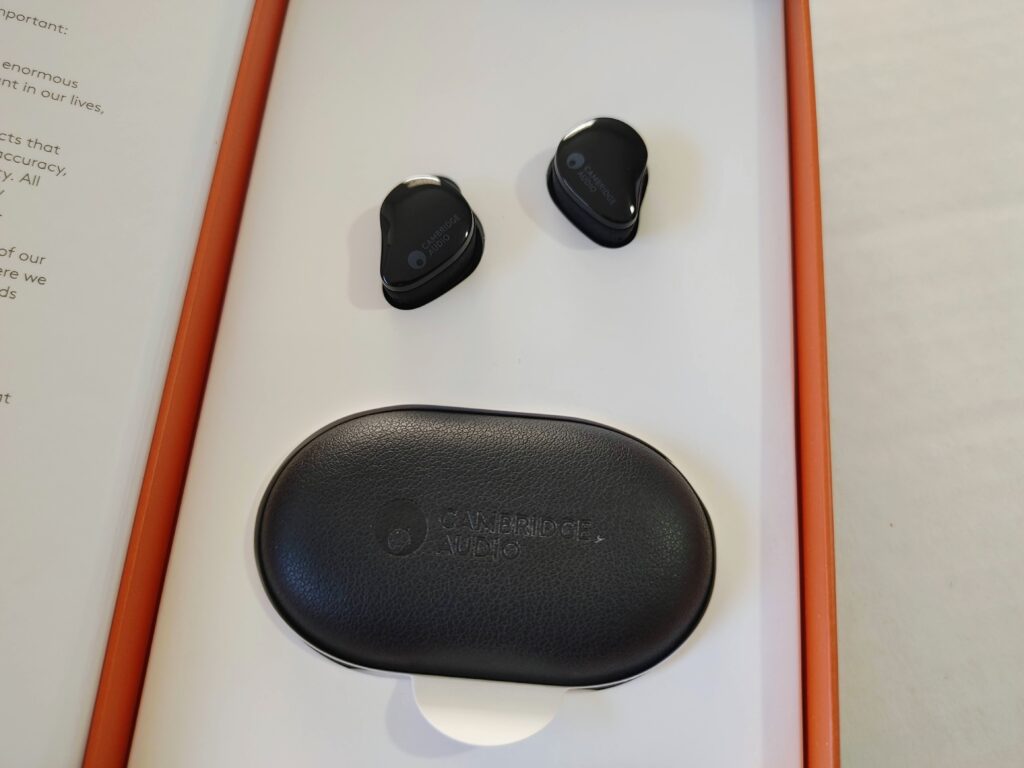
The Melomania Touch gives you about 6-7 hours of playback time depending on the volume level, which is really good. You can actually squeeze a little more out of them by selecting the “Low Power” mode in the companion app. More on that later.
The charging case gives you about three or four more charges before you have to plug the case in, and it’s compatible with USB-C fast charging, so you can top it off in about an hour or so.
Using the Melomania App
One of the standout features of the Melomania Touch is the new Melomania App. This companion app has Android and iOS versions, and I had a chance to try out the Android release.
I found the app to be really well designed, and it picked up the buds right away (they must be paired to the phone first). The first thing the app did was an over the air firmware update for each earbud, which I thought was pretty cool. It’s nice to know that the manufacturer could easily update the features of your product in the future if need be.
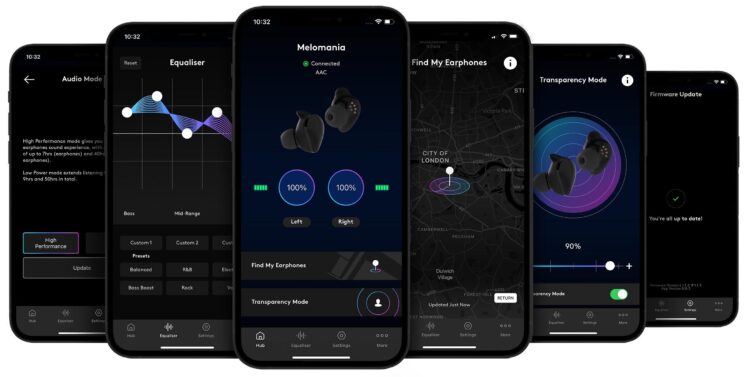
The app's home screen shows separate battery life for each of the earphones, connection status, and BT Codec, plus there’s a button to activate the Transparency Mode. There’s also a “Find My Earphones” button so you can see the last location your earbuds were used on a map.
The App also has an Equalizer page where you can pick from one of six preset EQs like “Bass Boost,” “Rock,” “Voice,” etc. You can also save up to three custom EQ settings.

The “Settings” page gives you several ways to customize your earphones, like an option for toggling the different Earphone controls on or off or another option for selecting the Bluetooth Codec you wish to use. This is useful if you have a phone like mine compatible with both AAC and apt-X since it lets you lock your phone to the codec you prefer.
You can also select a language for the voice prompts you hear as you operate the earbuds. I left mine in English, but you can select from seven other languages, including Chinese, German, or Italian. You can also initiate firmware updates from the Settings page if the auto-update doesn’t work.
As I said earlier, the app also lets you select between the default “High-Performance” (read: audiophile) setting, which gives you the best sound quality, or a “Low Power” mode that gives up some sound quality to extend the battery life. The difference is about two extra hours of playback.
There’s also a “More” page with some handy stuff, like an in-app User Guide, plus links to Online Product Registration or Tech Support.
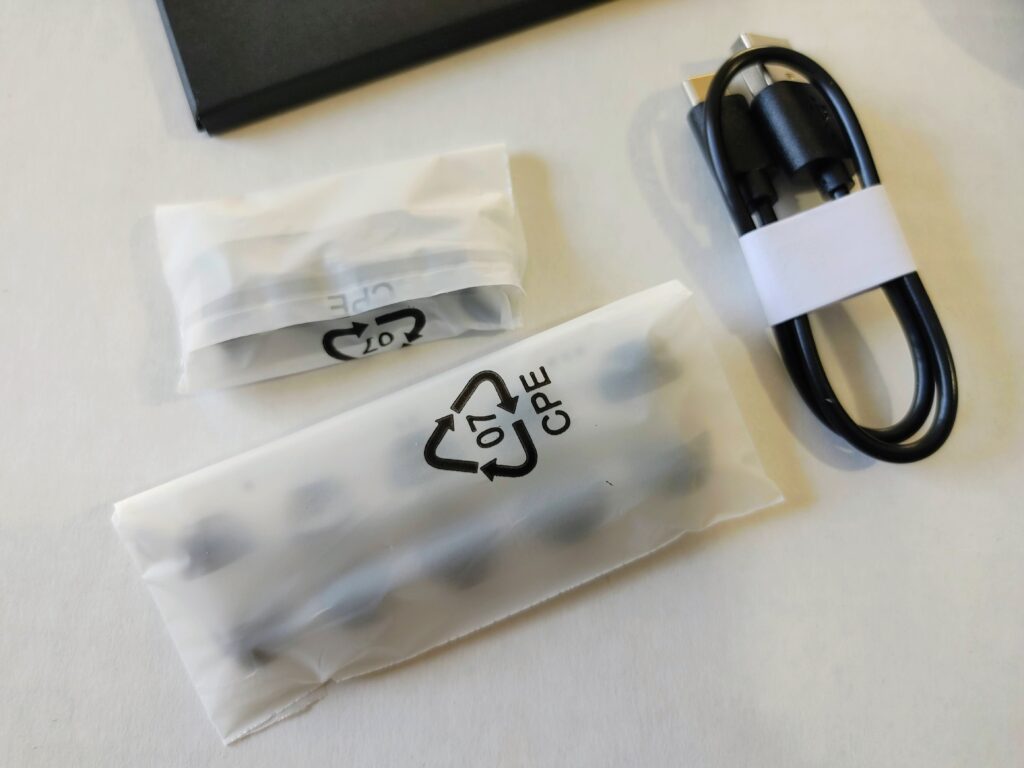
Listening To The Melomania Touch
For my sound test, I connected the Melomania Touch to my LG V60 smartphone, a phone compatible with just about every audio codec out there. In this case, the connection defaulted to apt-X, which I prefer over AAC on an Android device. I played a wide variety of music, both from the hi-res local files and tracks streamed from TIDAL.
Overall the Melomania Touch, just like other wireless earphones designed for audiophiles (think: Grado GT220 or Hifiman TWS800), comes with a balanced tuning (think: flat) out of the box. This is confirmed by connecting the buds to the Melomania app and pulling up the Equalizer page, where you can see the “Balanced” EQ is preselected.
In this setting, clarity is the order of the day, with no part of the audio spectrum really boosted over the other. If anything, there’s a slight bump in the upper bass, which adds that bit of excitement that Cambridge Audio gear is known for.
Listening to “Baker Street” from the Chesky Records recording “The World’s Greatest Audiophile Vocal Recordings Vol. 2” allows you to hear what the Melomania Touch has to offer, starting with the sweet highs. They provide detail without excessive sparkle, which to me is the hallmark of a refined headphone. Some may say they are a little rolled off at the very top, but I think it’s almost perfect.
If there’s a weakness in the Melomania Touch’s presentation, it may be the midrange. While the mids are equally as sweet as the highs, they are a little recessed, which takes away from the realism and openness. That’s said, there is still a good amount of air and depth, which separates this Wireless earbud from the run of the mill models out there.
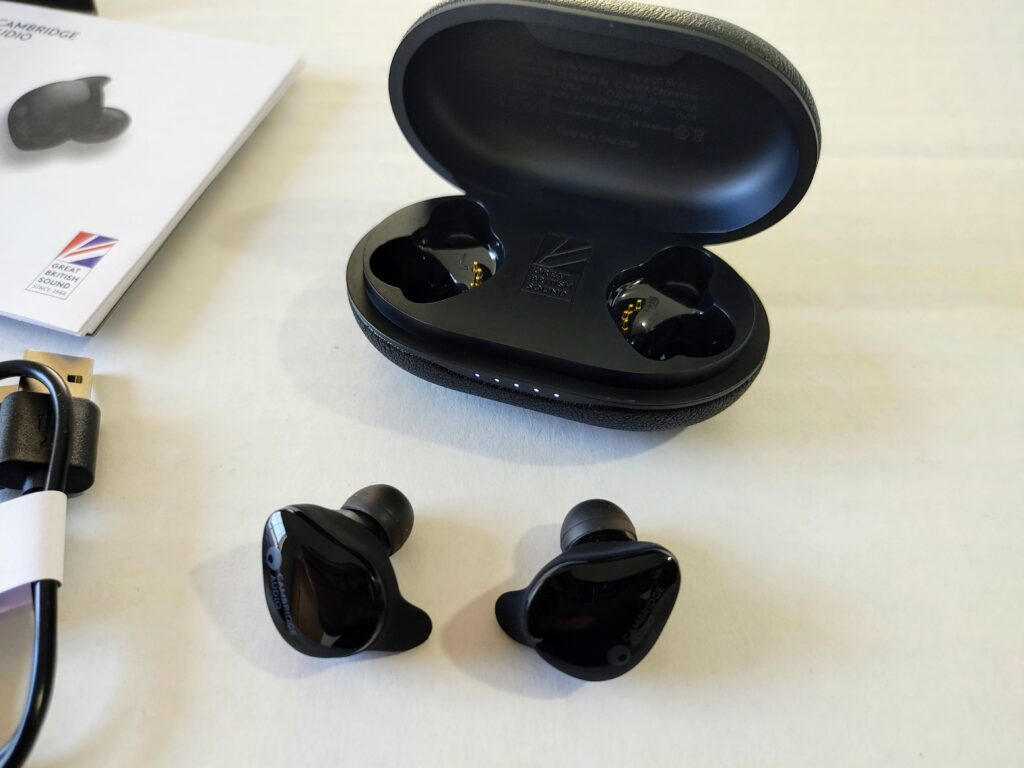
As I said earlier, it is pretty flat out of the box regarding the low end, which means you don’t get a lot of thump on bass-heavy tracks. However, for songs like “Baker Street,” where excessive thump would be distracting, the bass is just right. It’s articulate and gives the right amount of weight, which I like on my IEMs.
If you do want a little more thump on a certain song, it’s easy to get. All you have to do is select the “bass boost” EQ setting in the Melomania app, and you quickly get some additional low-end that’s elevated without being sloppy. Very nice.
Compared to the Hifiman TWS800
I compared the Melomania Touch’s sound to Hifiman’s TWS800, which I consider to be the best sounding TWS earphones on the market right now, and I gave the Hifiman the edge. Their sound was just a little more detailed and rich, especially through the mids, which gave them a more natural sound.
But the Cambridge Audio buds weren’t far behind, especially when you consider they cost half the price and have more convenience features. I would say they give you about 90 percent of the Hifiman’s sound quality. They are also more comfortable than the TWS800.
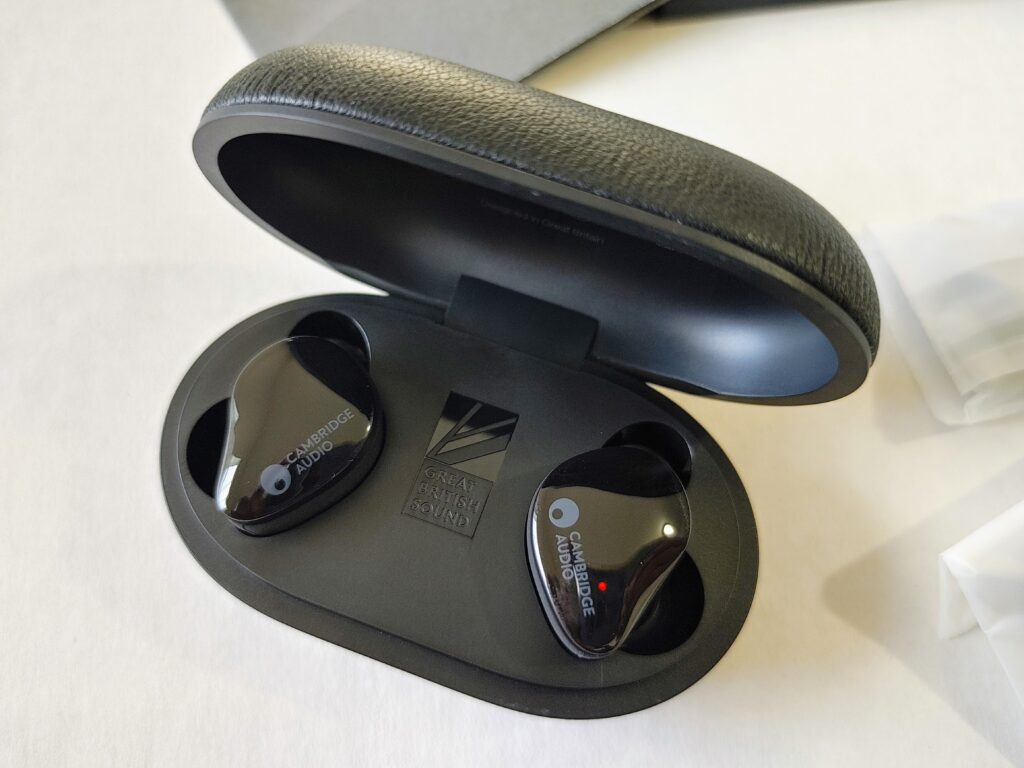
Compared to the Grado GT220
When I compared the Melomania Touch to Grado’s audiophile TWS earphones, it was a more even match soundwise. The GT220 was a little more aggressive on the high end, which may please those looking for some extra sparkle, but to me, I liked the Cambridge Audio’s mellow highs better. The Grado was the winner throughout the mids, with a more natural midrange that made vocals really come alive. They may have the best vocals of any wireless earphone I’ve heard. The bass reproduction was pretty much even. The Melomania Touch wins the comfort battle.
 The Wrap Up
The Wrap UpWhen it comes to Wireless IEMs, which is the term I’ve come up with for Wireless Earbuds designed for audiophiles, the Melomania Touch is an excellent package. Cambridge did a great job of balancing comfort, top-notch sound, and creature comforts (like the well-designed app and excellent fit). They also managed to offer them at a very attractive price. If you're looking for above-average sound at a good price, and don’t need ANC, then the $149 Melomania Touch is a good pick.
Where to Buy
Cambridge Audio Melomania Touch Earbuds
AMAZON
$149.95
This review was originally posted at hifitrends.com
Last edited by a moderator:
cash1489
New Head-Fier
Pros: Great Build Quality
Crisp, Natural Sound
Easy to Use
Crisp, Natural Sound
Easy to Use
Cons: Sound lacks a little depth and width
Helm Audio has been on a tear lately, producing an uninterrupted run of innovative portable audio gear for the last two years. They constantly seem to get the features/performance/price mix of their products right, making them attractive. A couple of months back, I took a look at their $199 HELM Audio DB12 AAAMP Mobile Headphone Amp, an analog-only portable amplifier that was one of the most powerful and transparent I’ve ever heard.
This time, I’m looking at their $99 BOLT DAC/Amp, an MQA compatible dongle DAC with THX-Certifed headphone amp section. It has a clean, balanced sound like the DB12, albeit not quite as clean or as powerful.
That said, comparing the two is really comparing apples to oranges because they are basically two different things. The DB12 AAAMP is an analog-only device made to provide additional output power to devices that already sound good, like a DAP with low output power. On the other hand, the BOLT is made to improve the sound of devices with inferior DACs, like many smartphones.
It can also be used as a high-quality dongle to add a headphone jack to phones that don’t have one, provided the phone has a USB-C connector. With popular phone manufacturers like Samsung removing the 3.5mm jack from their Galaxy phones, dongle DACs, which are basically an adapter wire with amp/DAC chips built-in, have become more ubiquitous, with more and more models popping up on the internet.
DAC/Amp dongles are a relatively cheap way to both allow the use of standard headphones with smartphones and improve their sound quality at the same time. They also work well with laptops. Due to their compact size, they’re effortless to transport.
I’ve had the chance to try out many of them, including the Zorloo Ztella, which I found to be a powerful little DAC/Amp for its size. It also has a detailed, open sound, which brings headphones alive. The only issue is that it tends to be bright on certain recordings, so careful headphone matching is necessary.
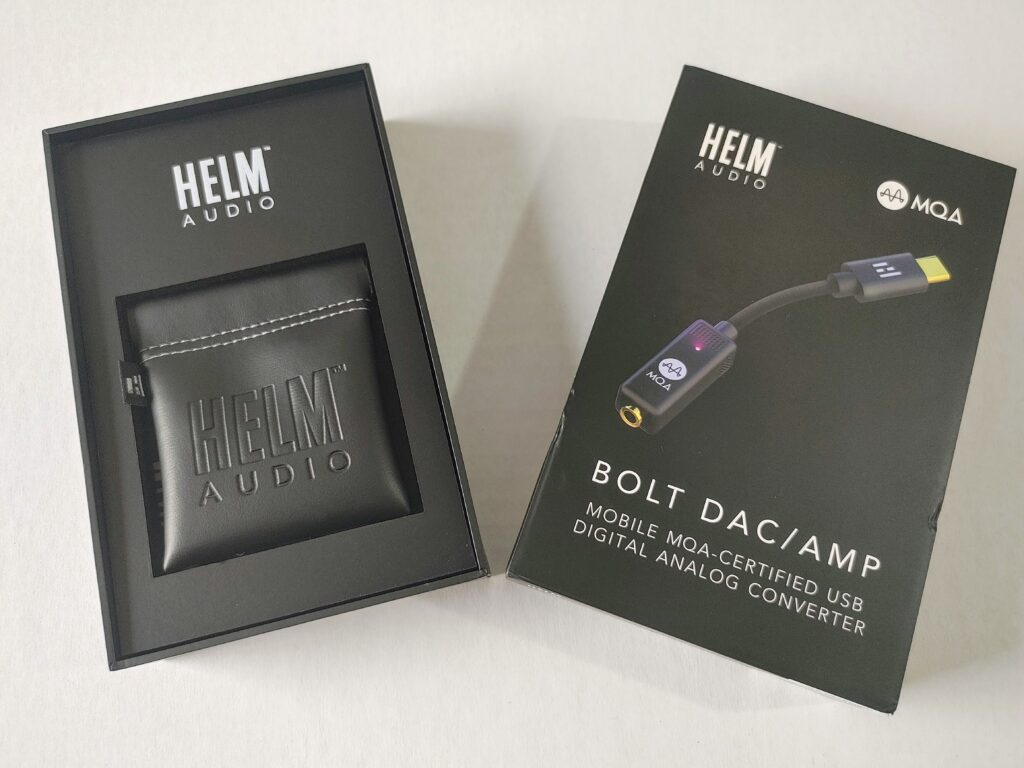
The BOLT and Ztella have identical specs and sound signatures, and while HELM Audio is tight-lipped regarding the DAC chip they use, I wouldn’t be surprised if it used the same ESS Sabre chip as the Zorloo product. That said, it’s the implementation of the chip that makes all the difference, which is why some manufacturers don’t like to disclose the exact one they are using.
At the end of the day, I found the BOLT to be a little less lively on the top-end than the Ztella, which may make it a better choice for those who are sensitive to treble. The BOLT also sounded more “real” (instruments, vocals) and richer than the Zorloo DAC. However, the Ztella’s boost on the top end does give it a more airy sound than the BOLT, and it also has a wider soundstage. They’re both great choices at $99, so your decision will probably come down to sound preference.
Other things worth mentioning are the BOLT comes with a pleather pouch for carrying, something the Ztella doesn’t have. Another thing to keep in mind is for an additional $10, the Zorloo can be purchased with a lightning adapter for Apple phones. The BOLT needs a $30 Lightning to USB Camera Adapter from Apple to work with iPhones.
Build/Features
The BOLT DAC/Amp looks to have a pretty sturdy build. It’s composed of Aluminium and soft-touch plastic, with a braided tangle-resistant cord. It’s super small, at less than four inches long, and only weighs about a quarter ounce.
Like I said earlier, it comes with a small pleather pouch for easy carry, and it also comes with an impossibly small USB-C to USB-A adapter for use with laptops. I used both with my HP Envy, and with either option, it was plug and play.
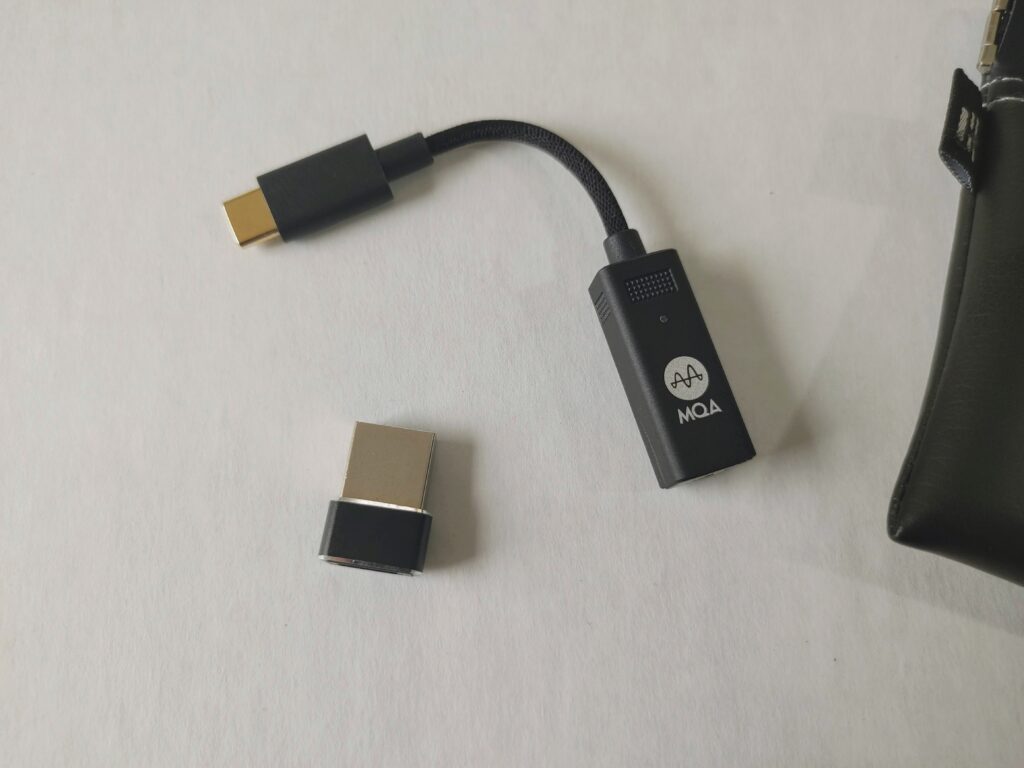
MQA compatibility comes standard, and there’s a small LED light that glows magenta when it renders an MQA track. The same LED also designates the sample rate. RED means above 48khz, and Blue means below 48khz.
Besides MQA, the BOLT also does PCM up to 384kHz, and DoP (DSD over PCM) up to 5.6MHz.
As far as output power is concerned, it uses an impedance matching scheme to match different headphones/earphones. That means it outputs 1V for headphones with impedances less than 150 ohms or 2V for impedances equal to or greater than 150 ohms. I wouldn’t recommend using the BOLT with a sensitivity rating much less than 100 dB /mW, or you may get mushy bass and restrained dynamics.
I really enjoyed the BOLT with the Andover Audio PM50 Planar Magnetic headphones (102 dB/mW), the Focal Elear (104db/mW), and the Sennheiser x DROP HD58X (104db/mW). The Hifiman SUNDARA at 94db/mW was a little too much.
THX Certification is the icing on the cake here, meaning the BOLT has to meet stringent standards for low-distortion.
Listening to the HELM Audio BOLT
For my sound test, I used the BOLT mainly with the Focal Elear headphone and a Moto G Fast Android phone with USB Audio Player PRO app installed. I listened to both TIDAL and local files thru UAPP, mostly hi-res.
Just a side note: I tried listening directly from the TIDAL Android app, but it wouldn’t play through the BOLT. This wasn’t fully unexpected, as many DAC/Amps don’t work with the TIDAL Android app. The only ones I’ve been able to use so far are the iFi DACs. It does work with the TIDAL desktop app on Windows 10. I didn’t try iOS.
If I had to sum up the BOLT’s sound with one word, it would be natural. While the lower highs are a little elevated, they are not bright per se. They actually add a nice level of clarity to the sound without being harsh. The upper mids also seem to have a slight boost, which gives percussion and vocals a nice full, realistic texture. The Bass seems pretty flat, just giving you the warmth the track needs.
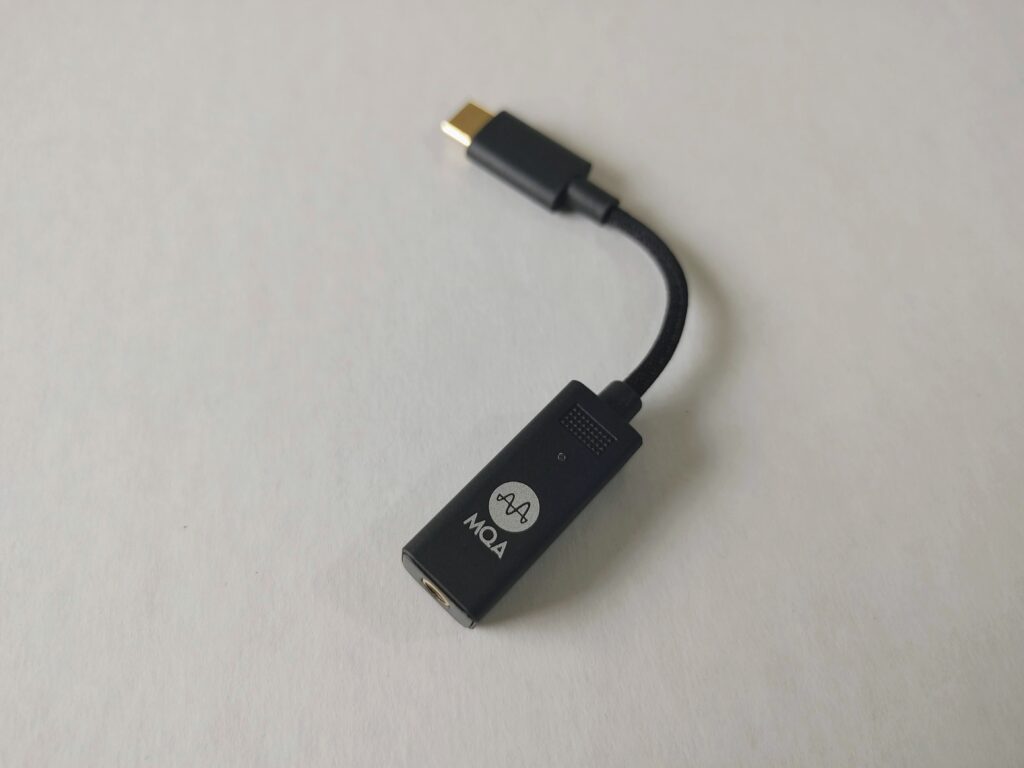
Listening to “Midnight” by Khruangbin and Leon Bridges, I again impressed at how natural Bridges vocal was along with the drum hits. I didn't get the separation or depth you would get with a more expensive DAC like the Audioquest Dragonfly Cobalt, but there was enough space and focus to hear the vocal front and center with the drummer behind him to the left. The guitar was panned off to the right.
The soundstage is a little narrow. The presentation was just out beyond my ears when I listened to Emily King’s Acoustic version of her song “Forgiveness.” However, I just loved the richness of the strings and Emily’s sweet vocal. This DAC really brings singers and instruments to life, with a clean, laid back sound that you can listen to for hours on end. This may be the cleanest sounding DAC I’ve heard at $99.

The Wrap Up
HELM Audio’s BOLT DAC/Amp is another great option for a dongle DAC/Amp at the $99 price point. Especially if you’re looking for MQA. The Zorloo Ztella may have a little bit more air and top-end detail, but it’s also a little bit bright with some songs and a little bit noisier than the BOLT. This makes it my new DAC recommendation for under $100. If you’re looking for a cheap compact device to improve the sound of your phone or laptop or just a USB-C adapter with a 3.5mm headphone jack, the BOLT is where it’s at.
This review was originally published at hifitrends.com
This time, I’m looking at their $99 BOLT DAC/Amp, an MQA compatible dongle DAC with THX-Certifed headphone amp section. It has a clean, balanced sound like the DB12, albeit not quite as clean or as powerful.
That said, comparing the two is really comparing apples to oranges because they are basically two different things. The DB12 AAAMP is an analog-only device made to provide additional output power to devices that already sound good, like a DAP with low output power. On the other hand, the BOLT is made to improve the sound of devices with inferior DACs, like many smartphones.
It can also be used as a high-quality dongle to add a headphone jack to phones that don’t have one, provided the phone has a USB-C connector. With popular phone manufacturers like Samsung removing the 3.5mm jack from their Galaxy phones, dongle DACs, which are basically an adapter wire with amp/DAC chips built-in, have become more ubiquitous, with more and more models popping up on the internet.
DAC/Amp dongles are a relatively cheap way to both allow the use of standard headphones with smartphones and improve their sound quality at the same time. They also work well with laptops. Due to their compact size, they’re effortless to transport.
I’ve had the chance to try out many of them, including the Zorloo Ztella, which I found to be a powerful little DAC/Amp for its size. It also has a detailed, open sound, which brings headphones alive. The only issue is that it tends to be bright on certain recordings, so careful headphone matching is necessary.

The BOLT and Ztella have identical specs and sound signatures, and while HELM Audio is tight-lipped regarding the DAC chip they use, I wouldn’t be surprised if it used the same ESS Sabre chip as the Zorloo product. That said, it’s the implementation of the chip that makes all the difference, which is why some manufacturers don’t like to disclose the exact one they are using.
At the end of the day, I found the BOLT to be a little less lively on the top-end than the Ztella, which may make it a better choice for those who are sensitive to treble. The BOLT also sounded more “real” (instruments, vocals) and richer than the Zorloo DAC. However, the Ztella’s boost on the top end does give it a more airy sound than the BOLT, and it also has a wider soundstage. They’re both great choices at $99, so your decision will probably come down to sound preference.
Other things worth mentioning are the BOLT comes with a pleather pouch for carrying, something the Ztella doesn’t have. Another thing to keep in mind is for an additional $10, the Zorloo can be purchased with a lightning adapter for Apple phones. The BOLT needs a $30 Lightning to USB Camera Adapter from Apple to work with iPhones.
Build/Features
The BOLT DAC/Amp looks to have a pretty sturdy build. It’s composed of Aluminium and soft-touch plastic, with a braided tangle-resistant cord. It’s super small, at less than four inches long, and only weighs about a quarter ounce.
Like I said earlier, it comes with a small pleather pouch for easy carry, and it also comes with an impossibly small USB-C to USB-A adapter for use with laptops. I used both with my HP Envy, and with either option, it was plug and play.

MQA compatibility comes standard, and there’s a small LED light that glows magenta when it renders an MQA track. The same LED also designates the sample rate. RED means above 48khz, and Blue means below 48khz.
Besides MQA, the BOLT also does PCM up to 384kHz, and DoP (DSD over PCM) up to 5.6MHz.
As far as output power is concerned, it uses an impedance matching scheme to match different headphones/earphones. That means it outputs 1V for headphones with impedances less than 150 ohms or 2V for impedances equal to or greater than 150 ohms. I wouldn’t recommend using the BOLT with a sensitivity rating much less than 100 dB /mW, or you may get mushy bass and restrained dynamics.
I really enjoyed the BOLT with the Andover Audio PM50 Planar Magnetic headphones (102 dB/mW), the Focal Elear (104db/mW), and the Sennheiser x DROP HD58X (104db/mW). The Hifiman SUNDARA at 94db/mW was a little too much.
THX Certification is the icing on the cake here, meaning the BOLT has to meet stringent standards for low-distortion.
Listening to the HELM Audio BOLT
For my sound test, I used the BOLT mainly with the Focal Elear headphone and a Moto G Fast Android phone with USB Audio Player PRO app installed. I listened to both TIDAL and local files thru UAPP, mostly hi-res.
Just a side note: I tried listening directly from the TIDAL Android app, but it wouldn’t play through the BOLT. This wasn’t fully unexpected, as many DAC/Amps don’t work with the TIDAL Android app. The only ones I’ve been able to use so far are the iFi DACs. It does work with the TIDAL desktop app on Windows 10. I didn’t try iOS.
If I had to sum up the BOLT’s sound with one word, it would be natural. While the lower highs are a little elevated, they are not bright per se. They actually add a nice level of clarity to the sound without being harsh. The upper mids also seem to have a slight boost, which gives percussion and vocals a nice full, realistic texture. The Bass seems pretty flat, just giving you the warmth the track needs.

Listening to “Midnight” by Khruangbin and Leon Bridges, I again impressed at how natural Bridges vocal was along with the drum hits. I didn't get the separation or depth you would get with a more expensive DAC like the Audioquest Dragonfly Cobalt, but there was enough space and focus to hear the vocal front and center with the drummer behind him to the left. The guitar was panned off to the right.
The soundstage is a little narrow. The presentation was just out beyond my ears when I listened to Emily King’s Acoustic version of her song “Forgiveness.” However, I just loved the richness of the strings and Emily’s sweet vocal. This DAC really brings singers and instruments to life, with a clean, laid back sound that you can listen to for hours on end. This may be the cleanest sounding DAC I’ve heard at $99.

The Wrap Up
HELM Audio’s BOLT DAC/Amp is another great option for a dongle DAC/Amp at the $99 price point. Especially if you’re looking for MQA. The Zorloo Ztella may have a little bit more air and top-end detail, but it’s also a little bit bright with some songs and a little bit noisier than the BOLT. This makes it my new DAC recommendation for under $100. If you’re looking for a cheap compact device to improve the sound of your phone or laptop or just a USB-C adapter with a 3.5mm headphone jack, the BOLT is where it’s at.
This review was originally published at hifitrends.com
Last edited by a moderator:
cash1489
New Head-Fier
Pros: Beautiful Design
Great Balanced Sound
Powerful Headphone Amp
Great Balanced Sound
Powerful Headphone Amp
Cons: Top end a little edgy on some songs
USB Dac limited to 16/48
USB Dac limited to 16/48
Remarkable Wireless Sound For The Money!
It wasn’t long ago, the phrase “Hi-Fi Bluetooth Receiver” would’ve been considered something of an oxymoron. Even a couple of years back, the sound quality of Bluetooth was pretty poor, and most audiophiles would’ve scoffed at the idea of "Hi-Fi Bluetooth."
But in the last year or so, new Bluetooth versions like BT 5.0 along with upgraded BT codecs like LDAC and aptX HD have changed all that. High fidelity Bluetooth connections are now a possibility, and audio manufacturers are coming up with myriad ways to take advantage.
That includes new Bluetooth receivers designed for use with hi-fi rigs, like Shanling’s new BA1 Desktop Hi-Fi Bluetooth Receiver, which is available at retail for $169.
This compact unit (about five inches long and one inch tall) not only outputs high-resolution Bluetooth streams into your stereo system but also doubles as a USB DAC/Headphone amp, which is in contrast to its peers that only do digital or line output.
The BA1 doesn’t just perform these functions, but it does both well, making it an intriguing option for someone looking to play music from their cell phone, laptop, or both. In reality, I may be tempted to call it more of a DAC/Amp with Bluetooth instead of a simple Bluetooth receiver. If you’re interested in finding out more about this versatile device, then read on.
Disclaimer: The BA1 was sent to us by Shanling in exchange for our honest review.
Build/Features
The BA1 is basically a small plastic box with an on/off dipswitch, 3.5mm headphone jack, and screen in the front. There are two digital connections (1 USB-C input, 1 Optical output), plus an RCA line output in the rear. There are no balanced analog or coaxial digital outputs, which means the connections are basic but practical. Even though the build is all plastic, it’s hard plastic with a glossy finish, making this affordable piece of gear look pretty snazzy.
The small LCD screen in the front gives you an indication of the Bluetooth Codec in use (ex. LDAC), along with the Bluetooth connection status or the sampling rate when in USB DAC mode. Even though the screen is tiny, the red on-screen font is sized for decent legibility even several feet away.
Speaking of BT Codecs, the BA1 supports just about every one imaginable, including LDAC, aptX HD, aptX LL, aptX, AAC, and SBC. That means you have access to some of the highest data rates available via Bluetooth, giving you full CD-Quality sound if your device is compatible. Bluetooth 5.0 gives you an extended range (about 130 feet indoors) if you use a BT 5.0 device to send your tunes.
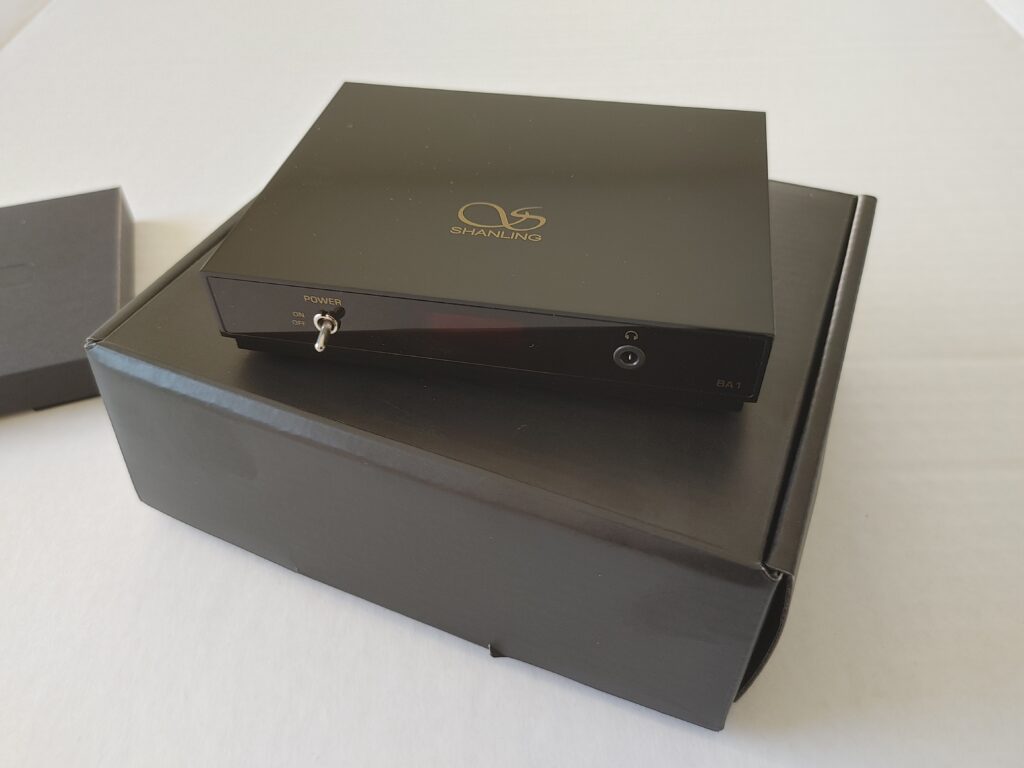
To gain access to all of the BA1’s settings, you need to install the “Shanling Controller” app (Android or iOS) on your phone. The app lets you adjust parameters on the ESS ES9218P DAC/amplifier chip, like selecting digital filters to tweak the sound or adjusting the gain on the headphone output.
The app also lets you set the headphone amp volume when in USB DAC mode, set L/R channel balance, or pick a particular BT codec, just if your phone doesn’t default to the one you prefer. You can also pick an Equalizer setting from six preset selections or set your own custom EQ if you so choose. There’s also a handy online user’s manual.
The BA1 only comes with a Quick Start guide and USB-C power/data cable in the box; no power adapter is included. You can power it up via USB power on your laptop or purchase a standard USB power for use with a power outlet. Like most USB DACs, you can use the unit while it’s getting power from a laptop.
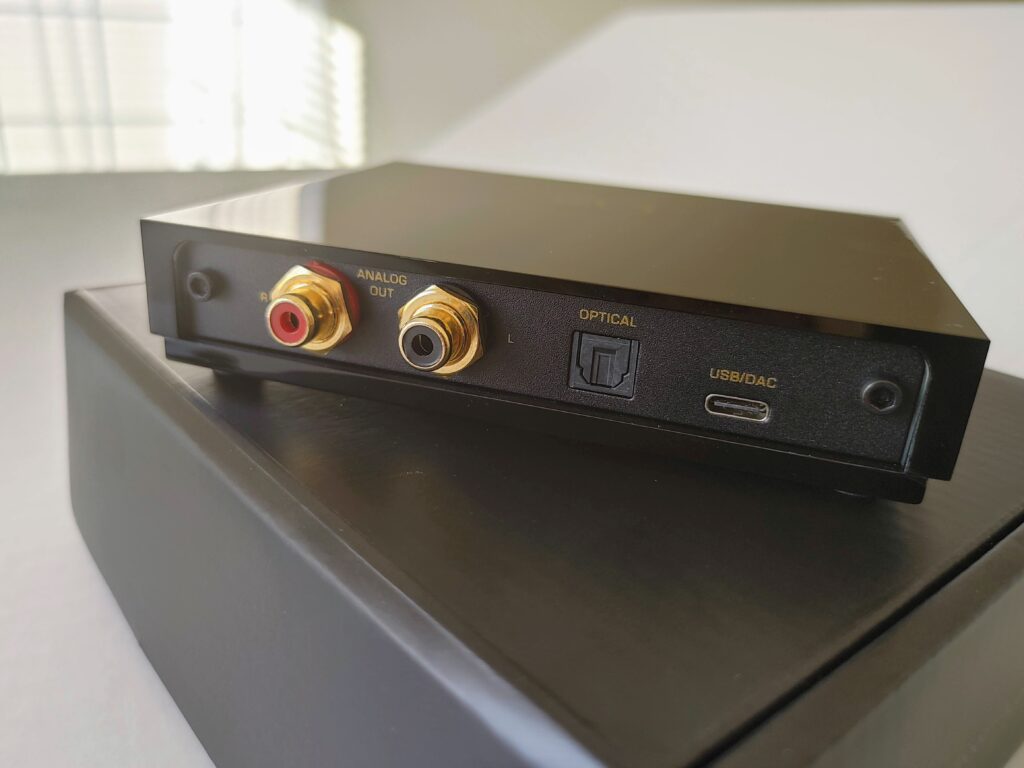
Listening to the Shanling BA1 In USB DAC Mode
I started my listening tests with the BA1 in USB DAC mode, connected to my laptop with the included USB cable. It’s plug and play, meaning the computer should automatically recognize the device and install the proper driver. This is good for those who don’t want to fuss with pesky audio drivers. However, this also means resolution support over USB is limited to 16/48.
I played music from the TIDAL desktop app, and the BA1 registered the sample rate on the front screen. I used the Beyerdynamic T5 3rd Gen ($999) plugged into the 3.5mm headphone jack and noticed right away this little box had more than enough gusto to drive full-sized headphones. This unit is rated at 2V output through the 3.5mm jack, and with the headphone amp set to high-gain (the default), it was actually too loud for the Beyerdynamic headphones (100db at 1mW sensitivity).
I switched to the low-gain setting, which was a better match for those cans, providing a gradual lift to a proper listening level. (tip: if you still find the gain too high on the low gain setting, you can make further adjustments using the “USB Volume” setting in the app.)
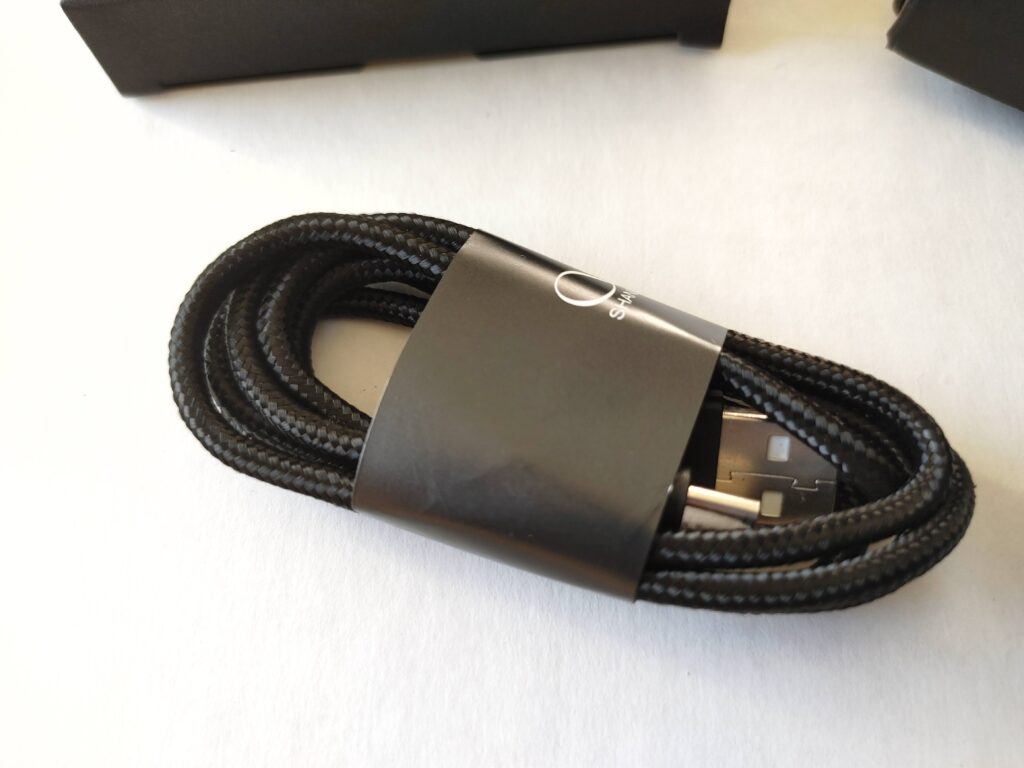
To see how the BA1 did with a less sensitive headphone, I tried it with the Mr. Speakers Aeon Flow Closed (the original version with 93db sensitivity), and it drove them much better than I thought it would. The sound was a tad bit compressed but still very crisp and open. I was missing a little of the punch you would get from a more powerful amp, but it still produced a tight, detailed bottom end without cranking the volume too much.
This was one of the few times I could get satisfactory sound out of the AFC with anything other than a dedicated headphone amp (the very first time with a device under $200). I also had a good result with the higher impedance but similar sensitivity Hifiman Sundara ($349), which wasn’t as resolving, but more dynamic and fuller sounding. I actually liked the Sundara better with the BA1 at the end of the day.
After the two planar headphones, I went back to the T5, which gave me the best combo of resolution and dynamics. Overall, I found the BA1’s sound nicely balanced. However, with certain songs, the top end seemed to be a little too “sparkly,” almost like it was trying too hard to reveal details in the music. If you’re sensitive to treble, then that’s something to think about.
That said, there was some good detail to be had in the lower highs and midrange. Vocals sounded quite clean and natural on the Beyerdynamic, as did strings. I felt the BA1 really allowed the T5 to shine. As the BA1 trends very neutral, Bass is detailed but restrained out of the box. If you want a little more excitement, you can set an EQ, or for finer adjustment, you can select another digital filter.
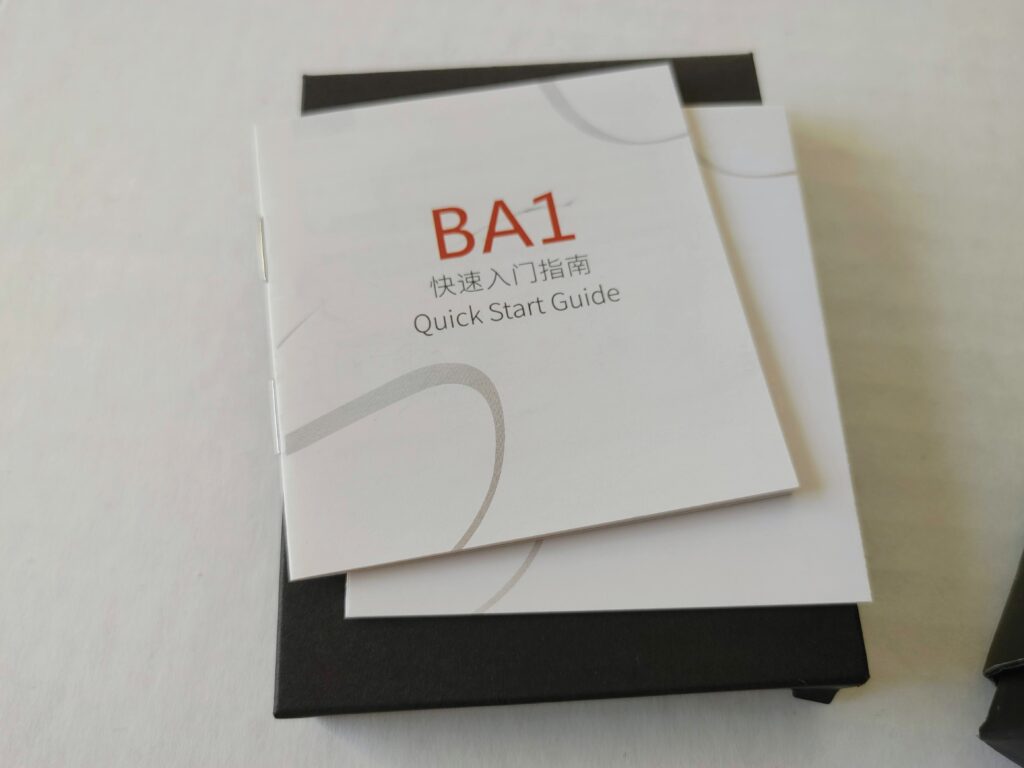
On to Bluetooth!
So after spending a ton of time testing the USB connection, I finally got around to Bluetooth, which is funny since the BA1 is advertised primarily as a wireless device. To test the BT connection, I paired it with Shanling’s M2X Digital Audio Player, which has its own TIDAL app. It also has LDAC compatibility, which I set to the HQ setting (up to 990 kbps) for the highest audio quality. That bitrate put me firmly in the Redbook CD range.
Via wireless, the sound was actually very close to the wired presentation. There was a (very) slight loss of detail, but the music actually sounded a little more open through the midrange, and there was the slightest bit of additional warmth on the bottom end. The highs were actually a little less edgy, which was a good thing.
Next, I connected the BA1 to my hi-fi, an Audiolab 6000A Play integrated connected to a pair of Wharfedale Diamond 11.2 standmount speakers. I first connected the optical output to the 6000A Play’s optical input to hear it through the Audiolab’s DAC. The Audiolab is known for its neutral disposition, a sweet top end, and open midrange, along with well-controlled bass.
The Shanling receiver, with its considerable top-end detail, played nicely with the 6000A Play since it’s slightly restrained up top, and I found the BA1’s sound scaled up nicely thru the speakers. I listened to one of my favorite albums for vocals and instrumentation, “Sides” by Emily King, and when a system is working well, her voice comes through brilliant and natural.
This is exactly what I got when I played her music with the Shanling on LDAC; her vocals were emotive and alive, as was her guitar licks. Things were nicely separated, and the imaging was good. There was even some good depth. It was an excellent showing for a wireless source, and I really enjoyed it as a relatively inexpensive streaming option for my hi-fi setup.
I then connected the BA1’s RCA out to the 6000A Play to check out the sound coming from the BA1’s DAC, and I must say it was a little more diffuse than the optical output going into the same amp. It still sounded good, but overall the sound was just slightly softer; things were just a little more rounded off.

Compared to the iFi ZEN Blue Bluetooth Receiver
Next, I did an A/B of the BA1 to the iFi ZEN Blue ($129), my previous pick for an affordable Hi-Fi Bluetooth receiver, and felt the ZEN had a warmer, more natural sound than the BA1. More Velvety (is that a word?). The BA1 was more clinical and hyper-detailed than the iFi product, something you may like if you want a source with a little more sparkle and liveliness on the top end. It takes a scalpel to the material, digging out every transient. They are both good, but I preferred the extra warmth and openness coming from the ZEN Blue.
That said, the BA1 has a headphone jack, USB DAC, and an on/off switch, things the ZEN Blue lacks. On the other hand, the ZEN Blue has a coaxial digital input, plus a balanced output, things the BA1 doesn’t have.
The Wrap-Up
With the Shanling BA1 Desktop Hi-Fi Bluetooth Receiver, It was hard to know whether I just reviewed a USB Headphone Amp/DAC with Bluetooth or a Bluetooth Receiver with an Amp/DAC. Still, either way, you get a nice combo unit that you can carry from your desktop over to your hi-fi system and enjoy a crisp, clear listening experience with headphones or speakers. The top end is a little bit edgy (especially via the headphone jack), but there are good detail and musicality throughout the audio band, which scales very well through a hi-fi system.
The control app is also a nice touch with several useful features. However, I wish you could also access the same features without opening up your phone every time. That said, the app provides a lot more control over the BA1’s functionality than you have with other products of its kind.
The powerful headphone amp section and great-sounding Bluetooth output make the BA1 a versatile little box with many use cases. By the way, you get all of this for only $169. If you’re looking to add Bluetooth to your hi-fi system or stream music from your phone to a nice set of headphones, or both, then this product is worth checking out.
Specs:
Bluetooth Chip: Qualcomm CSR8675, Bluetooth 5.0
Supports: LDAC, aptX HD, aptX LL, aptX, AAC, SBC
Hi-Res: Up to 24 bit / 96 kHz with LDAC
DAC/AMP: ESS Sabre ES9218P
Outputs: 3.5mm Headphone jack, RCA Line-out, Digital Optical Out
Output power: Headphone jack - 1.41V / RCA Line-Out - 2.0V
SNR: - 115 dB
Channel separation: 73dB
USB DAC: Plug-n-play setup, up to 16/48
Power supply: USB powered, 5V/1A. Power supply not included in packaging.
Dimensions: 120 x 100 x 26 mm
Weight: 205g
Where To Buy
Shanling BA1 Desktop Hi-Fi Bluetooth Receiver
Ali Express
$169.00
This review was originally posted at:
https://hifitrends.com/2021/01/28/s...te-bluetooth-dac-for-headphones-and-speakers/
Last edited by a moderator:
cash1489
New Head-Fier
Pros: Sleek Beautiful Design
Great Build Quality
Amazing Balanced Sound
Great Build Quality
Amazing Balanced Sound
Cons: Not at this price
Overview
The portable DAC/Amp market is a crowded one. I’ve reviewed a bunch of them, and I have a couple on deck waiting for evaluation. To make noise in this product category, you have to come up with something special.
Enter THX and their new THX Onyx, a $199 DAC/Amp that happens to be their first foray into Consumer Hardware. They came out swinging with the Onyx, a sleek device with massive power and tremendously clean sound due to their impressive THX AAA amplifier technology.
Add to that a flagship ESS DAC chip with MQA decoding, and you do, in fact, have something special here. The Onyx’s sound is stunningly transparent, with a depth and separation rarely encountered at this price point. If you’re looking for a mobile DAC/amp that provides near-reference sound at a very attractive price, you need to check it out.
Highlights:
● THX Achromatic Audio Amplifier (THX AAA™) for transparency and power
● Master Quality Authenticated (MQA) Renderer for Tidal Masters high-resolution audio
● ESS ES9281PRO Flagship Mobile DAC for depth and resolution
● Magnetic cable management to keep headphone wires neat and tangle-free
● PLUG and PLAY-easy connection with PC, Mac, Android, and iOS
Disclaimer: The THX Onyx was provided to us by THX in exchange for an honest, unbiased review. It doesn’t have to be returned.
Build
I really love the design of the THX Onyx. It has a streamlined aluminum casing with the THX logo in raised relief, plus the USB cable portion is flexible and rubberized, which makes it feel quite durable.
The cable's metallic end next to the USB connector can bend back and magnetically attach to the main body, which helps to make a compact shape for storing. You can also use the loop to hang the DAC/Amp out of the way when not in use.
It’s a nice little touch that lets you know THX had innovation in mind when creating this product. It’s really hard to believe this is their first consumer-focused piece of hardware.
You see, THX is known more for licensing audio technology and standards to other companies that build and market the hardware than building their own.
For example, THX Achromatic Audio Amplifier (THX AAA™) circuitry, which forms the heart of THX Onyx, has started a craze via products like the THX AAA ONE and THX AAA™ 789 desktop headphone amps from Drop.
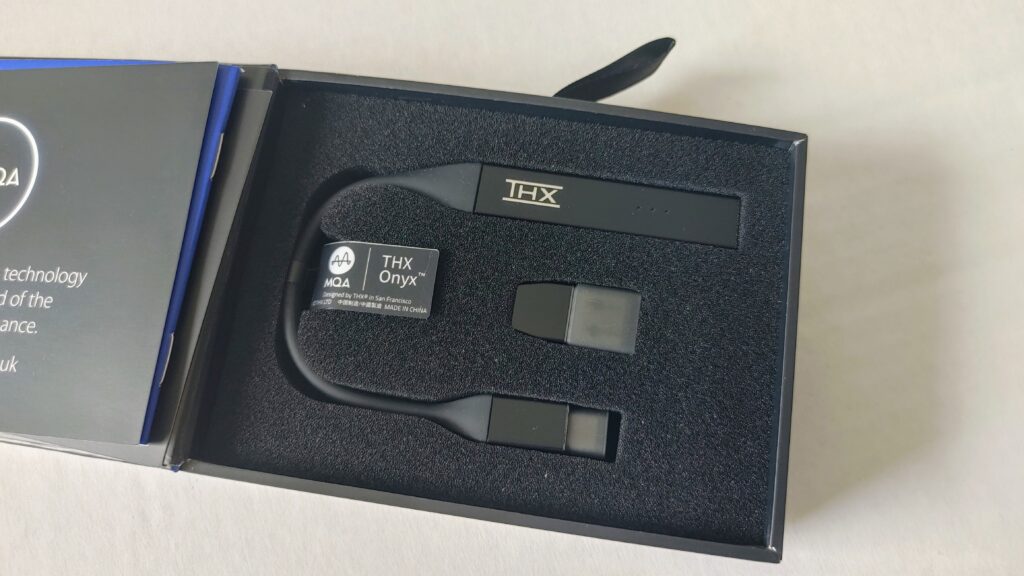
On the portable side, HELM Audio utilized a mobile variant of the THX AAA amp in their DB12 AAAMP Headphone Amp, which provided tons of power and transparency when we tried it last year.
That product used the THX AAA-38 mobile amp circuit, but THX included its best mobile amp circuit in the Onyx, namely the THX AAA-78. The AAA-78 offers about double the power output of the AAA-38, and at 180mw into 22 ohms, the Onyx has output power that rivals many desktop amps.
That means it will drive some of the most power-hungry cans on the market with no problem, including my Dan Clark Audio Aeon Flow Closed headphones, which are known for being hard to drive properly. Even with the AFC headphones, I never had to raise the volume level above 50%, and I heard none of the compressed dynamics I have heard with other portable amps.
The “Achromatic” in Achromatic Audio Amplifier means “without color.” That speaks to the amp circuit’s promised lack of distortion or noise, which THX says provides a “realistic, fatigue-free” listening experience. Most who have listened to it, including me, agree.
To achieve this, THX AAA uses a patented version of feed-forward error correction which means two inverted signals are summed at the output canceling out distortion and removing noise. This is the same principle used in high-end THX AAA desktop amps like the Benchmark HPA4 headphone amplifier.
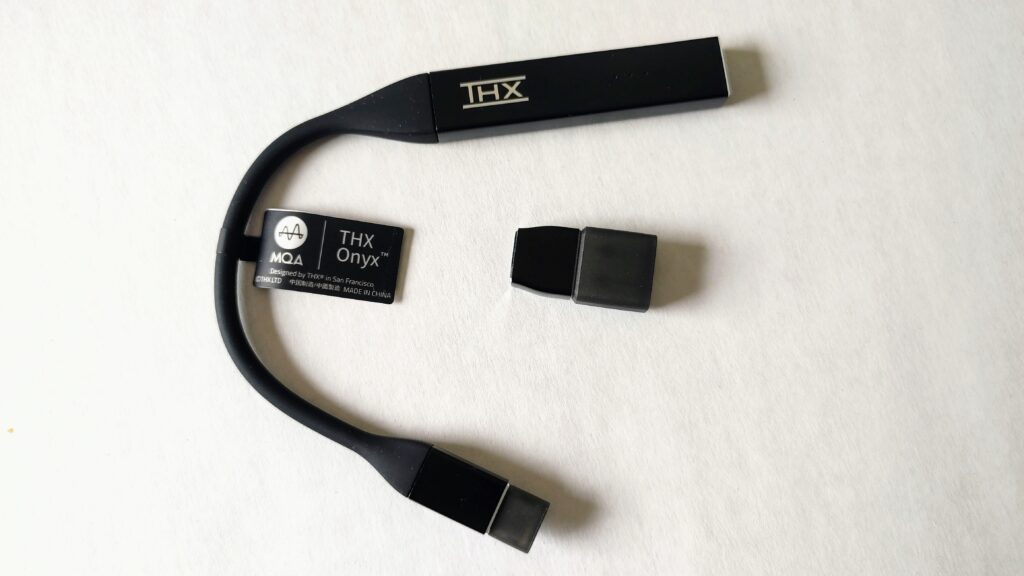
This transparent amp section is combined with a high-quality DAC section based around the ESS ES9281PRO DAC chip. It offers very low total harmonic distortion, MQA rendering, and PCM decoding up to 32-bit 384kHz PCM. The THX Onyx also handles DSD128 over PCM.
Of course, as an MQA renderer, it needs a software decoder like the Tidal Desktop App to do the first unfold of an MQA file, then it will take the 24-bit signal and do the final unfold to a higher bitrate if encoded in the file. The Onyx also 8x up-samples the signal within the DAC to 705.6/768 kHz before the D to A conversion.
On the top of the amp are three led lights that different colors to indicate what signal is going through the DAC. For example, 3 magenta lights mean MQA is being decoded, while 3 yellow lights mean a PCM signal above 48 kHz is being processed. Red indicates a DSD signal. The lights are bright and easy to read.
The THX Onyx has a permanently attached USB-C connector to plug into most newer smartphones and laptops, but if you have a laptop that doesn’t have USB-C, you can use the included USB-A adapter to connect. Apple folks with iOS devices will need the Apple Lightning to USB Camera Adapter (slim version) to plug into that stuff.
By the way, if you are a gamer, the THX Onyx supports mic input from a headset as long as it uses a 3.5mm TRRS plug, which is quite common. This will let you upgrade the audio for games as well as music. That’s pretty cool.
Listening to the THX Onyx Portable DAC/Amplifier
To test out this DAC/Amp, I connected it to both a Moto G Fast smartphone and my HP Envy Laptop via USB-C. On the Smartphone, I played a bunch of MQA tracks from Tidal through the USB Audio Player Pro app. I also used the Desktop version of the Tidal App, playing the same music from the Audiophile 101 MQA playlist on the Laptop.
https://tidal.com/browse/playlist/9641458c-6145-4c15-9515-52110f7cbbcc
As far as headphones are concerned, I mainly used the Focal Elear, and The Mr. Speakers (now Dan Clark Audio) Aeon Flow Closed planar magnetic headphones. I also tried the Hifiman Sundara planar magnetic headphone and the Periodic Audio Carbon earphone to see how it did with IEMs.
I noticed right away about the THX Onyx how extraordinarily crisp and balanced this Dac/AMP is. It is extremely transparent and flat. That means it really allows the headphones to shine and do their thing. As such, it sounded good with every pair of headphones I threw at it.
I wouldn’t worry about matching too much with the Onyx; just find a pair of headphones you like and plug them in. You should be delighted with the result.
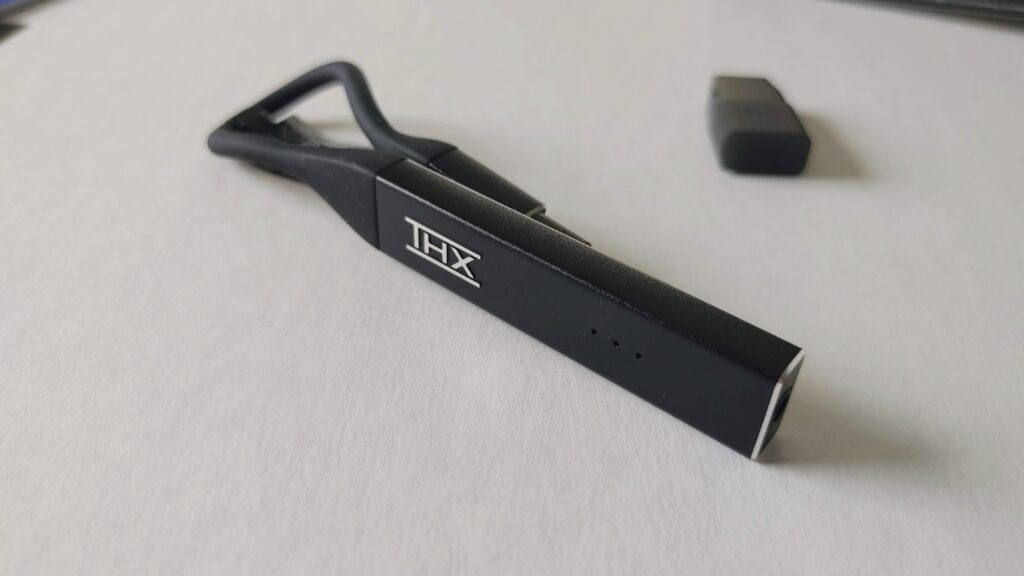
Also, as I said earlier, this DAC/Amp combo should be able to power just about any headphone out there, including power-hungry Planar models with no sweat. I really enjoyed the Onyx with the Aeon Flow Closed, a pair of headphones that really need some juice to open up, and the THX amp did so at less than 25% of volume.
Listening to Angus and Julia Stones’ “Draw Your Swords,” I was amazed at how the Onyx allowed the AFC to present micro-dynamics, such as the guitar strings' trailing notes and the echo of the male vocal in the recording space. It was out of this world. As far as macro-dynamics were concerned, it also did a good job reproducing the punch of the kick drum and the presence of the guitar strumming.
On the song “Babylon Sisters” by Steely Dan, the Onyx played the song with nice depth and punch through the Focal Elear; it also played all the vocal parts with crispness and separation. It’s crazy how transparent this amp is. It’s hard to believe you’re listening to a USB DAC; it really has performance more on par with a desktop unit.
Comparisons
I compared the THX Onyx with two other USB Dac/Amps with MQA, the Audioquest Dragonfly Cobalt ($299), and the Helm Audio Bolt DAC, which is THX Certified ($99).
The BOLT was clearly a step down from the Onyx in both power and transparency. While it sounds amazing for its price, giving you nice timbre on instruments and vocals, plus decent detail, the Onyx was just more open and had more depth, giving you more sense of the recording space and just more detail overall.
The comparison with the Cobalt was much closer. Powerwise, even though the Onyx has more power output on paper, it didn’t really matter because both amps will play just about any pair of headphones louder than you have any business playing them.
As far as sound quality is concerned, I would say the Cobalt has more detail and separation overall, but I would say the difference is very slight. That’s significant because the Cobalt is $100 more at retail, and I can’t say the Audioquest DAC sounds anywhere near $100 better.
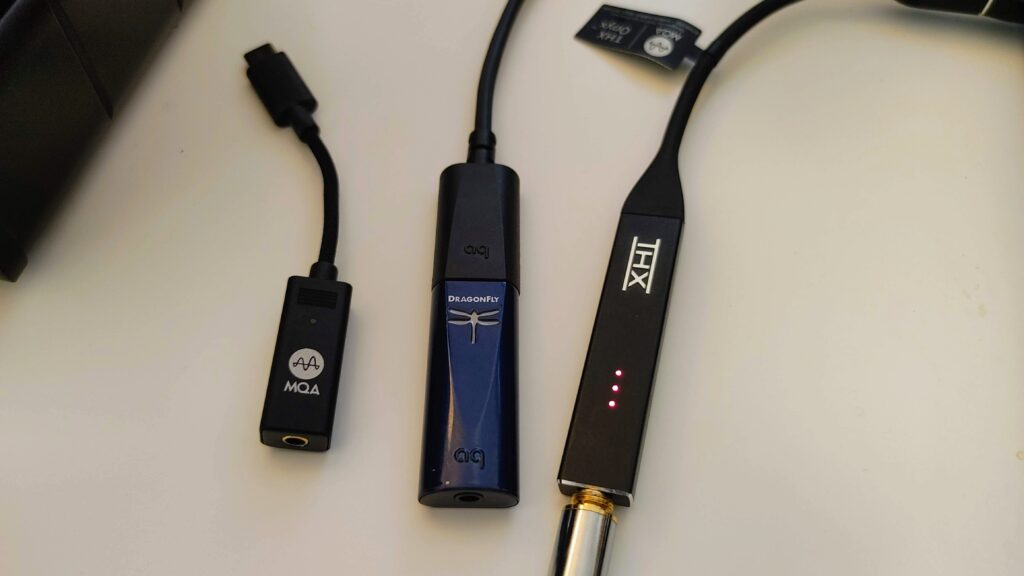
The Cobalt gives you more spatial cues, and transients are a little more fleshed out. It also sounds more layered than the Onyx. However, I would say the Onyx’s overall tonal balance is better as the Cobalt can sound a little hard on certain tracks, something the THX product has no issue with.
At the end of the day, I would say the Onyx gives you about 90% of the detail, separation, and layering of the Cobalt, so if you don’t have $300 to spend, just don’t want to spend that much, or you want something easier to carry, the THX Dac/Amp is a darn good choice.

The Wrap Up
At $199, The THX Onyx may be the best value in USB DAC/Amps today. It has crazy power, a clean, transparent sound that is breathtaking, and a sleek design that makes it easy to carry around. The well-thought-out mix of features also makes it quite flexible for many different use cases.
Music lovers who are looking for a lightweight USB Dac/Amp that compete with Desktop models for both output power and sound quality, then you should give the THX Onyx a look.
This review was originally posted at: https://hifitrends.com/2021/04/07/w...r-first-dac-headphone-amp-combo-is-marvelous/
Pro-Jules
I bought the L&P W2 and Onyx to compare. I kept the Onyx.
A
AudioManNewb
@Evshrug It is not. Why in the world when you have the internet at your finger tips can you not just look at its product page yourself? Also class 2 has been out for what 2 decades why in the hell would anybody release something for a dead Audio Class?
povidlo
@AudioManNewb to use with Nintendo Switch. S1/S2 & W2 offer this funcionality.
cash1489
New Head-Fier
Pros: Great Build Quality
Warm, Natural Sound
Excellent Bluetooth Connection
Warm, Natural Sound
Excellent Bluetooth Connection
Cons: No Remote
Summary
Cambridge Audio’s DacMagic DACs have long provided solid functionality and impressive performance for the money. Their latest DacMagic product, the DacMagic 200M, is their most admirable effort yet.The 200M supports the highest bit rates ever decoded in a DacMagic DAC (32-bit/768kHz), handles DSD and MQA, plus has built-in aptX Bluetooth (previous models needed an adapter). There’s also a powerful Class A/B headphone amp that will drive just about any headphones out there.
The sound is super detailed and natural, with an amazing amount of depth for the price.
At $499, this DAC is an amazing buy; if you’re looking to take your system’s sound to the next level, then you need to check it out!
Read on for more details regarding the DacMagic 200M!
Disclaimer: The DacMagic 200M was sent to us by the manufacturer in exchange for an honest, unbiased review. The DAC will be returned once our evaluation is complete.
Build
The DacMagic 200M has a similar design to the previous DacMagic DACs, basically a steel box with a thick aluminum faceplate. It’s a combination Cambridge Audio has leaned on since I purchased their integrated back in the early 2000s, and it still looks good.On the front, you have nice chrome metal buttons for power, digital filters, digital source selection (at least they look like metal), and a large digital volume knob in the middle. There’s also a ¼” headphone jack for the Class A/B headphone amplifier.
The digital source select button and digital volume knob mean that if you have only digital sources, you can use this DAC as a digital “preamp.” However, keep in mind there is no remote control, so you will need to get up to control the volume. (unless you can adjust the volume at the source.)
The buttons give good feedback, but the volume knob was a little hard to turn, at least on my unit. A marker to let you know where you are in the volume range would be nice as well.
However, both issues amount to nitpicking because the knob works as it’s supposed to, providing a nice even increase in gain across the range.
The DacMagic 200M, like its predecessors, doesn’t have a display screen; all indication is provided via a bank of lights on the front panel. While a screen would be nice, the lack of one keeps the price down and removes the potential of unwanted noise in the signal.

On the back of the unit, you have both RCA unbalanced and XLR Balanced outputs, along with two digital inputs (each with coax/optical in), plus a USB input for connection to a laptop.
You also have a Bluetooth antenna for wireless connection (aptX compatible) and a ground/lift switch if you have USB ground loop issues. This is a nice feature to have, as it may help eliminate unwanted hum in your speakers. Of course, there’s also a plug for the external power supply.
The DacMagic 200M uses twin ESS Sabre ES9028Q2M 32-bit digital-to-analog converters in a dual-mono configuration. That’s one per channel, which aids in stereo separation, resolution, and depth. As stated earlier, this chip handles a wide range of high-resolution sample rates and file types, which vary depending on the connection used:
- Optical: up to 24-bit/96kHz PCM; DSD over PCM supported
- Coaxial: up to 24-bit/192kHz; DSD over PCM supported
- USB: up to 32-bit/768kHz; Native DSD up to 24.576MHz (DSD 512)

When the MQA indicator is Green, it signifies a fully decoded standard MQA signal. Blue signifies MQA Studio, which means the file has “provenance” (you hear exactly what was recorded in the studio).
Magenta means the DAC is working as a render, playing an MQA file partially decoded by software such as the Tidal desktop app.
Three digital filters (fast, slow, short delay) are also available, which allow you to tweak the sound signature of the DAC. I liked the Short Delay filter as it seemed like the most expansive of the three, making the sound a little more open. From what I can see, the DAC also defaults to this filter when listening to MQA.
Listening to the Cambridge Audio DacMagic 200M
With its compact size, the DacMagic is equally at home on the desktop as it is in a hi-fi system, so I tested it in both places.First, I used it as a DAC/Headphone amp on my desk, connecting it to my HP Envy X360 laptop via USB (Cambridge Audio USB Driver required). I plugged in a pair of Mr. Speakers (now Dan Clark Audio) ÆON Flow Closed headphones and played various tracks from the Audiophile 101 MQA Playlist. on Tidal.
The DacMagic’s headphone amplifier drove these notoriously hard-to-drive headphones to levels I had no business listening to, with plenty of headroom to spare. As I alluded to earlier, it has enough muscle for any headphones out there.
After the power, the next thing I noticed was how quiet it was. All you heard was music. The background was extremely clean, and you could hear “into” the recording in a way only possible with a highly transparent amp and DAC.
When playing “Draw Your Swords” by Angus Stone, the DacMagic 200M had a rich, emotive sound with amazing separation. Strings and vocals were fully fleshed out, which reflected the overall smoothness of the midrange.
It was also beautiful to hear the echo of the recording space reverberating all around the vocalist; it’s things like that which bring realism to the performance.
It’s not super analytical like other DACs that beat you over the head with detail. Instead, it provides a natural layering and resolution that’s very musical.
The other thing I liked about the DacMagic 200M and its headphone amp was how well it presented bass. The bass was extremely deep and articulate, giving the performance nice weight. It really made my AEON Flow Headphones sing.
With its crisp delivery and excellent tonal balance, this DAC also does a great job in a hi-fi rig.
I hooked it up to the same computer in my listening room, but this time I ran Roon through the DAC instead of the Tidal Desktop app. I connected the DacMagic 200M RCA output to the RCA input on my Cayin MT-12 Tube Amp, connected to a pair of Triangle Genese Trio Bookshelf speakers.
The DacMagic 200M is Roon Ready, and as such, it was quickly recognized by the software. Via Roon, I played the same TIDAL playlist I used to test the headphone amp section.
As much as I liked this DAC on the desktop, I liked it even more in the hi-fi setup. The layering and detail I heard through the headphones had more room to develop as it entered the room from the speakers.

The Cambridge Audio DAC enhanced the warmth and soundstage of the Cayin/Triangle combo. The imaging was remarkable as well, both in the center and edges of the stage. Each element of the mix was separated beautifully, which is amazing for such a reasonably priced device.
Listening to the same song from earlier, the male vocal was so vivid without any coloration, and the performance was airier. The background singers were off to the left in the rear, and the reverberations I heard over the headphones actually recreated the recording space in my listening room.
I never heard this setup sound so tight and cohesive. There was none of the edginess you expect to hear from an affordable DAC, plus the transparency of the performance was stunning. The way it helped tighten up and deepen the low end was also remarkable.
Lastly, I checked out the Bluetooth wireless connection, and using the aptX signal from my LG V60 smartphone it was really good! While some of the trailing edge details were lost, much of it was retained, and I really had to listen closely to hear the difference between wired and wireless. The wireless connection was great, and I would have no problem using it for casual listening sessions.
Now, can you get more depth and separation by spending more money? The answer is yes. But I think many audiophiles with systems in the 2-5k range could benefit from the sonic improvement of this standalone DAC.
The other things you will get by spending more would be a display screen that would provide more information and a remote. But then you would probably have to spend at least double the money to get much of a sonic benefit.
Compared to the iFi NEO iDSD
I compared the DacMagic 200M to the iFi NEO iDSD, another MQA DAC/Headphone Amp l love for around the same price. It’s about $200 more at $699, but it has a small display screen that displays the volume numerically, amongst other things, and a little card remote, which the Cambridge Audio product doesn’t include.Those are nice things to have, but soundwise the two DAC are very close in quality. It’s funny because Burr-Brown-based DACs are usually considered warm, and ESS-based DACs are considered to be on the cooler side, but here I found the opposite.

I found the Burr-Brown-based iFi DAC to have the same depth and separation as the ESS-based DacMagic 200M. However, the NEO iDSD was cooler sounding with more sparkle on the top end, while the Cambridge Audio DAC was warmer and richer, with more fullness on the bottom end.
To me, they are just about equal in sound quality. I would recommend the DacMagic 200M for those with a more analytical system that needs some warmth; then I would recommend the NEO iDSD for those who have a system on the warmer side and need some more detail on the top end.
Regarding the headphone amps, the DacMagic 200M has the more powerful amp, but the iFi NEO iDSD will drive all but the most power-hungry headphones as well.
The Wrap Up
For $500, it’s going to be hard to beat the combination of sound quality and features offered by the DacMagic 200M. While the headphone amp is top-notch, I really recommend this product for those looking for a first standalone DAC or to upgrade the DAC built into their existing gear. They may be suprised at how much this compact box improves the sound of their system.This review was originally posted at: https://hifitrends.com/2021/04/17/c...view-this-affordable-dac-amp-is-breathtaking/
C
cybergalaxy
Do you have experience with iFi micro IDSD signature? how would you compare the two?
cash1489
New Head-Fier
Pros: Well built, looks great
Balanced sound with nice punch
No dedicated amp needed
Balanced sound with nice punch
No dedicated amp needed
Cons: Earpads are a little shallow
Could be too small for larger heads
Could be too small for larger heads
Summary
The $255 SIVGA Phoenix is an affordable open-back, over-ear dynamic driver headphone with a beautiful design and crisp, rich sound. The polished zebra wood cups, protein leather, chrome accents, and black lacquer metal frame combine for a luxurious-looking package.
They’re lightweight and comfortable so that you can wear them for long listening sessions, but they just fit larger heads. The 50mm Polycarbonate film driver provides nice air up top without being edgy, natural midrange, and just enough lift on the bottom end to keep things interesting.
There is slight coloration in the lower mids, but you must strain to hear it, and some may find the stock pads are a little bit shallow. In that case, they do offer deeper protein leather replacement pads for about $15, which is quite reasonable.
Overall, it’s a very capable and musical headphone for the price, with a sound signature that plays nice with just about any genre you throw at them. The layering and separation are also really good for a headphone under $300.
If you’re looking for a relatively balanced open-back headphone in this price range, it’s definitely worth a listen.
Disclaimer: The SIVGA Phoenix was sent to us by the manufacturer in exchange for an honest review; we will return them once the review is complete.
Build
Upon opening the box, you’ll find the Phoenix headphones, along with a large zippered hard case, a flexible, tangle-resistant 2.5mm to 3.5mm cable, and a canvas bag to store the cable in.
Picking up the headphones, you’ll see the Phoenix uses a combination metal frame/sliding suspension strap to keep them resting lightly on top of your head, and the clamping force is nicely judged even for a huge noggin like mine.
The padded protein leather suspension strap is nicely cushioned, and due to its relatively small size and aluminum/wood construction, the Phoenix is extremely lightweight. The cups swivel liberally, which allows them to form to your head. All of this adds up to a headphone that is quite comfortable and easy to wear.

However, the compact dimensions do come into play when it comes to head size. With my large head (7 7/8 hat size), the cups just came down over my ears, and I adjusted the strap almost all the way to the top. This didn’t affect comfort; it’s just worth mentioning.
SIVGA is well known for its striking Wood headphone designs, and the polished zebra wood cups utilized on the Phoenix make it easy to see why. They look excellent, and the chrome rings surrounding the steel mesh screens in the center add to the upscale aesthetic.
Inside the cups are 50mm ultra-thin Polycarbonate film drivers which are meant to be very lightweight but able to move precisely without deformation. This helps to provide both extended highs and bass.
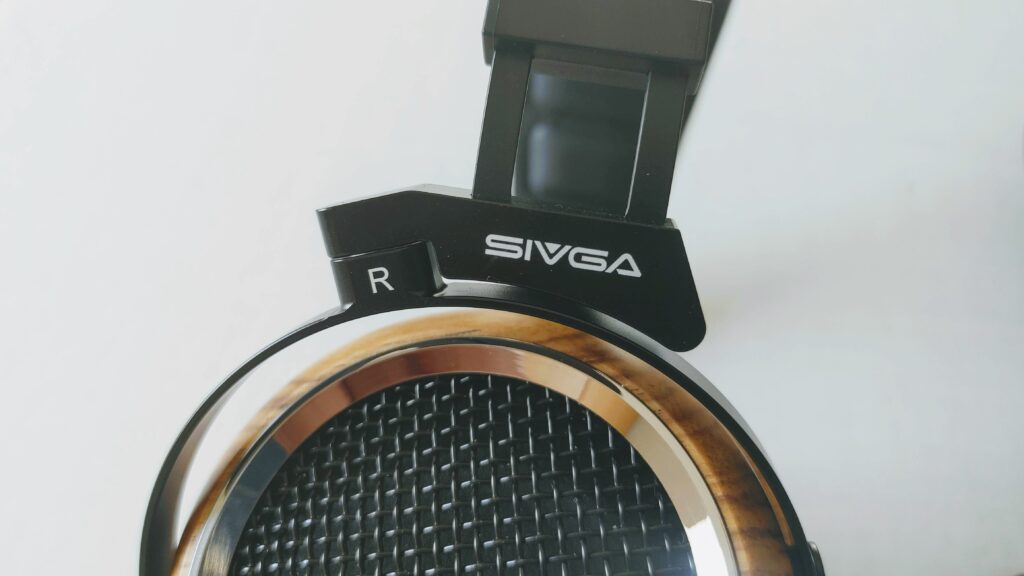
The headphones come with hybrid memory foam earpads installed, lined with protein leather both inside and out. On the part that rests against your skin, there is a soft, velvety microfiber. The pads are angled to help with fit.
The earpads are a little on the shallow side, so my ears did make quite a bit of contact with the interior lining. It didn’t bother me, but it's something to think about if you’re sensitive to that kind of thing.
By the way, if the stock pads do bother you, SIVGA offers protein leather replacement pads that are a little thicker and reduce contact. They are reasonably priced at about $15 and do add a bit of comfort.
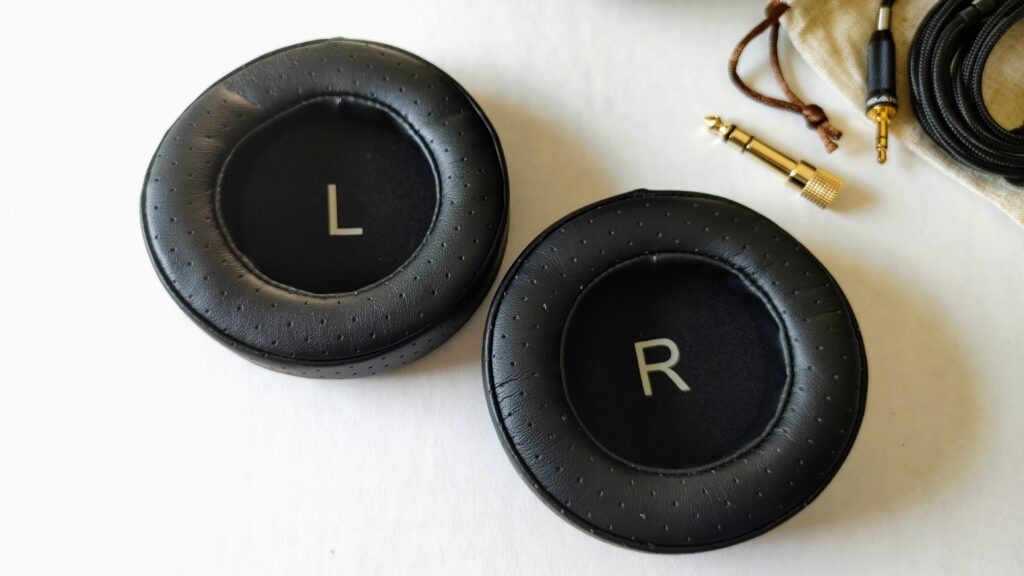
Keep in mind, the replacement pads do tip the midbass up a little, which adds a little more warmth, but you sacrifice a bit of midrange clarity and top-end air in exchange. If you buy the Phoenix, I recommend that you invest in a pair to hear both options.
As I alluded to earlier, the included cable, while a little on the thin side, is flexible and tangle-resistant. It also has a nice length to it.
With its high sensitivity and low impedance, it’s also effortless to drive, making it a nice match for small digital audio players and smartphones. Just be careful with high-gain amps because things can get a little noisy.
Listening to the SIVGA Phoenix Headphone
I connected the Phoenix to various gear for my testing, including a $220 Shanling M2x digital audio player, LG V60 Smartphone with ESS Quad DAC, the $99 HELM Bolt USB DAC, and the $649 iFi Micro iDSD Signature transportable DAC.
The latter two were connected to my ENVY X360 laptop playing MQA tracks from the TIDAL desktop app, while I played local high-resolution FLAC files on the DAP and Smartphone. All my sound impressions are based on the sound with the stock pads.
One thing I noticed about these headphones is they sounded good no matter what I hooked them up to, and they scaled up nicely with better sources.
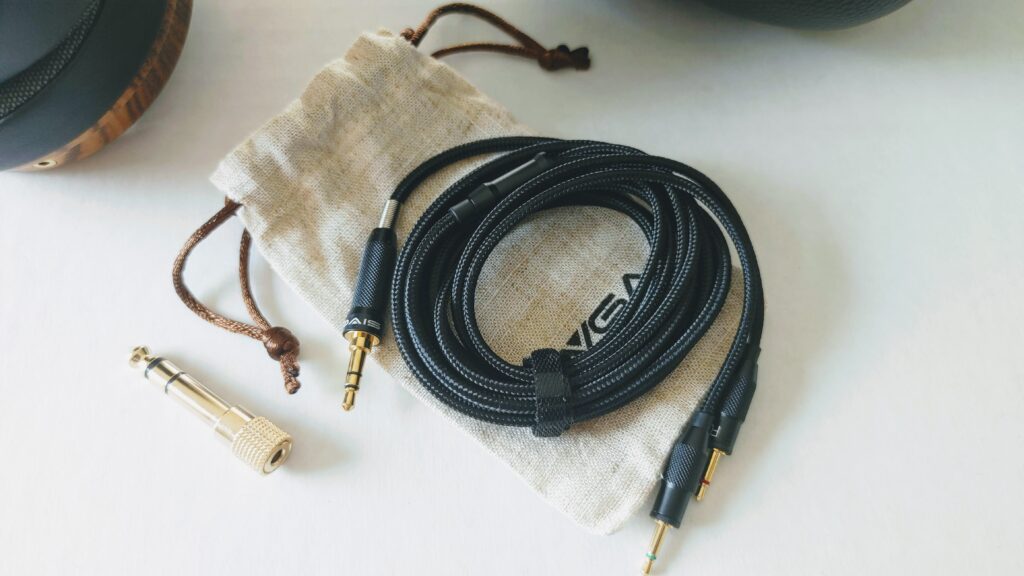
If I had to sum up the Phoenix’s sound, I would say it’s relatively balanced with a tasteful bump in the sub-bass, which adds some nice weight to the presentation. Since they're pretty flat through most of the audioband, they come out a little on the cool side.
Because they have a little dip in the lower treble, they do come sound a little dark on certain tracks, but not dark enough to sound overly veiled.
For a $300 headphone (now $250), the Phoenix did extremely well with both micro and macro detail, nicely presenting strings with fullness and realism. It did the same with vocals giving me a good helping of Donald Fagen’s soulful delivery on Steely Dan’s “Babylon Sisters."

I also loved the soundstage and imaging on Eric Clapton’s “Tears In Heaven” from his “Unplugged” album. The stage was pretty wide, with the background singers and guitarists appearing to come from well outside the earcups. The imaging was also relatively focused, especially in the center.
I also liked the dynamics, as demonstrated on Tony Allen’s and Hugh Masekela’s “Robbers, Thugs, and Muggers,” where the full fury of Allen’s drum kit was on display, showcasing the Phoenix’s considerable punch and slam.
The drum hits weren’t as precise as I’ve heard on other (more expensive) headphones, but they were full and pretty defined.
Comparisons
I compared the Phoenix to some of the other headphones I had in the price range, including the Hifiman SUNDARA ($350), the Drop/Sennheiser HD58X Jubilee ($170), and the Meze 99 Classics ($309).
The HD 58X Jubilee was a lot warmer than the Phoenix, with rolled-off highs giving it an overall darker vibe. The Sivga headphone was a lot more complex than the 58X, providing more soundstage width and imaging, as well as top-end detail.
However, the 58X did provide a little more microdetail which added some of the depth the Phoenix is missing. Overall the Phoenix is more engaging, though, and it also wins for build quality. Comfort is a wash.
Moving on to the Meze, the 99 Classic sounded a little more closed in compared to the Phoenix, which is to be expected from a closed-back headphone.
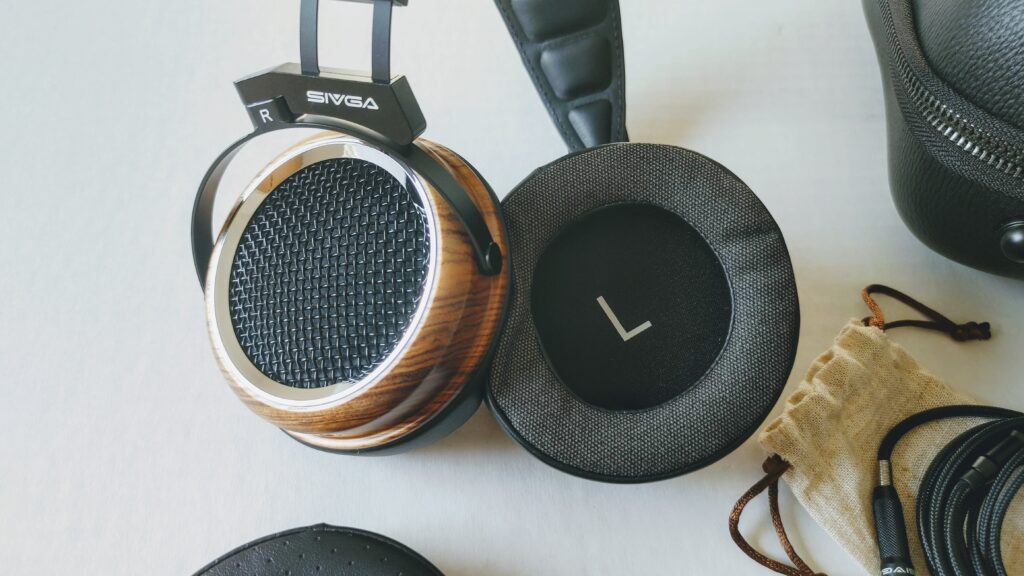
The Meze was a also warmer than the SIVGA headphone with more power and dynamics on the low end, but the bass tends to overpower the mix on some songs, like the Tony Allen drum track mentioned earlier.
The SIVGA was more open, balanced, and had more detail overall. It also sounded a little more natural. That appealed more to me.
However, the Meze would probably appeal more to the bassheads. The Meze also edges the Phoenix out in Build and Comfort.
Even though the Hifiman SUNDARA is a more expensive headphone, I had to see how the Phoenix stacked up vs. the best headphone under $500.
Build and Comfort is pretty much a wash; if anything, the SUNDARA may be a touch more comfortable, especially for big heads like mine. However, some may find the Phoenix more comfortable since it has swiveling cups that mold to your head. The SUNDARA doesn't.

When it comes to Sound Quality, the SUNDARA is heads and shoulders above the Phoenix, with a lot more separation and depth. However, the Phoenix is actually the more open headphone with a wider soundstage.
Comparing the two lets you hear the slight coloration within the midrange on the Phoenix and its slight lack of precision. But when it comes to musical engagement, the Phoenix matches up pretty well. Its presentation is actually more lively with more punch and slam than the Hifiman, which may win some folks over.
That said, the SUNDARA has just a little more depth, allowing you to hear more “into the music” than the SIVGA headphone.
The Wrap Up
I must say the SIVGA Phoenix is quite an accomplished headphone, especially at its current price of $255. If you can deal with the pads' shallowness, you will be rewarded with some great sound. I really dig the wide soundstage, natural midrange, and punchy bass. They also look outstanding. I highly recommend for those looking for an affordable audiophile headphone.
This review was originally posted at http://hifitrends.com/
cash1489
New Head-Fier
Pros: Beautiful Design
Great Build Quality
Nice Detail and Soundstage
Great Build Quality
Nice Detail and Soundstage
Cons: May Have A Little Bit Too Much Bass Energy For Some
Stiff Cable
Stiff Cable
The Beyerdynamic T5 is a legendary closed-back model in the headphones world, well known for its musicality and wide soundstage. It sits at the top of their wired hi-fi headphone range and contains the best technology Beyerdynamic has to offer, including their special Tesla dynamic transducer.
Today I'm looking at the newest version of the T5, the $999 Beyerdynamic T5 High-end Tesla Headphones (3rd Generation). It’s advertised as having a “more natural reproduction” of high-mid range frequencies than the 2nd generation model. The 3rd generation’s presentation is intended to be more “realistic,” meaning that the timbre of instruments and vocals should be more true to life.
(For the headphone junkies, this basically means a flatter frequency response in the upper mids, most likely a reaction to perceived peaks present in the 2nd Generation model.)
This headphone is ideally suited for at-home listening, but with its 32-ohm impedance and high-sensitivity, you could use it on the go with a digital audio player. But to hear it at its best, you need to use it with a quality headphone amp. That can range anywhere from a USB DAC/Amp like the Audioquest Dragonfly Cobalt, all the way up to an Amp/DAC stack like the Topping D90/A90.
If you have a good source, the T5 (3rd Gen) is capable of some mind-blowing sound. It has good detail retrieval, a natural midrange, and an excellent soundstage (especially for a closed-back headphone). However, there is also a bass bump and a little treble edge that won’t be for everybody. That said, If you find headphones with “flat” tuning to be “boring,” then the bold tuning of the T5 may be just what you’re looking for.
Read on for my full breakdown of Beyerdynamic’s latest flagship cans!
Disclaimer: These headphones are on loan from Beyerdynamic. They were provided with the understanding that we would write an honest, unbiased review.
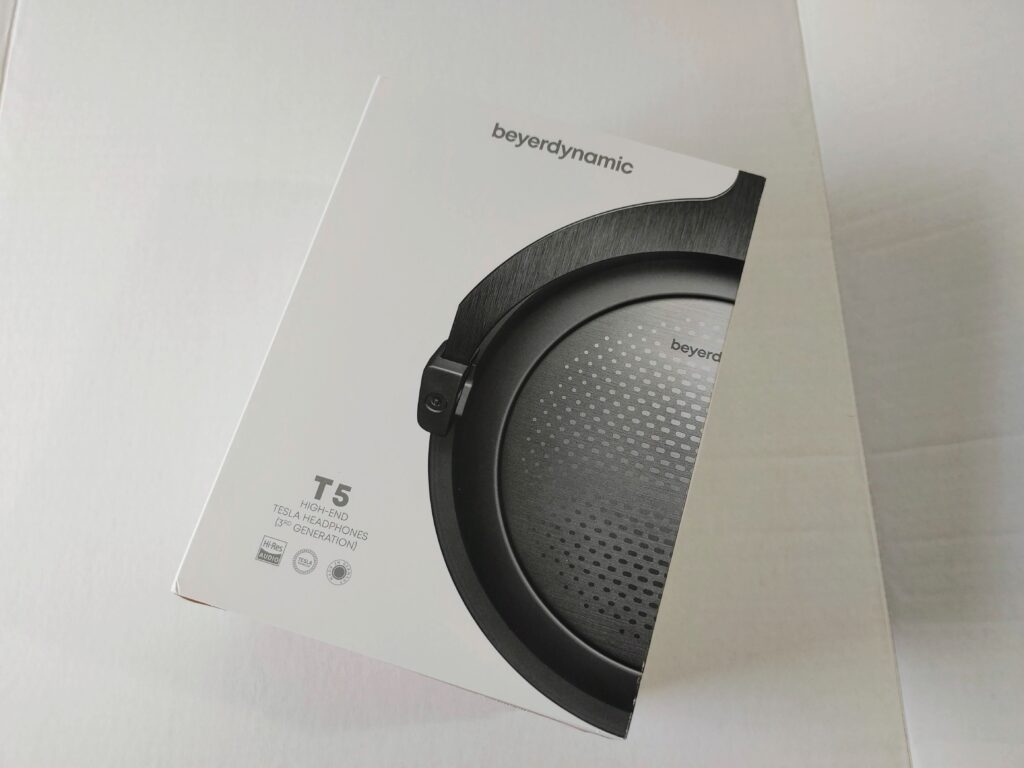
Build/Features
The latest T5 is a well-built, lightweight (360g) headphone with sufficient comfort to support long listening sessions. It’s a circumaural (over-ear) headphone, but the earcups are a little on the small side, so your ears may touch the inside of the earpads or the dampening material covering the drivers (especially if your ears are big like mine) when you have them on.
That said, I found the interior of the cups and the protein leather earpads to be quite soft, and I didn’t feel any discomfort while listening. The clamp is well-judged, allowing the headphones to sit securely on your head without putting it in a vise grip. Soft padding on the bottom of the headband ensures no pressure points on the top of the head. I did have to shift the earcups around to fit my ears in properly and get a good seal around my ears, which is important.
Speaking of the earcup interior, it’s designed with a tilt to position the drivers in line with your ear. That’s intended to give you a better sense of soundstage and imaging. More on that later.
By the way, the earcups also provide a nice amount of isolation from outside noise, so if you’re listening in a noisy environment, these headphones will provide some quiet.
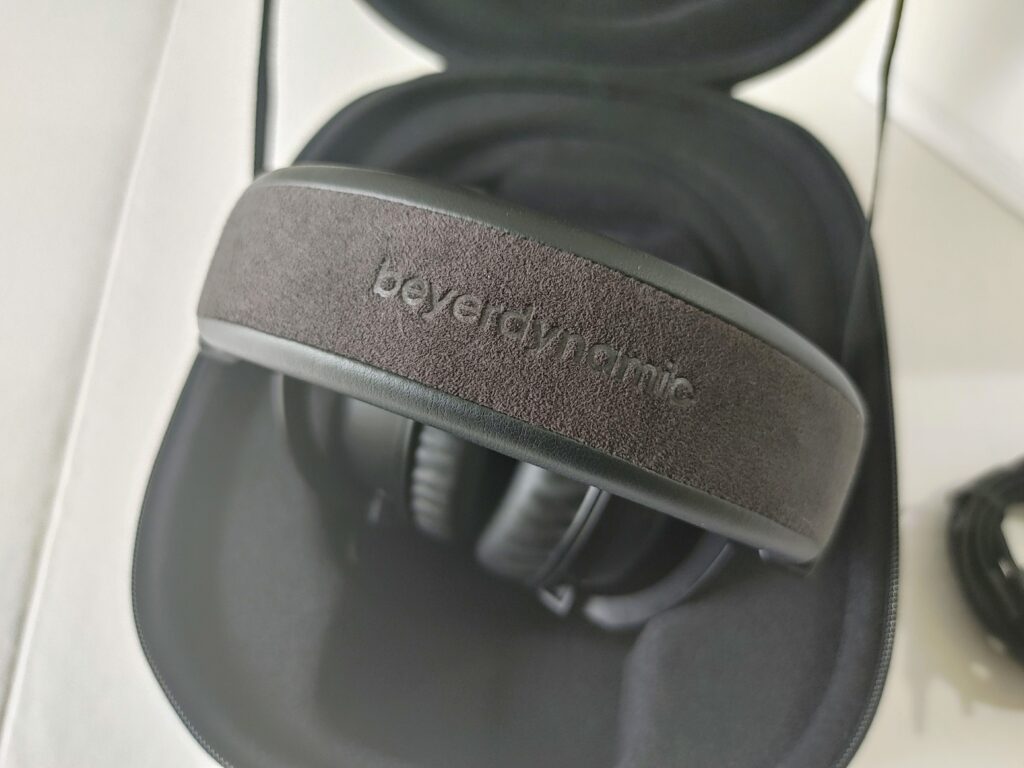
The T5 (3rd Gen) has an understated aesthetic, which is both minimal and luxurious at the same time. The brushed aluminum on the earcups and Alcantara (faux suede used on many luxury goods) accent on the headband add a touch of class without the bling present on the Amiron Copper Wireless, the last Beyerdynamic headphone I reviewed (and loved). I like the new T5 look; it's a lot cleaner than the last model.
Like the majority of Beyerdynamic headphones, this model is built like a tank, using hard molded plastic along with strong metal components for the headband and yokes. Each headphone is handmade in Germany to ensure quality.
As far as accessories go, it comes with a nice hard case covered in Alcantara fabric, a 3 meter (almost 10 foot) detachable Y-cable with a 3.5mm plug, and a ¼” adapter for connection to headphone amps.
The included cable is covered with a braided fabric, making it a little stiff out of the box, but it does loosen up over time. Additional XLR and 2.5mm balanced cables are available from Beyerdynamic. The case is on the large side so that you won’t be sticking it in your bag and running to the coffee shop, but it will provide a safe, clean place for your investment.
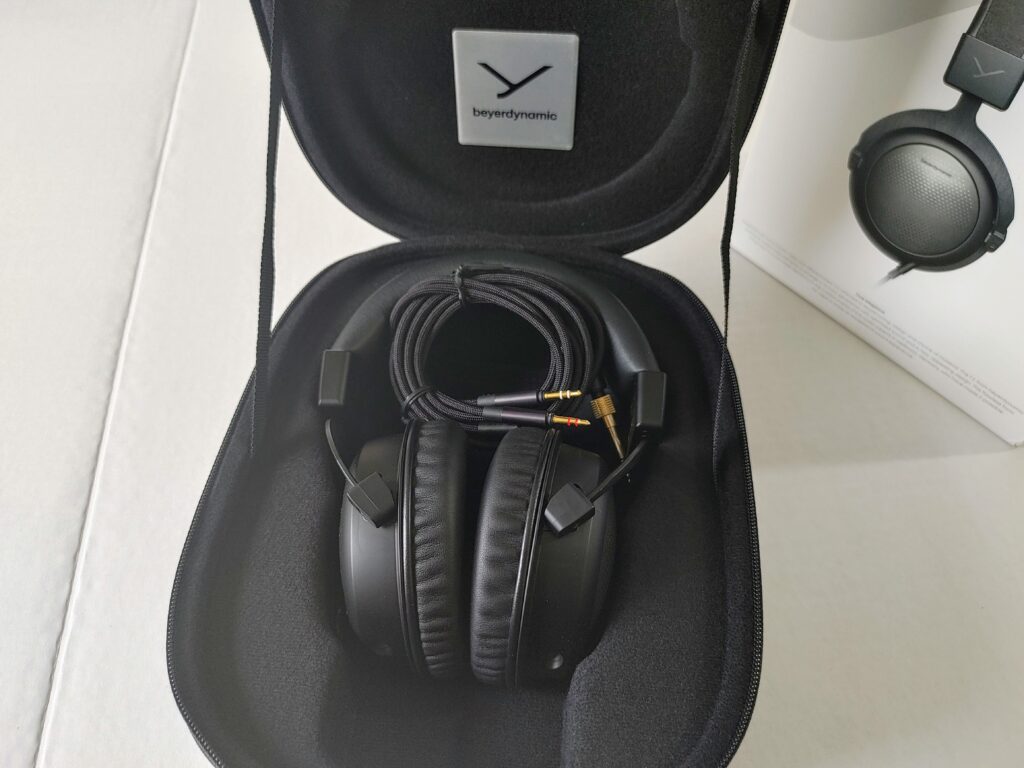
Listening to the Beyerdynamic T5 Headphones (3rd Generation)
For my sound tests, I connected the T5 to several DAC/Amp combinations connected to my HP Envy laptop via USB. I started with the $129 iFi ZEN DAC Dac/Amp, then added the $169 iFi ZEN Can headphone amp. Next, I tried the $699 iFi NEO iDSD Dac/Amp combination, then the Topping A90/D90 Amp/DAC stack ($1249 as a pair). All music was played from the TIDAL desktop app.
These options worked well with the T5 when it came to driveability, but as I moved up in source quality, there was a noticeable increase in sound quality at each step. That means you really want to have some quality amplification to get the best out of these. At the end of the day, I settled on the Topping stack, and that’s where my sound impressions come from.
Overall, the T5 (3rd Gen.) has a warm sound signature with some elevated treble and a bump in the midbass, which adds excitement to the sound. It’s not a flat reference tuning by any means, so those who like that kind of sound should probably listen to this headphone before buying. But if you’re the type who thinks flat = boring, then the T5’s sound is probably right up your alley.
The T5 has a lot of great detail on the top end, making strings, horns, and guitars sound exquisite. Transients and percussive attacks also come through clearly, which makes music come alive in a beautiful way. Instrument separation is excellent. There is some treble edge that comes through on some songs, so if you're sensitive to that sort of thing, that is something to think about. But overall, the treble is handled well.
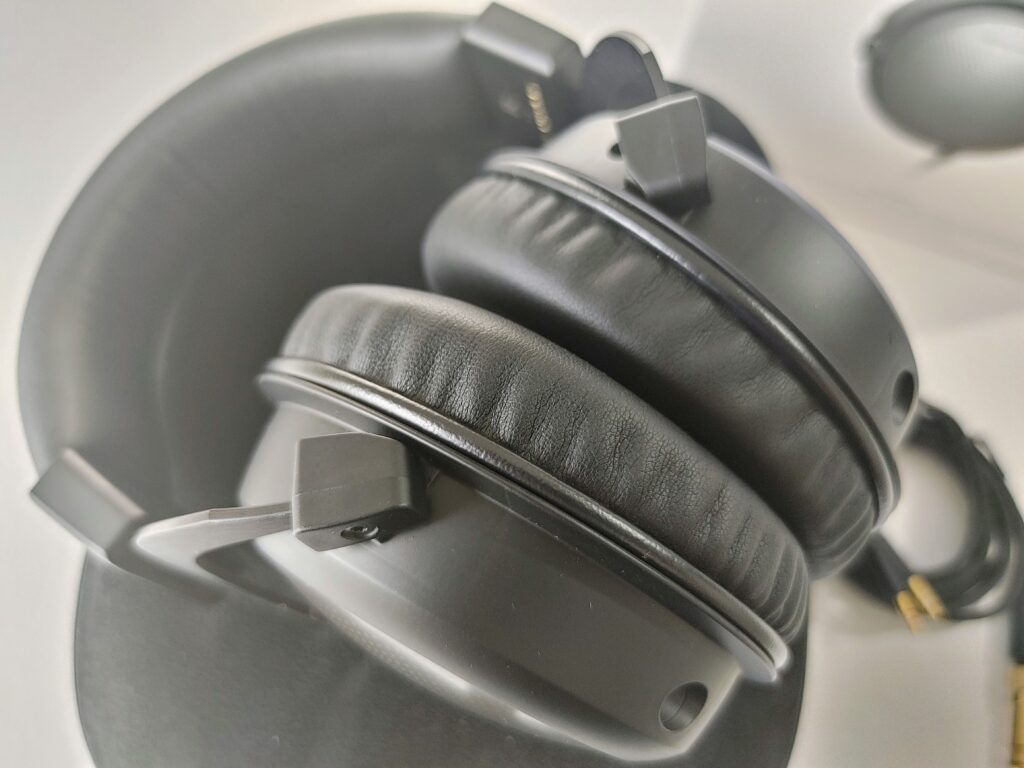
As far as bass/midrange is concerned, the midrange is handled very naturally for the most part. Flattening out the midrange seemed to be one of the main improvements advertised for this headphone, and I’ll say that was a positive. The mids sound quite realistic most of the time, and vocals, especially female vocals, are presented palpably with lots of emotion. Piano, horns, and strings again come across with a live realistic quality.
The bass will probably be the most divisive part of this headphone, as the midbass is pushed well above neutral. This does provide aural fireworks in the form of bass punch, dynamics, and weight, making the T5 a very exciting listen. But to me, it also makes the rhythm sound too exuberant in places.
If a song has a strong bass emphasis, instruments like drums can come across as too bloated, which I’m personally sensitive to. There also seems to be some bleed into the mids on the same songs, adding some coloration to deep male voices. Besides that, there also seems to be a sub-bass roll-off, which takes away some thump from places I expect.
When it comes to Soundstage and Imaging, I must say this is one of the T5s biggest strengths. The tilted drivers combined with the treble air in the frequency response make for a headphone that plays well outside of the earcup, remarkable for a closed-back headphone. It also images remarkably for a closed-back headphone, allowing you to pick out individual performers and instruments set out in front of you.
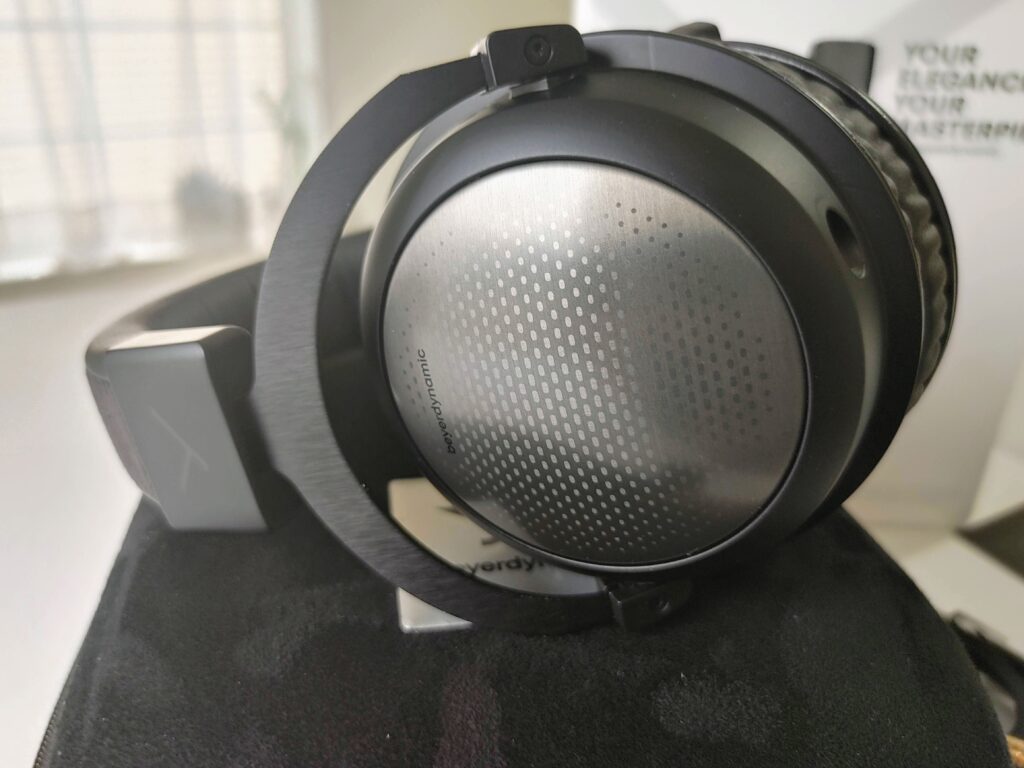
Playing Some Tunes
Listening to “Teach You” from Emily King’s “Sides,” I was really taken by how the T5 imaged and presented space. Being a duet (with Emily King and Sara Bareilles), it’s entertaining to hear the two spectacular vocalists' harmony and interplay. On a headphone that resolves well, like the T5, you can clearly hear the two singers' placement next to each other along with the distinct differences in their singing styles, which is mesmerizing.
I also put on the MQA version of “Lucky Seven” from Dave Holland’s “Good Hope” album, and I was amazed by how naturally the T5 reproduced the percussion darting all around the soundstage. The horn notes were a little edgy, and the bass notes had just a bit too much bass energy for my taste, but the excellent instrument separation and technical prowess of these headphones were undeniable. It also displayed the T5 great dynamics, as it moved from the initial quiet passage to the loud horn part without missing a beat.
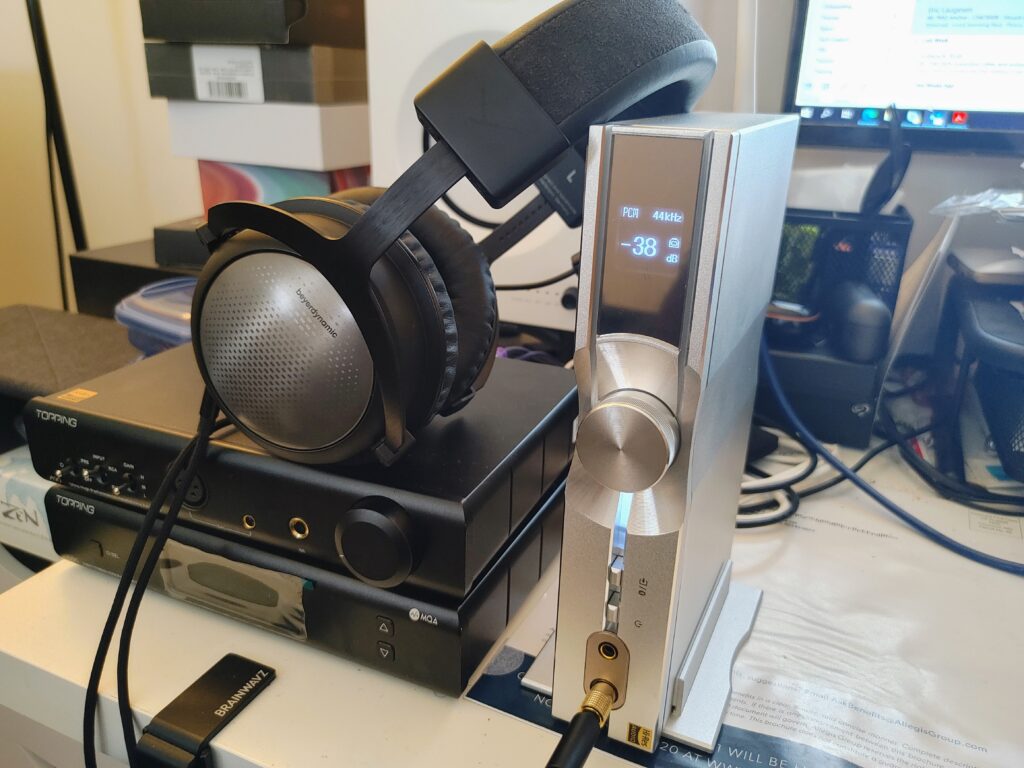
Compared to the Mr. Speakers AEON Flow Closed
The AEON Flow Closed (1st version) was the only other closed-back headphone I had on hand that was close to the T5’s price range, so I made a quick A-B comparison. Listening to the Lucky Seven song again, the AFC was definitely a lot less lively than the T5, exhibiting a lot less punch and dynamics. The T5 was just a more fun listen overall; its rhythm really just propelled the song forward in an exciting way that was pleasing.
The AFC, however, played the song with a little more microdetail (partially the planar’s driver character vs. the dynamic), allowing you to hear stuff like the hands beating on the congo drum (?), along with the individual notes coming from the horn. I appreciated the flatter tuning of the AFC since it allowed me to hear “into” the track more. Still, I can understand those who prefer the excitement of the T5; the AFC actually did sound a little “boring” next to the Beyerdynamic.
The Wrap Up
As I said initially, the Beyerdynamic T5 (3rd Generation) is a good looking, well built, lightweight headphone that’s comfortable for long listening sessions. They have just a little too much bass emphasis for my taste, but I couldn’t help but fall for the T5’s detail, naturalness through the midrange, astounding soundstage, and imaging. If you’re looking for a warm, closed-back headphone with hi-fi chops, then you should check this one out!
This review was originally published at hifitrends.com
Today I'm looking at the newest version of the T5, the $999 Beyerdynamic T5 High-end Tesla Headphones (3rd Generation). It’s advertised as having a “more natural reproduction” of high-mid range frequencies than the 2nd generation model. The 3rd generation’s presentation is intended to be more “realistic,” meaning that the timbre of instruments and vocals should be more true to life.
(For the headphone junkies, this basically means a flatter frequency response in the upper mids, most likely a reaction to perceived peaks present in the 2nd Generation model.)
This headphone is ideally suited for at-home listening, but with its 32-ohm impedance and high-sensitivity, you could use it on the go with a digital audio player. But to hear it at its best, you need to use it with a quality headphone amp. That can range anywhere from a USB DAC/Amp like the Audioquest Dragonfly Cobalt, all the way up to an Amp/DAC stack like the Topping D90/A90.
If you have a good source, the T5 (3rd Gen) is capable of some mind-blowing sound. It has good detail retrieval, a natural midrange, and an excellent soundstage (especially for a closed-back headphone). However, there is also a bass bump and a little treble edge that won’t be for everybody. That said, If you find headphones with “flat” tuning to be “boring,” then the bold tuning of the T5 may be just what you’re looking for.
Read on for my full breakdown of Beyerdynamic’s latest flagship cans!
Disclaimer: These headphones are on loan from Beyerdynamic. They were provided with the understanding that we would write an honest, unbiased review.

Build/Features
The latest T5 is a well-built, lightweight (360g) headphone with sufficient comfort to support long listening sessions. It’s a circumaural (over-ear) headphone, but the earcups are a little on the small side, so your ears may touch the inside of the earpads or the dampening material covering the drivers (especially if your ears are big like mine) when you have them on.
That said, I found the interior of the cups and the protein leather earpads to be quite soft, and I didn’t feel any discomfort while listening. The clamp is well-judged, allowing the headphones to sit securely on your head without putting it in a vise grip. Soft padding on the bottom of the headband ensures no pressure points on the top of the head. I did have to shift the earcups around to fit my ears in properly and get a good seal around my ears, which is important.
Speaking of the earcup interior, it’s designed with a tilt to position the drivers in line with your ear. That’s intended to give you a better sense of soundstage and imaging. More on that later.
By the way, the earcups also provide a nice amount of isolation from outside noise, so if you’re listening in a noisy environment, these headphones will provide some quiet.

The T5 (3rd Gen) has an understated aesthetic, which is both minimal and luxurious at the same time. The brushed aluminum on the earcups and Alcantara (faux suede used on many luxury goods) accent on the headband add a touch of class without the bling present on the Amiron Copper Wireless, the last Beyerdynamic headphone I reviewed (and loved). I like the new T5 look; it's a lot cleaner than the last model.
Like the majority of Beyerdynamic headphones, this model is built like a tank, using hard molded plastic along with strong metal components for the headband and yokes. Each headphone is handmade in Germany to ensure quality.
As far as accessories go, it comes with a nice hard case covered in Alcantara fabric, a 3 meter (almost 10 foot) detachable Y-cable with a 3.5mm plug, and a ¼” adapter for connection to headphone amps.
The included cable is covered with a braided fabric, making it a little stiff out of the box, but it does loosen up over time. Additional XLR and 2.5mm balanced cables are available from Beyerdynamic. The case is on the large side so that you won’t be sticking it in your bag and running to the coffee shop, but it will provide a safe, clean place for your investment.

Listening to the Beyerdynamic T5 Headphones (3rd Generation)
For my sound tests, I connected the T5 to several DAC/Amp combinations connected to my HP Envy laptop via USB. I started with the $129 iFi ZEN DAC Dac/Amp, then added the $169 iFi ZEN Can headphone amp. Next, I tried the $699 iFi NEO iDSD Dac/Amp combination, then the Topping A90/D90 Amp/DAC stack ($1249 as a pair). All music was played from the TIDAL desktop app.
These options worked well with the T5 when it came to driveability, but as I moved up in source quality, there was a noticeable increase in sound quality at each step. That means you really want to have some quality amplification to get the best out of these. At the end of the day, I settled on the Topping stack, and that’s where my sound impressions come from.
Overall, the T5 (3rd Gen.) has a warm sound signature with some elevated treble and a bump in the midbass, which adds excitement to the sound. It’s not a flat reference tuning by any means, so those who like that kind of sound should probably listen to this headphone before buying. But if you’re the type who thinks flat = boring, then the T5’s sound is probably right up your alley.
The T5 has a lot of great detail on the top end, making strings, horns, and guitars sound exquisite. Transients and percussive attacks also come through clearly, which makes music come alive in a beautiful way. Instrument separation is excellent. There is some treble edge that comes through on some songs, so if you're sensitive to that sort of thing, that is something to think about. But overall, the treble is handled well.

As far as bass/midrange is concerned, the midrange is handled very naturally for the most part. Flattening out the midrange seemed to be one of the main improvements advertised for this headphone, and I’ll say that was a positive. The mids sound quite realistic most of the time, and vocals, especially female vocals, are presented palpably with lots of emotion. Piano, horns, and strings again come across with a live realistic quality.
The bass will probably be the most divisive part of this headphone, as the midbass is pushed well above neutral. This does provide aural fireworks in the form of bass punch, dynamics, and weight, making the T5 a very exciting listen. But to me, it also makes the rhythm sound too exuberant in places.
If a song has a strong bass emphasis, instruments like drums can come across as too bloated, which I’m personally sensitive to. There also seems to be some bleed into the mids on the same songs, adding some coloration to deep male voices. Besides that, there also seems to be a sub-bass roll-off, which takes away some thump from places I expect.
When it comes to Soundstage and Imaging, I must say this is one of the T5s biggest strengths. The tilted drivers combined with the treble air in the frequency response make for a headphone that plays well outside of the earcup, remarkable for a closed-back headphone. It also images remarkably for a closed-back headphone, allowing you to pick out individual performers and instruments set out in front of you.

Playing Some Tunes
Listening to “Teach You” from Emily King’s “Sides,” I was really taken by how the T5 imaged and presented space. Being a duet (with Emily King and Sara Bareilles), it’s entertaining to hear the two spectacular vocalists' harmony and interplay. On a headphone that resolves well, like the T5, you can clearly hear the two singers' placement next to each other along with the distinct differences in their singing styles, which is mesmerizing.
I also put on the MQA version of “Lucky Seven” from Dave Holland’s “Good Hope” album, and I was amazed by how naturally the T5 reproduced the percussion darting all around the soundstage. The horn notes were a little edgy, and the bass notes had just a bit too much bass energy for my taste, but the excellent instrument separation and technical prowess of these headphones were undeniable. It also displayed the T5 great dynamics, as it moved from the initial quiet passage to the loud horn part without missing a beat.

Compared to the Mr. Speakers AEON Flow Closed
The AEON Flow Closed (1st version) was the only other closed-back headphone I had on hand that was close to the T5’s price range, so I made a quick A-B comparison. Listening to the Lucky Seven song again, the AFC was definitely a lot less lively than the T5, exhibiting a lot less punch and dynamics. The T5 was just a more fun listen overall; its rhythm really just propelled the song forward in an exciting way that was pleasing.
The AFC, however, played the song with a little more microdetail (partially the planar’s driver character vs. the dynamic), allowing you to hear stuff like the hands beating on the congo drum (?), along with the individual notes coming from the horn. I appreciated the flatter tuning of the AFC since it allowed me to hear “into” the track more. Still, I can understand those who prefer the excitement of the T5; the AFC actually did sound a little “boring” next to the Beyerdynamic.
The Wrap Up
As I said initially, the Beyerdynamic T5 (3rd Generation) is a good looking, well built, lightweight headphone that’s comfortable for long listening sessions. They have just a little too much bass emphasis for my taste, but I couldn’t help but fall for the T5’s detail, naturalness through the midrange, astounding soundstage, and imaging. If you’re looking for a warm, closed-back headphone with hi-fi chops, then you should check this one out!
This review was originally published at hifitrends.com
Last edited:
cash1489
New Head-Fier
Pros: Beautiful Design
Great Build Quality (Tons of Features!)
Great Balanced Sound
Great Build Quality (Tons of Features!)
Great Balanced Sound
Cons: Sound lacks a little depth
Operation Isn't Intuitive
Operation Isn't Intuitive
I’ve reviewed quite a few dongle style DAC/Headphone Amps over the last year or so, and I must say I dig them.
Their compact size coupled with their affordability makes them an ideal way to upgrade a smartphone or laptop's sound while on the go.
Recently, I was really wowed by the $99 HELM Audio Bolt DAC/AMP, which offers amazing THX Certified sound and MQA/DSD compatibility in a ridiculously small package.
However, these dongle or USB Stick (think AudioQuest Dragonfly) style DAC/Amps do have their limitations. For example, If you need a line output other than the 3.5mm jack, a digital input, or even physical controls in most cases, you’re out of luck.
If that’s something you’ve come up against, then the $199 Khadas Tone 2 Pro DAC/Headphone Amp may be just what the doctor ordered. It’s not that much bigger than an Audioquest Dragonfly, yet it has all the stuff mentioned above.
Not only that, it has two balanced outputs (both 4.4mm and Line Out), which is remarkable for its size.
We put the Tone2 Pro through its paces and found it to be a very competent performer. It plays all major music file formats (PCM, DSD, MQA full unfold!), plus the sound was balanced, layered, and clean. It’s also built well, utilizing a slick-looking aluminum frame and control knob.
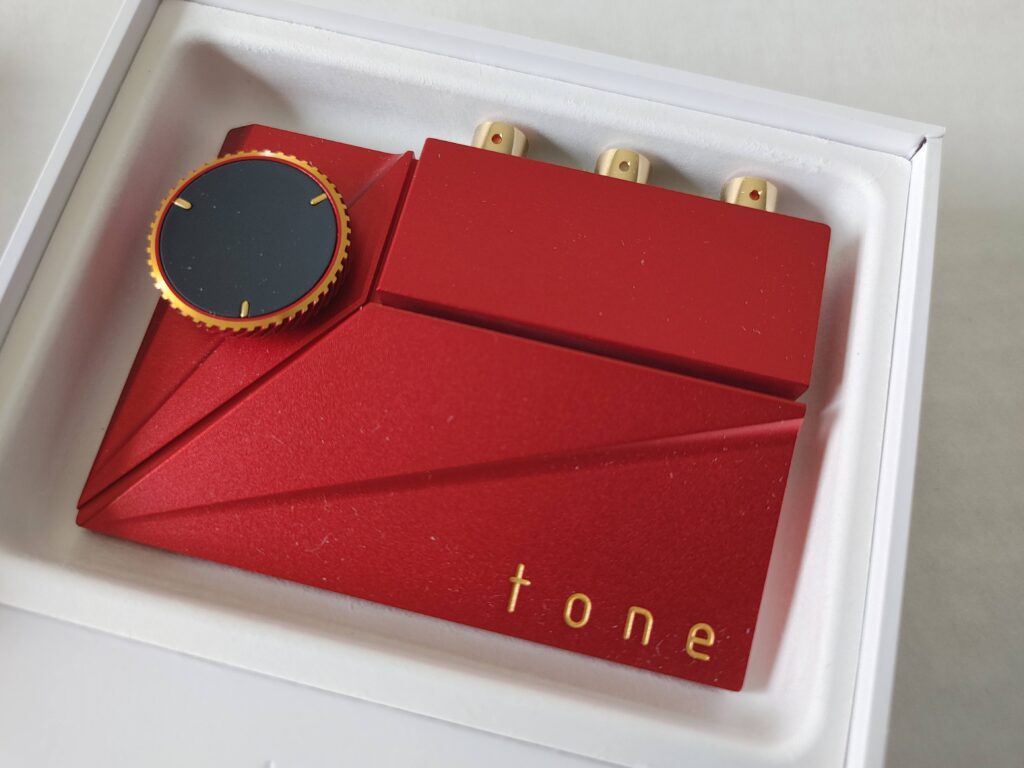
The only issue I had with it was the confusing control scheme. It works, but it’s rather hard to follow and will take some time to get used to. If you can get past this, the Tone 2 Pro is a compelling DAC/Amp option for those who want a tiny yet flexible device.
Read on for the complete rundown of this fascinating piece of gear!

Key Features:
If you’ve never heard of Khadas, don’t feel bad. Before this review, I didn’t know about them either. When I was offered the Tone2 Pro for review, the design and feature list piqued my interest.
However, I still like to do my due diligence regarding the manufacturer of a product. Thru research, I found out they’re a Chinese company that specializes in mini-computer boards for the DIY market (similar to the Raspberry Pi).
They appeared on the DIY audiophile radar a couple of years back with a compact DAC/audio Card called the Tone Board (now Tone 1). It’s a bare board audio card that incorporates an ESS DAC chip.
Despite being a bare board, which means it has no casing, the $99 Tone Board stirred up some buzz as a budget DAC option since it has a USB power connection and RCA outputs. Folks built cases for them and plugged them into headphone amps. The buzz grew so loud that it even made an appearance on the popular YouTube channel Z Reviews.

In an attempt to build upon that success, Khadas came out with the product we’re reviewing today, the $199 Tone2 Pro DAC/Headphone Amp. The Tone 2 Pro is for those who may like the Tone Board's sound quality but want a finished DAC design, and the 2 Pro delivers that along with a pretty powerful headphone amp section.
Like the Tone Board, the Tone 2 Pro is based around the much desired ESS ES9038Q2M DAC chip. That chip has been paired with four TI OPA1612 operational amplifiers (said to be some of the quietest on the market) and three buffer amplifiers.
According to Khadas, this 3-stage amplification pathway allows their newest DAC to drive a wide range of power-hungry headphones (up to 150 ohms impedance recommended).
For the Tone2 Pro, Khadas placed their compact DAC board inside an angular aluminum enclosure (comes in red, blue, or black) about the size of a credit card. The slimline case has a knurled aluminum volume/control knob (which is very smooth) on top, surrounded by an RGB ring light for visual feedback. The whole package is pretty snazzy looking and sturdy to boot.
The bottom of the enclosure is an anti-slip rubber pad that helps keep the device in place, but don’t expect total stability since it’s rather lightweight. A heavy headphone cable will cause it to shift around a bit.
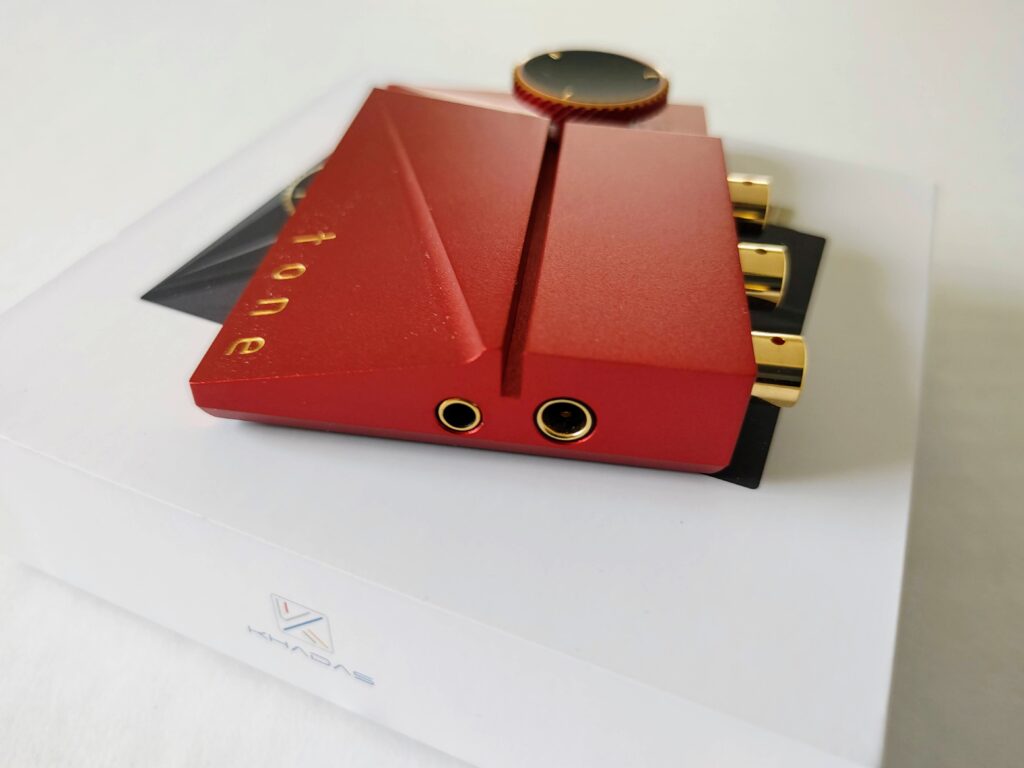
On the side of the Tone2 Pro is a 4.4mm balanced headphone jack, along with a 3.5mm single-end jack, and on the rear are two balanced RCA jacks (a Khadas standard), a coaxial digital input for CD Transports, plus two USB-C connections. The balanced RCA connectors are the first of their kind. So to use them, you have to purchase special cables from Khadas. I didn’t receive those cables, so I didn’t have an opportunity to test the balanced output.
As stated before, there are two USB ports. Each performs a different function. One port is for power/external modules (I2S), and the other is a digital input for laptops or smartphones. Khadas says the I2S USB port will support a future Bluetooth module compatible with premium BT codecs like aptX HD or LDAC.
When it comes to features, the Tone2 Pro has tons of them, which is a blessing and a curse. That’s because, to access many functions, you’re locked into a frustrating control scheme based around the volume knob and the LED ring surrounding it.
For example, if you want to change the gain from low to high, you have to press the knob down twice (not easy), then scroll to the mode you want to set. To know what mode you are selecting, you have to count red lights on the LED ring, which are not easy to see. By the way, good luck remembering how many lights signify what.

To access Gain mode, you must scroll the wheel to reveal three red lights, and then you have to press the knob again. At that point, you have to double press the wheel another time to go through yet more color codes on the LED ring. In this case, it’s two different combinations of green and red lights for high/low gain, which are still not easy to see or memorize.
There are several more color combos for the other modes like DAC Filters or Input, and I had to look at the instruction booklet every time to see what I was doing.
The DAC’s visual indicators for file format and volume level are also mapped to the LCD ring, which means you have to remember even more lighting combinations to check operational status.
That said, it’s nice to have so many options (Inputs, Filters, Gain) on such a compact unit, but I wish they were easier to access.
Listening to the Khadas Tone2 Pro DAC/Headphone Amp
For my sound tests, I primarily hooked up the Tone 2 Pro to my laptop and used Tidal as a source. Upon connecting the included USB-C to USB-C cable to my HP Envy X360’s USB-C port, the WASAPI driver was installed quickly. If you want to play DSD files or high sample rate PCM, you have to download a driver from the Khadas website.
I hooked up several different headphones to the Tone2 Pro, and it showed itself to be quite powerful for its size. It even did a decent job running the relatively hard-to-drive Mr. Speakers (now Dan Clark Audio) Aeon Flow Closed on high gain mode. I did have to crank the volume to about 60-75%, but the sound was full and rich.
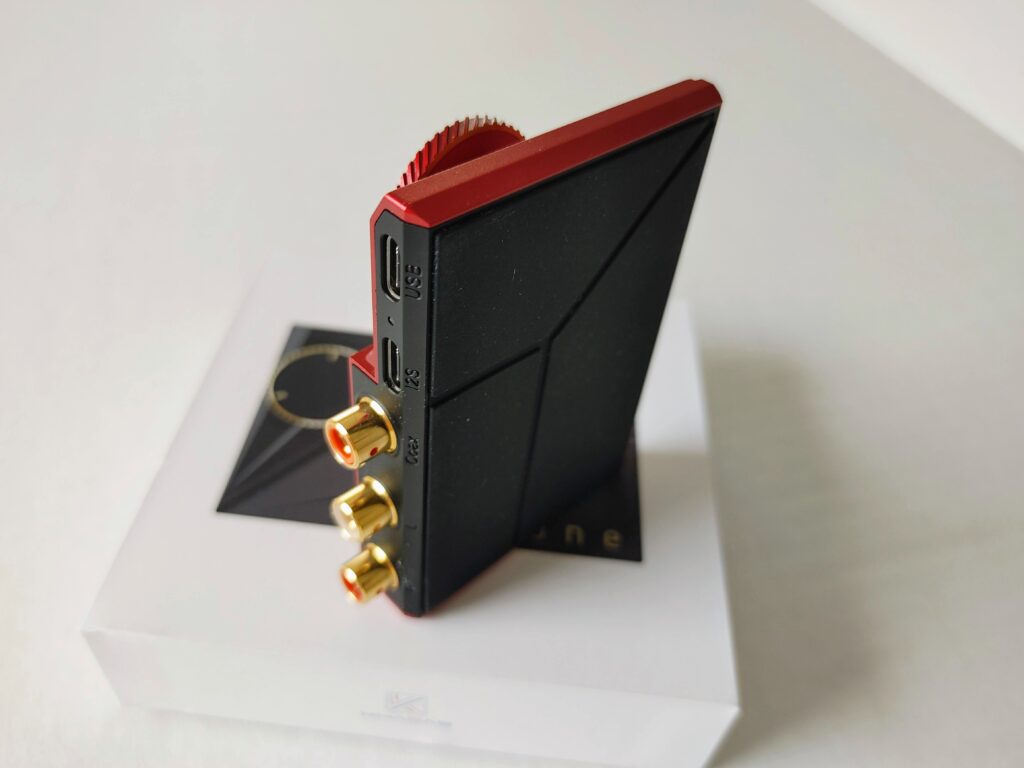
It did even better with more sensitive headphones like the Focal Elear, Beyerdynamic T5 (3rd Gen), Hifiman Sundara, and Sennheiser/Drop HD 58X Jubilee. My favorite pairing was the Sundara, which had just the right amount of detail and warmth to bring out the best of the Tone2 Pro.
Like most ESS-based DACs, I have heard that the Tone 2 Pro had a clean, detailed sound that tended to come out on the cool side. While it definitely had that ESS “sparkle,” it wasn't quite as shimmery as some of the ESS implementations I have heard, which allowed the sound to breathe a little bit better.
That said, there was definitely some emphasis on the upper midrange, which can be edgy on certain songs, but overall the sound was very clean and balanced. There was no trace of the noisiness that plagues other budget DAC/Amps.
As far as the DAC section was concerned, the separation of elements in the mix was decent for the price. On the song “Teach You” from Emily King’s “Sides” album, voices and instruments were credibly reproduced, but the presentation didn’t quite have the depth and air you would get at a higher price point.
However, the Tone2 Pro did provide nice weight and presence, which made it engaging. That carried over to the RCA outputs, which played loudly and cleanly into my hi-fi rig.
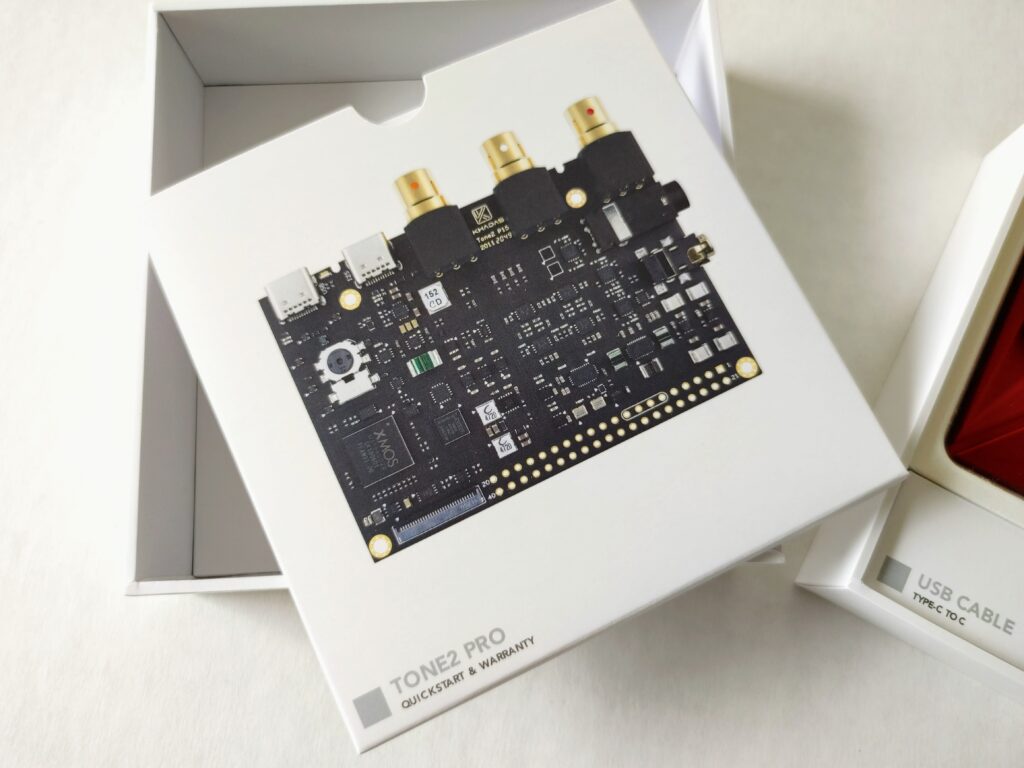
Compared to the iFi Hip Dac
I chose the $149 iFi Hip Dac for a comparison unit, which has a similar feature list and costs just a little bit less than the Tone2 Pro. As far as power was concerned, I would give the Hip-Dac a slight edge as it could drive the Aeon Flow Closed headphones a little harder than the Tone2 Pro. It was also a whole lot easier to select high-gain mode on the Hip-Dac using the “power match” button on the front.
However, the Hip-Dac didn’t have the RCA connections of the Tone2 Pro nor the extra USB port for expandability. The Tone2 Pro was also more detailed on the top-end than the iFi DAC, providing a little more sparkle and separation. It also had a little bit more depth in the mids.
That said, some may like the warmer, more rounded-off sound of the Hip-Dac over the cold crispness of the Khadas product, especially if they have a brighter headphone. To me, the iFi DAC is a little more organic. On the other hand, the Tone2 Pro will probably match better with warmer, darker headphones as it will open them up a bit.
The Wrap Up
The Khadas Tone2 Pro is a very well-built and powerful DAC/Amp, which offers more connection options than other devices its size. It has a very clean and detailed sound which is sure to open up darker, warmer headphones. It also has a wealth of features, including full MQA decoding (remarkable at this price point!), DSD compatibility and seven different DAC filters.
The only issue I have with the Tone2 Pro is the confounding control setup. If you can master that, you will find this flexible device to have a lot going. Those looking for a space-saving DAC/Amp with good power, clean output, and a lot of connections should check out the Tone2 Pro.
This review was originally posted at hifitrends.com: http://hifitrends.com/2021/02/22/kh...onary-dac-amp-will-make-your-headphones-sing/
Their compact size coupled with their affordability makes them an ideal way to upgrade a smartphone or laptop's sound while on the go.
Recently, I was really wowed by the $99 HELM Audio Bolt DAC/AMP, which offers amazing THX Certified sound and MQA/DSD compatibility in a ridiculously small package.
However, these dongle or USB Stick (think AudioQuest Dragonfly) style DAC/Amps do have their limitations. For example, If you need a line output other than the 3.5mm jack, a digital input, or even physical controls in most cases, you’re out of luck.
If that’s something you’ve come up against, then the $199 Khadas Tone 2 Pro DAC/Headphone Amp may be just what the doctor ordered. It’s not that much bigger than an Audioquest Dragonfly, yet it has all the stuff mentioned above.
Not only that, it has two balanced outputs (both 4.4mm and Line Out), which is remarkable for its size.
We put the Tone2 Pro through its paces and found it to be a very competent performer. It plays all major music file formats (PCM, DSD, MQA full unfold!), plus the sound was balanced, layered, and clean. It’s also built well, utilizing a slick-looking aluminum frame and control knob.

The only issue I had with it was the confusing control scheme. It works, but it’s rather hard to follow and will take some time to get used to. If you can get past this, the Tone 2 Pro is a compelling DAC/Amp option for those who want a tiny yet flexible device.
Read on for the complete rundown of this fascinating piece of gear!

Key Features:
- DAC + Headphone Amplifier - Uses top-of-the-line ESS ES9038Q2M Sabre DAC Chip with 4 super-quiet TI OPA1612 operational amplifiers.
- Hi-Res Decoding - Up to 32bit 384KHz sample rate for PCM and bit-perfect DSD512.
- Full Hardware MQA Decoding - XMOS XU216 processor for full MQA decoding.
- Balanced RCA - Innovative "balanced RCA line-out" with 3-pin output
- Linear Power Supply Compatible - Tone2 Pro has a second USB-C (I2S) port that supports 5V linear power supplies.
- Coaxial Input - Solid connection for CD-Transports
- Digital Filters- 7 digital filters to tweak the sound with.
If you’ve never heard of Khadas, don’t feel bad. Before this review, I didn’t know about them either. When I was offered the Tone2 Pro for review, the design and feature list piqued my interest.
However, I still like to do my due diligence regarding the manufacturer of a product. Thru research, I found out they’re a Chinese company that specializes in mini-computer boards for the DIY market (similar to the Raspberry Pi).
They appeared on the DIY audiophile radar a couple of years back with a compact DAC/audio Card called the Tone Board (now Tone 1). It’s a bare board audio card that incorporates an ESS DAC chip.
Despite being a bare board, which means it has no casing, the $99 Tone Board stirred up some buzz as a budget DAC option since it has a USB power connection and RCA outputs. Folks built cases for them and plugged them into headphone amps. The buzz grew so loud that it even made an appearance on the popular YouTube channel Z Reviews.

In an attempt to build upon that success, Khadas came out with the product we’re reviewing today, the $199 Tone2 Pro DAC/Headphone Amp. The Tone 2 Pro is for those who may like the Tone Board's sound quality but want a finished DAC design, and the 2 Pro delivers that along with a pretty powerful headphone amp section.
Like the Tone Board, the Tone 2 Pro is based around the much desired ESS ES9038Q2M DAC chip. That chip has been paired with four TI OPA1612 operational amplifiers (said to be some of the quietest on the market) and three buffer amplifiers.
According to Khadas, this 3-stage amplification pathway allows their newest DAC to drive a wide range of power-hungry headphones (up to 150 ohms impedance recommended).
For the Tone2 Pro, Khadas placed their compact DAC board inside an angular aluminum enclosure (comes in red, blue, or black) about the size of a credit card. The slimline case has a knurled aluminum volume/control knob (which is very smooth) on top, surrounded by an RGB ring light for visual feedback. The whole package is pretty snazzy looking and sturdy to boot.
The bottom of the enclosure is an anti-slip rubber pad that helps keep the device in place, but don’t expect total stability since it’s rather lightweight. A heavy headphone cable will cause it to shift around a bit.

On the side of the Tone2 Pro is a 4.4mm balanced headphone jack, along with a 3.5mm single-end jack, and on the rear are two balanced RCA jacks (a Khadas standard), a coaxial digital input for CD Transports, plus two USB-C connections. The balanced RCA connectors are the first of their kind. So to use them, you have to purchase special cables from Khadas. I didn’t receive those cables, so I didn’t have an opportunity to test the balanced output.
As stated before, there are two USB ports. Each performs a different function. One port is for power/external modules (I2S), and the other is a digital input for laptops or smartphones. Khadas says the I2S USB port will support a future Bluetooth module compatible with premium BT codecs like aptX HD or LDAC.
When it comes to features, the Tone2 Pro has tons of them, which is a blessing and a curse. That’s because, to access many functions, you’re locked into a frustrating control scheme based around the volume knob and the LED ring surrounding it.
For example, if you want to change the gain from low to high, you have to press the knob down twice (not easy), then scroll to the mode you want to set. To know what mode you are selecting, you have to count red lights on the LED ring, which are not easy to see. By the way, good luck remembering how many lights signify what.

To access Gain mode, you must scroll the wheel to reveal three red lights, and then you have to press the knob again. At that point, you have to double press the wheel another time to go through yet more color codes on the LED ring. In this case, it’s two different combinations of green and red lights for high/low gain, which are still not easy to see or memorize.
There are several more color combos for the other modes like DAC Filters or Input, and I had to look at the instruction booklet every time to see what I was doing.
The DAC’s visual indicators for file format and volume level are also mapped to the LCD ring, which means you have to remember even more lighting combinations to check operational status.
That said, it’s nice to have so many options (Inputs, Filters, Gain) on such a compact unit, but I wish they were easier to access.
Listening to the Khadas Tone2 Pro DAC/Headphone Amp
For my sound tests, I primarily hooked up the Tone 2 Pro to my laptop and used Tidal as a source. Upon connecting the included USB-C to USB-C cable to my HP Envy X360’s USB-C port, the WASAPI driver was installed quickly. If you want to play DSD files or high sample rate PCM, you have to download a driver from the Khadas website.
I hooked up several different headphones to the Tone2 Pro, and it showed itself to be quite powerful for its size. It even did a decent job running the relatively hard-to-drive Mr. Speakers (now Dan Clark Audio) Aeon Flow Closed on high gain mode. I did have to crank the volume to about 60-75%, but the sound was full and rich.

It did even better with more sensitive headphones like the Focal Elear, Beyerdynamic T5 (3rd Gen), Hifiman Sundara, and Sennheiser/Drop HD 58X Jubilee. My favorite pairing was the Sundara, which had just the right amount of detail and warmth to bring out the best of the Tone2 Pro.
Like most ESS-based DACs, I have heard that the Tone 2 Pro had a clean, detailed sound that tended to come out on the cool side. While it definitely had that ESS “sparkle,” it wasn't quite as shimmery as some of the ESS implementations I have heard, which allowed the sound to breathe a little bit better.
That said, there was definitely some emphasis on the upper midrange, which can be edgy on certain songs, but overall the sound was very clean and balanced. There was no trace of the noisiness that plagues other budget DAC/Amps.
As far as the DAC section was concerned, the separation of elements in the mix was decent for the price. On the song “Teach You” from Emily King’s “Sides” album, voices and instruments were credibly reproduced, but the presentation didn’t quite have the depth and air you would get at a higher price point.
However, the Tone2 Pro did provide nice weight and presence, which made it engaging. That carried over to the RCA outputs, which played loudly and cleanly into my hi-fi rig.

Compared to the iFi Hip Dac
I chose the $149 iFi Hip Dac for a comparison unit, which has a similar feature list and costs just a little bit less than the Tone2 Pro. As far as power was concerned, I would give the Hip-Dac a slight edge as it could drive the Aeon Flow Closed headphones a little harder than the Tone2 Pro. It was also a whole lot easier to select high-gain mode on the Hip-Dac using the “power match” button on the front.
However, the Hip-Dac didn’t have the RCA connections of the Tone2 Pro nor the extra USB port for expandability. The Tone2 Pro was also more detailed on the top-end than the iFi DAC, providing a little more sparkle and separation. It also had a little bit more depth in the mids.
That said, some may like the warmer, more rounded-off sound of the Hip-Dac over the cold crispness of the Khadas product, especially if they have a brighter headphone. To me, the iFi DAC is a little more organic. On the other hand, the Tone2 Pro will probably match better with warmer, darker headphones as it will open them up a bit.
The Wrap Up
The Khadas Tone2 Pro is a very well-built and powerful DAC/Amp, which offers more connection options than other devices its size. It has a very clean and detailed sound which is sure to open up darker, warmer headphones. It also has a wealth of features, including full MQA decoding (remarkable at this price point!), DSD compatibility and seven different DAC filters.
The only issue I have with the Tone2 Pro is the confounding control setup. If you can master that, you will find this flexible device to have a lot going. Those looking for a space-saving DAC/Amp with good power, clean output, and a lot of connections should check out the Tone2 Pro.
This review was originally posted at hifitrends.com: http://hifitrends.com/2021/02/22/kh...onary-dac-amp-will-make-your-headphones-sing/
Last edited:
OceanPoet
Great write-up.
cash1489
New Head-Fier
Pros: Sexy Design
Will Drive Any Headphone With Authority
Clean Sound/Remarkable Detail/Separation
Will Drive Any Headphone With Authority
Clean Sound/Remarkable Detail/Separation
Cons: Not The Best Match For Very Sensitive Headphones/IEMs
IFi's Latest Portable Dac/Amp Combo Has Unrivaled Power And Refinement At Its Price!
It’s no secret that I have a bit of a soft spot for iFi products. Their combination of innovative design, thoughtful features, and build quality is unmatched at their price points. They always seem to give you more for your money.The previously reviewed iFi Hip Dac was a beautiful sounding DAC with tons of nice features for $149. The iFi NEO iDSD Desktop Dac/Amp ($799), which we also reviewed, was equally good with its beautiful design and reference sound quality.
Summary
iFi's latest product, the $899 iDSD Diablo, is their new flagship portable/transportable DAC/Amp with a bright red curvy exterior reminiscent of a flashy sports car.The sports car parallels don’t end there, with iFi describing the Diablo as “a racing car designed for uncompromising speed,” stripped of all extras and tuned to provide “pure sonic power.”
The idea is that just like a supercar stripped of inessential stuff (like an air conditioning unit) to go as fast as possible, Diablo only has what it needs to provide pristine D to A conversion and tons of clean power to power-hungry flagship headphones.
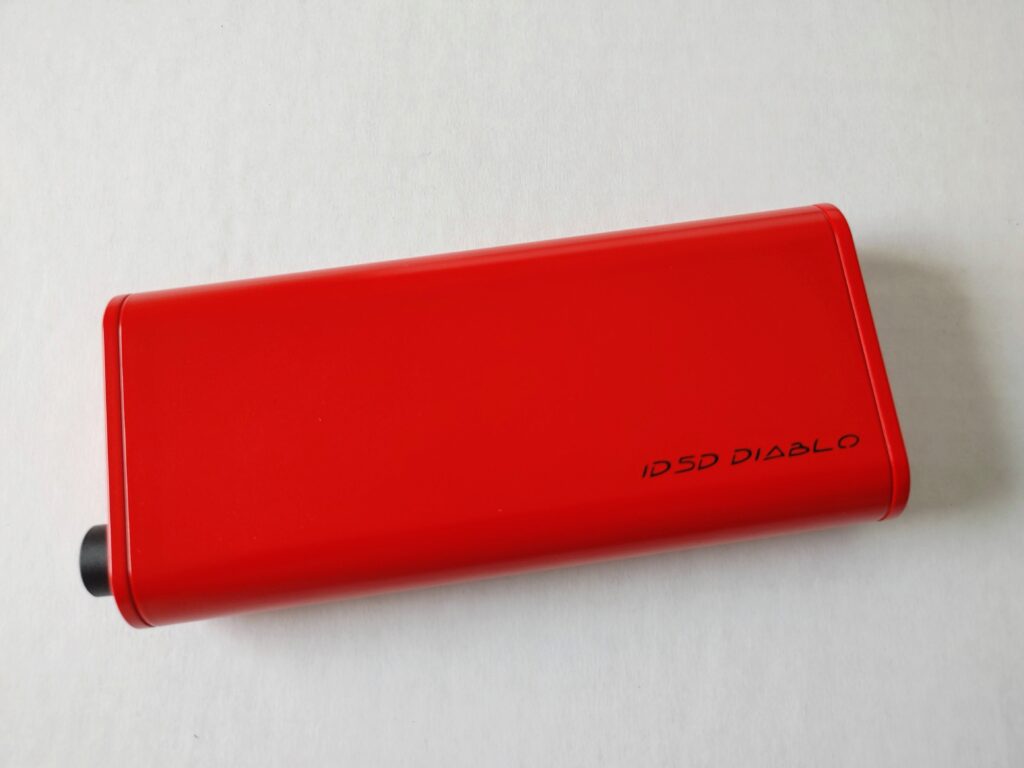
That means no niceties like XBass boost or 3D signal processing, something iFi fans have come to expect on their Dac/Amp combos. This is a direction iFi has taken on several of its higher-end products, like the Pro iDSD and the Neo iDSD. Pure signal and the best sound possible is the goal.
If that’s not enough sports car parallels, there’s also a super-powerful high-gain mode called “Turbo.”
The Diablo is for those looking to take battery-powered reference sound on the go. It’s primarily for the guy or gal who’s looking to get the best sound possible out of their power-hungry flagship cans without dragging an expensive (and heavy) desktop rig around.

The sound is actually good enough that it could replace a lot of desktop setups. That's while still being small enough to take from room to room.
Full MQA decoding is also on board, meaning you will get fully optimized hi-res sound from Tidal Masters.
iFi’s exquisite new iTraveller bag, which can carry the amp, a DAP, and many accessories, is also thrown in for free. That enormously sweetens the pot.
Disclaimer: The iDSD Diablo was sent to us in exchange for a thorough and honest review. No input was given regarding the content written.
Build/Features
As stated earlier, the iDSD Diablo has a nice curved metal case with a beautiful “candy apple red” paint job, and it looks rather sleek at 6.5 inches long by 1 inch high. It’s slightly smaller than iFi’s recently released micro iDSD Signature; a transportable Dac/Amp combo positioned right below the Diablo.It has small rubber feet on the bottom so you can set it on a surface without slipping, a nice touch that also helps protects the finish.
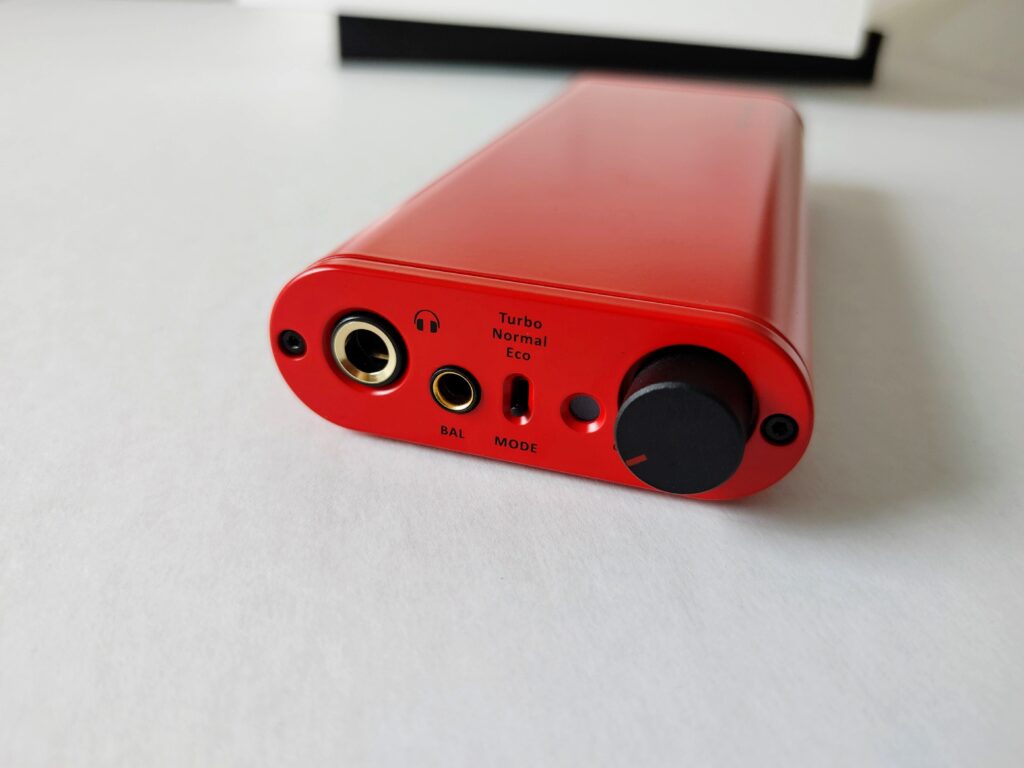
There’s a combination analog/power knob on the front panel that has a nice feel to it, along with two headphone jacks, one ¼” single-ended, and one 4.4mm balanced. There’s also a three-position gain switch marked Turbo, Normal, or Eco, with Turbo, of course, representing the highest gain, Normal the middle level, and Eco the lowest setting.
There’s also an led that indicates audio format and frequency, with seven different colors representing the range of files it supports:
Yellow: PCM 48/44.1kHz
White: PCM 768/705.6/384/352.8/192/176.4/
96/88.2kHz
Cyan: DSD 128/64
Red: DSD 512/256
Green: MQA
Blue: MQA Studio
Magenta: Original Sample Rate (MQA)
Of course, a screen with the actual format and number on it would be more helpful, but I’m willing to sacrifice that in exchange for a slimmer unit. As you can see, the Diablo supports any format you choose.
On the rear, you have a Male USB3.0 Type-A input for audio data and a separate USB-C port for charging the internal battery. The Male Type-A port is nice since it will directly support some Apple Camera Adapter cables and USB OTG cables.
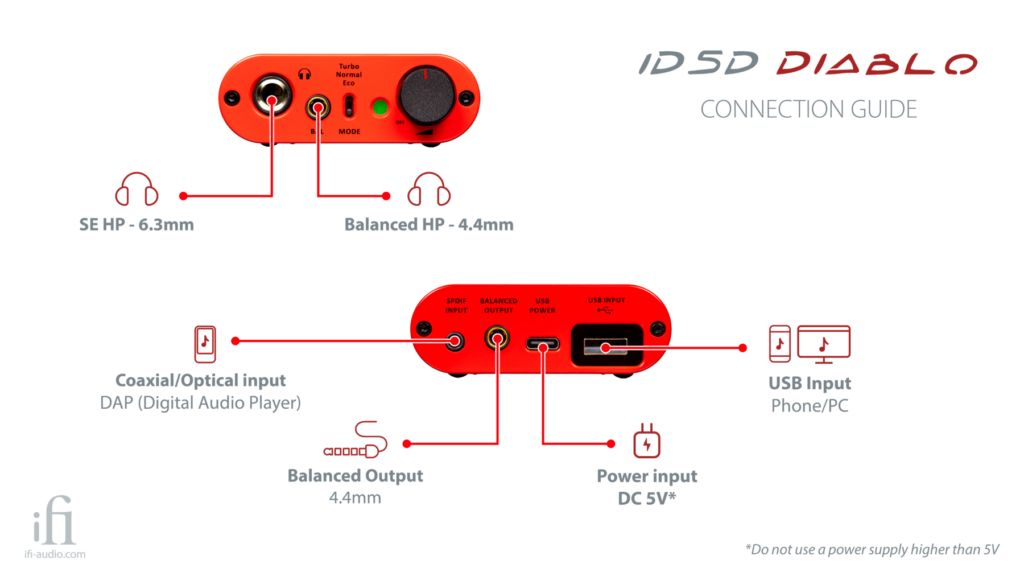
The USB-C port supports fast charging (about 6 hours to a full battery) using the included iFi iPower adapter. Below the port is a Battery Status LED that goes from White (full) to Green (around ½ full) to Red (Empty).
While you can leave the Diablo plugged in and run it off of wall power, it switches to battery power once it's unplugged. Approximate listening time depends on the gain and headphones used. In Eco mode, expect up to 10 hours, Normal up to 8 hours, and Turbo around 4-5 hours.
Next to the USB charging port is a balanced 4.4mm output, which sends a signal directly from the true balanced circuitry to an amp with a balanced input. The Diablo comes with a 4.4mm to Twin XLR cable in the box, a nice touch.
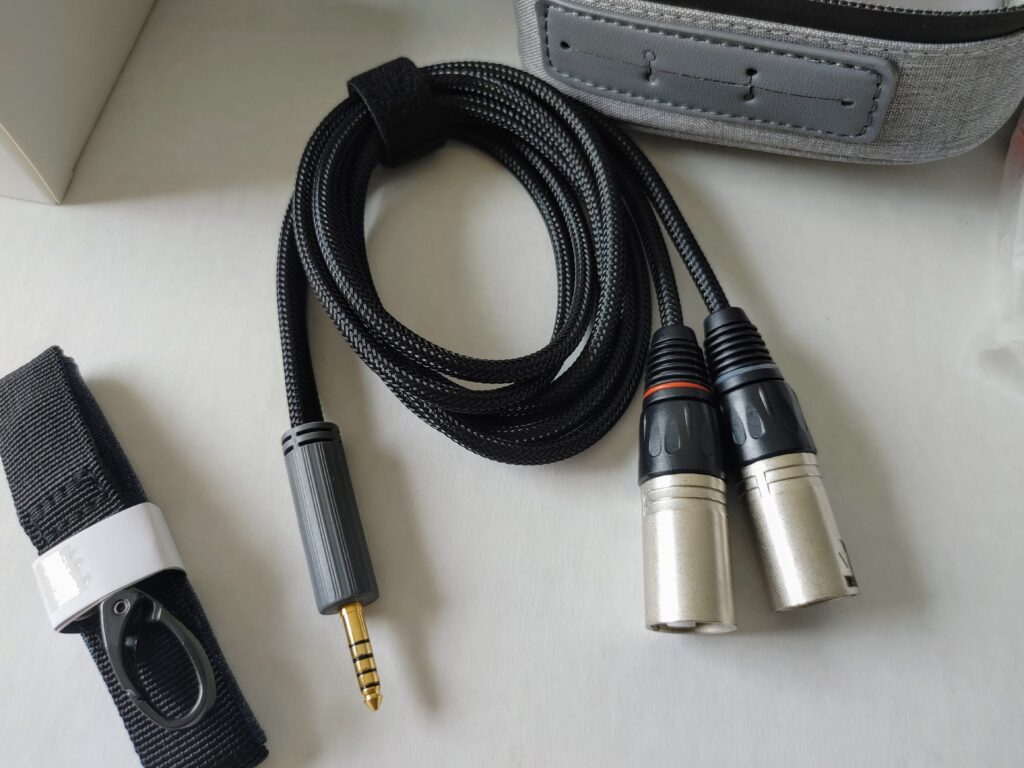
A single-ended line out would’ve been nice, but according to iFi, this would’ve necessitated unnecessary circuitry in a straight signal path and used up too much real estate on the rear panel. These are decisions I can live with if it means a better signal into my headphones.
Speaking of real estate on the rear panel, the Diablo also has a combination Coax/Optical 3.5mm SPDIF input next to the balanced output, which allows you to hook up CD players or Digital Audio Players. You can even send MQA from MQA-CDs into this connection if that’s your cup of tea.
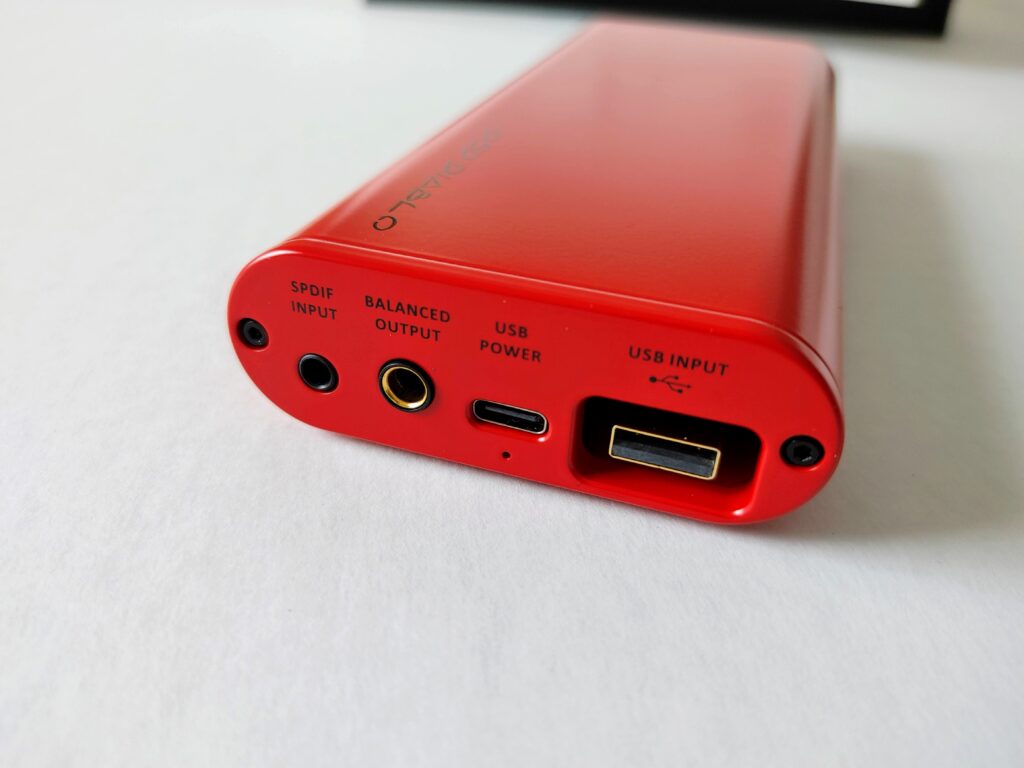
However, with iFi DACs, what’s inside the case is often the real story, and that’s no different here. In the Diablo, you get a dual-core Burr-Brown DAC chipset, upgraded Zero Jitter/Femto clock system, ultra-low noise Op-Amps, OS-CON polymer capacitors, and Panasonic audio-grade film capacitors. There's also the powerful Xmos chip which allows advanced processing for things like MQA decoding.
[caption id="attachment_8338" align="alignnone" width="640"]
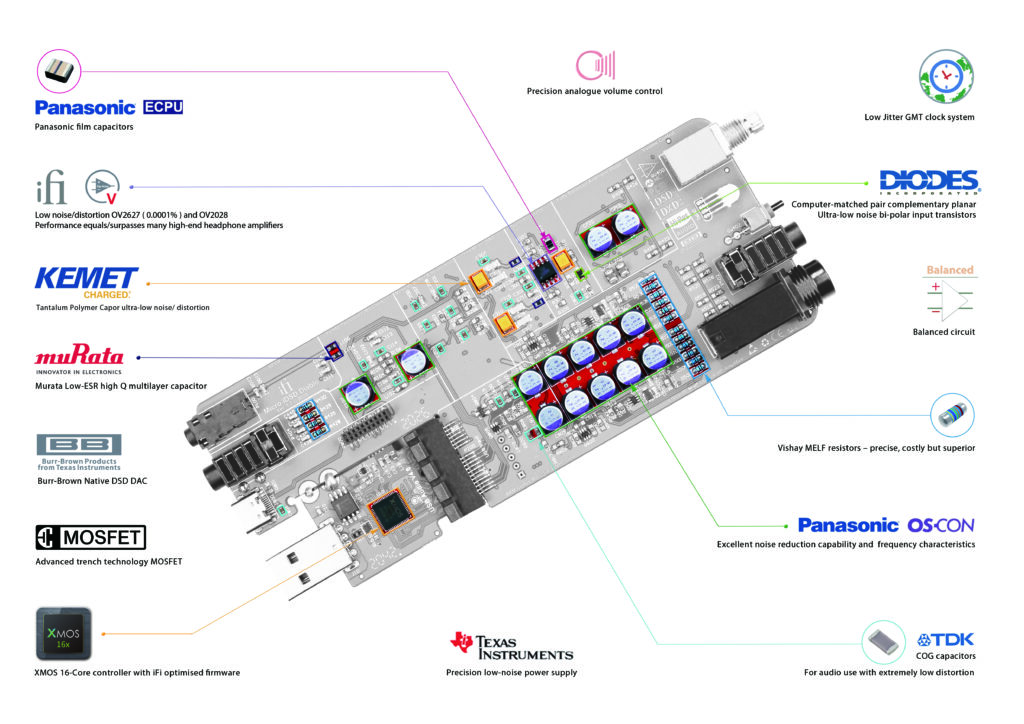 iDSD Diablo (components)[/caption]
iDSD Diablo (components)[/caption]Again, this is all in a fully-balanced configuration instead of the quasi-balanced scheme used in some of their other products.
When it comes to accessories, you get a bunch with the iDSD Diablo, including an iFi iPower adapter made specifically for this DAC, a power adapter cable so you can plug it into the USB-C port, A USB-C to USB-A cable, a USB-C 3.0 data cable, a ¼” to 3.5mm headphone adapter, and a Toslink to mini-Toslink adapter for the digital input.
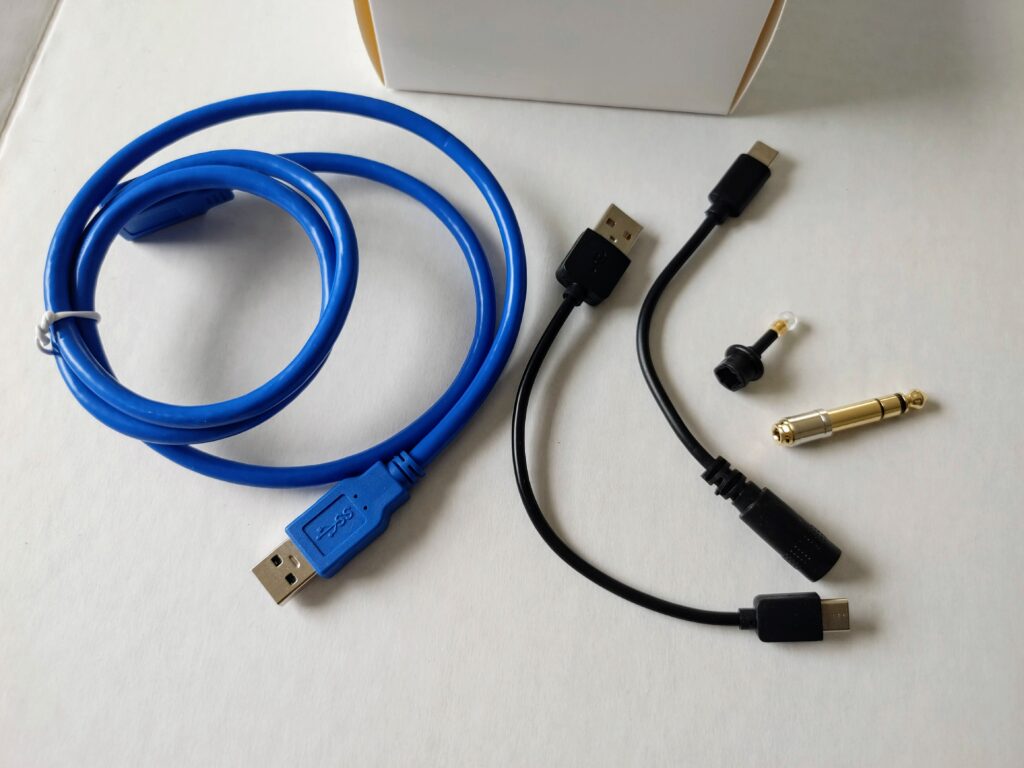
That’s quite the haul, but the best part of the accessory pack has to be the iTraveller case. Not only does it look good, but it will also carry everything that comes with this DAC and then some.
While that's an option, the case is actually designed to carry the DAC along with a source (a smartphone or DAP) and a pair of IEMs for on-the-go listening. It also has holes on the side to feed in a pair of full-size headphones and play some music while carrying the bag around.

That would be a heavy load, but you could do it. In any case, this bag is a godsend for the road warrior. It’s also sold separately if you’re interested.
Listening to the iDSD Diablo DAC/Amp Combo
For my listening tests, I connected the iDSD Diablo to my Android test phone, a Moto G Fast (2020) with the UAPP app installed, and an HP Envy X360 laptop with the Tidal app installed.I played MQA from both sources into my Mr. Speakers (Now Dan Clark Audio) Aeon Flow Closed Planar Headphones, and I could tell right away this DAC/Amp was something special.
First of all, the amp section's power was massive, even in the low gain “Eco” setting using the single-ended connection. On most battery-powered amps, I have to set the amp to high-gain right away even to attempt to drive these headphones, but that was not a problem with the Diablo.

A little more than a quarter-turn up to a half turn on the volume knob drove the AFC headphones to their full potential, with full robust bass and dynamics. That’s quite remarkable, considering a quarter turn is needed just to turn the unit on. On the single-ended output, you're getting 2417 mW at 32 Ohms, which is crazy for such a compact device. That's on par with Class-A desktop headamps.
iDSD Diablo Headphone Max Output:
Balanced
>19.2V/611 mW (@ 600 Ohm)
>12.6V/4,980 mW (@ 32 Ohm)
Single-Ended
>9.6V/153 mW (@ 600 Ohm)
>8.8V/2,417 mW (@ 32 Ohm)
That does cause a dilemma with sensitive IEMs and Headphones, as it will be difficult to get them to a volume level low enough to listen comfortably. I tried a pair of Kinera Freya IEMs (110 dB sensitivity), and it was too loud even on the lowest gain setting.
That said, I was astonished at how clean the power was, as the background sounded extraordinarily black for a portable unit. This made it very easy to hear the character of the recording space when present in the recording.
For example, on Duke Ellington’s “Afro-Bossa,” I was amazed at how clearly I could hear the room's reverberations in the recording.
This track also let me hear how well the DAC section did texture and layering, as it provided nice texture on the horns and percussion.
It also did a good job at separating the elements, presenting the percussion instrument dead in the center of my head stage to the rear, then surrounding it with horns to the front left and right. I loved how the iDSD Diablo could blend the various melodies while keeping the instruments in their own little bubbles.
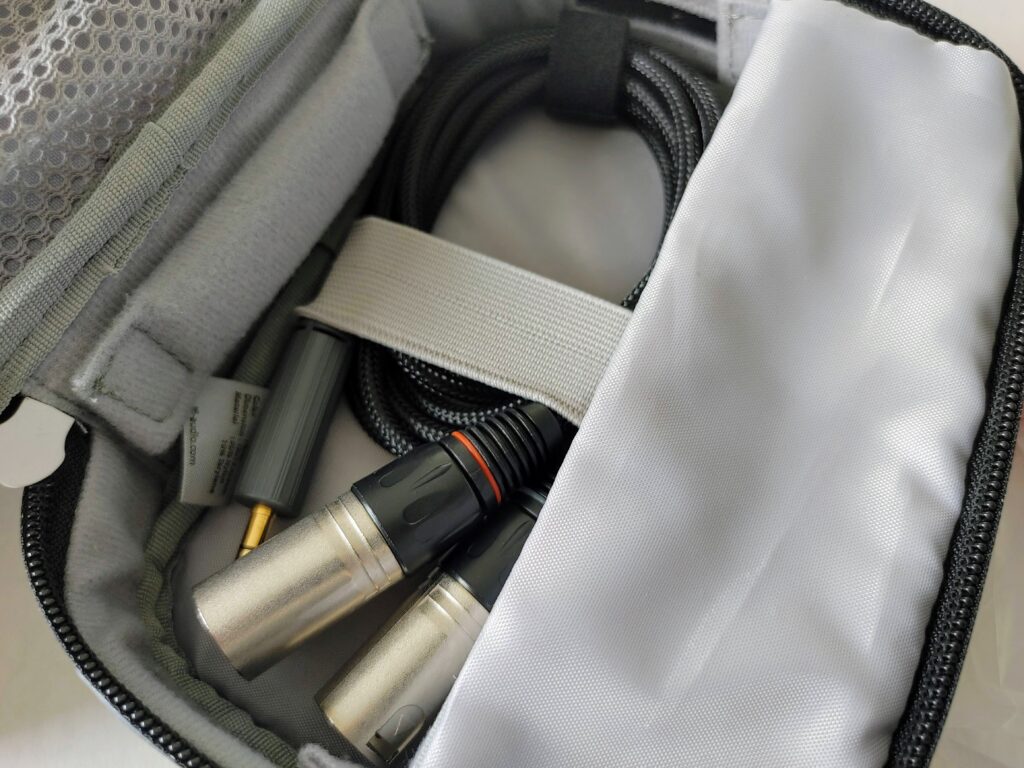
The way it presented trailing notes throughout the time domain was nice as well; it added some realism to this dynamic recording.
On Kurt Elling’s “September In The Rain,” I got more room ambiance, with Kurt’s voice sounding very nuanced, just like l remember when I went to see him at the Chicago Jazz Festival. If I had any nitpick about the DAC section, it would be a lack of very sharp edge definition in the imaging, but that may be asking too much at this price point.
Overall, the iDSD Diablo trends towards a cooler, more neutral, reference-type sound than iFi’s lower-priced offerings, which tend to be warmer and lusher. That makes sense for an amp that’s clearly meant for headphones at the top of the food chain.
It's an approach similar to the one taken with their recently released desktop amp, the $699 NEO iDSD, which actually sounds a lot like the iDSD Diablo. The NEO has similar crispness up top, similar separation, and a similar fine texture is given to instruments and vocals.
The difference is the iDSD Diablo is the more powerful amp even though the NEO iDSD is a Desktop model. The Diablo gave the Aeon Flow Closed a more dynamic sound with greater gravitas on the bottom end.
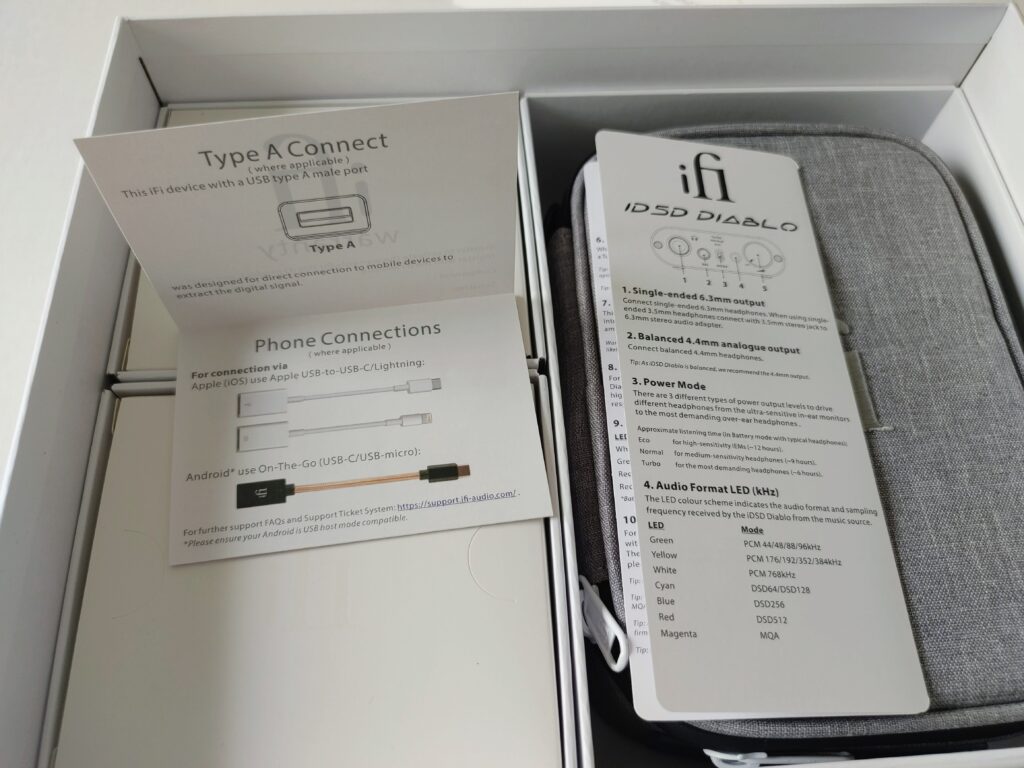
However, with the Diablo, I heard a little edginess up top on certain songs, something I didn’t hear on the NEO iDSD.
I also compared the Diablo to my Topping A90/D90 Desktop Amp and Dac ($1350 as a set), which was better sounding overall. It was a little cleaner than the Diablo with an even blacker background, which allowed the mix elements to stand out even more than they did on the iFi combo.
The A90/D90 also had the added depth, layering, and edge definition I was missing from the Diablo, but that said, the Diablo sounded a little more open than the Topping set, making the presentation sound larger in my headphones, just a little less “in my head.”
The A90/D90 was better, but the iDSD Diablo gave me about 80% of the definition and all of the power in a much smaller package that I can take anywhere.
I know that many will be interested in how the Diablo compares to the $649 iFi Micro iDSD Signature, which has a similar form-factor and a few more convenience features like bass boost and 3D signal processing. Unfortunately, I haven't had the opportunity to hear it yet. I've read a lot of impressions from headphone enthusiasts who have used it, and from what I understand it has the warmer more lush sound present in iFi's other Zen, Nano, and Micro products while being more powerful and more refined. That's opposed to the flatter reference sound of the iDSD Diablo.
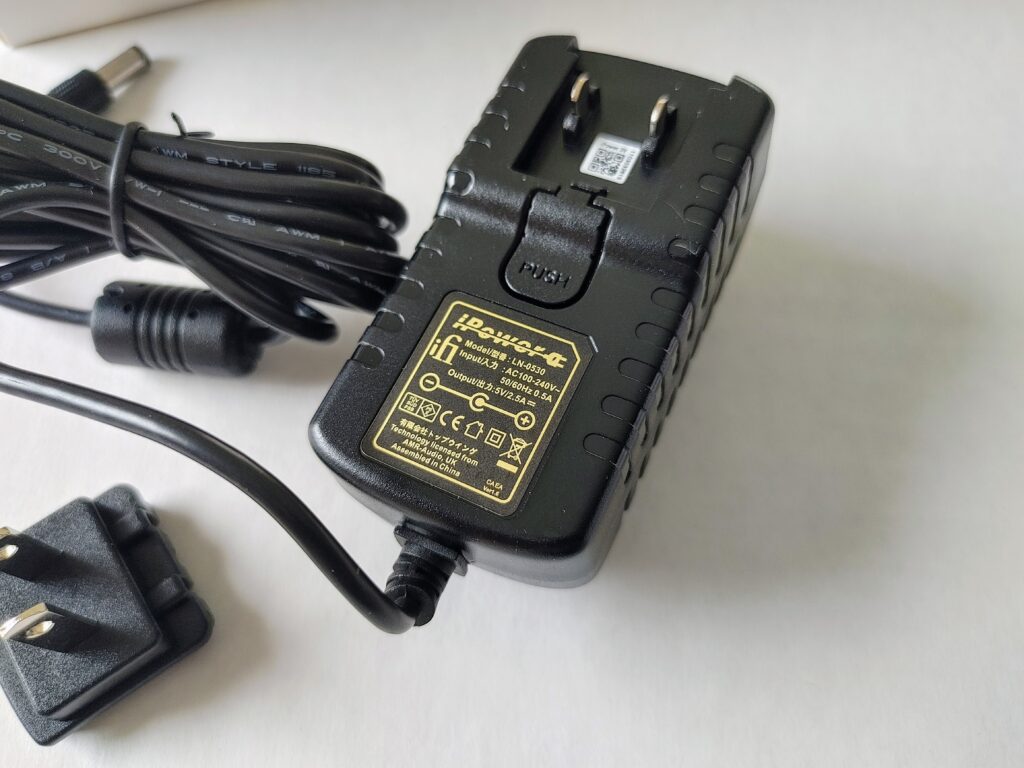
As far as headphone matches are concerned, I, of course, liked the Aeon Flow Closed with the iDSD Diablo, but the Focal Elear and Hifiman Sundara may have been even better matched soundwise. I really like how it added some depth and openness to the Sundara, so I can see it really doing well with some higher-end Hifiman Planars.
The Wrap Up
If you need a top-notch portable DAC/Amp combo that can drive your power-hungry flagship cans while on the go, the Diablo may be just what you need.I can see someone who wants to have a nice rig on the desk at work or someone who likes to move their rig around the house really digging this device.
Just keep in mind that the iDSD Diablo may not be a good match with very sensitive IEMs or headphones. If that works for you, then this stellar DAC/Amp combo with its beautiful design and premium accessory package is definitely worth a listen!
This review was originally posted at hifitrends.com: http://hifitrends.com/2021/03/11/ifi-idsd-diablo-review-the-best-portable-dac-amp-combo-under-1000/
Jimmyblues1959
Excellent review! 611 mw at 600 ohms and nearly 5 watts of power at 32 ohms in balanced mode? This is insane power for a portable headphone amp!
cash1489
New Head-Fier
Pros: Great Build Quality
Above Average ANC
Decent Sound
Above Average ANC
Decent Sound
Cons: BT Codecs Limited to SBC
This review orginally posted at hifitrends.com
http://hifitrends.com/2019/03/28/dyplay-urban-traveller-active-noise-cancelling-headphones/
The Dyplay Urban Traveller Bluetooth Active Noise Cancelling Headphones are wireless over the ear noise canceling headphones that as of this writing, sell for $79.99 on Amazon. Just looking at the specs I really didn’t expect much, but once I got them in my hand, I was pleasantly surprised at the quality of sound and construction. The sample I have was sent to me by the manufacturer in exchange for an honest review, and that is what follows.
Build/Features:
The Urban Traveller as the name suggests has a clean minimalist design that one can easily see hipsters rocking on the subway in some urban locale. I actually like the look of these, since I’m a fan of clean design, but the light matte gray color, which is the only color they come in, is not my cup of tea. I would really love to see these in either matte charcoal or matte black color, but then again my wife went crazy for the gray color and the overall design as well, so it seems there is an audience for it.
The headphones are mostly plastic, but the plastic seems to be good quality, and there are no creaking sounds or wobbling when you pick them up. All the parts are tightly fit together, some may be too tight. The adjustment arms for the earcups are made of metal, as are the joints which allow the earcups to fold up toward the headband. The only issue I had with these joints is that they were very stiff. It seems like they have some kind of mechanism to lock them down in place when you wear them. But when I tried to fold them up, it required a pretty good amount of force to make the joints bend, and they made a loud clicking noise that was disconcerting. Plus, with the amount of force it took to fold them up, it made me nervous about just grabbing the bottom of the cup and folding it. I pushed in at the joint itself and had no issues folding it that way.
As far as wearing comfort is concerned, the Urban Traveller is very easy to wear, they are actually more comfortable than my $400 Bowers and Wilkins ANC headphones. Head clamp is minimal, the protein leather earpads are very soft, and there is sufficient room in the earcup even for my relatively big ears. There’s also a memory gel strip that rests on the top of your head which adds to the comfort. I was able to wear them for long periods of time with no fatigue.
Controls on the earcup are laid out in an intuitive manner within easy reach of your fingers when you are wearing the headphones. On the right side, there are three buttons, the one in the middle controls power, Bluetooth pairing, playback of music. The other two situated above and below, control the volume along with track back and track forward when you hold the buttons down. This is a very common setup for Bluetooth headphones today. On the left earcup, there is a switch for the ANC, and it is also easy to reach when you have the headphones on but my only issue with it was it was very hard to push up and down. However, this is something that may loosen up over time. When the ANC is on, there is a small green led on the switch that shows it’s activated. On the other side is a multicolor blue/red led above the Volume Up button that indicates power status and Bluetooth pairing status.
Bluetooth pairing is quick and painless as with most Bluetooth devices nowadays and the BT 4.1 + EDR chip ensures a stable connection under most circumstances. The phone headset functionality is also par for the course, and quality was decent when I placed a phone call with them. The other party was able to hear me fine and I could hear them.
The Noise Cancelling was pretty good also. Even without the ANC switched on, the headphones cut out a lot of noise passively, but when I turned it on, it cut out a lot of the background whirring noises, like the fan on my laptop and my bathroom fan which is pretty loud. I would say about 90%. The volume of voices was reduced but not totally cut out, something that really only the most expensive ANC headphones really achieve. When compared to my AKG N60NC Wireless, which originally sold for over $300, they actually cut out a lot more noise. On the AKG, voices were cut about 50% and other sounds about 80%…but the Dyplay was more like 75/90. I was really impressed by how well they did for the price.
ANC can be turned on and off independently of the main power, which is nice if you just want to cut some noise without music, but you have to be careful to turn if off or you will kill the battery when you put them away. You can also play music using the included wire with or without the noise cancelling, which is also pretty cool since this allows you to preserve the battery. Battery life is rated at about 15 hours with either Bluetooth or ANC on individually and 12 hours with both of them on. This is a little low compared to other headphones like this, but it’s still respectable. It will get you through most flights, and through the workday.
As far as accessories go, you don’t get much, an instruction manual, micro USB charging cable, 3.5mm to 3.5mm cable for wired playback, and a hard case for storage, which is a nice touch, something that my AKG NC headphones didn’t even come with.
Sound:
Now if you know anything about this blog, you know it’s all about high fidelity sound. So the first thing I look at when I look at Bluetooth headphones is the audio codec. Usually, if a headphone doesn’t list what it is in the specs, then it’s probably SBC, which is basically the default lowest quality codec used by all Bluetooth headphones. I usually like to see at least aptX which can support CD-quality audio transfer. But codecs are not the only word in sound quality, part of the story is in the implementation of the data transfer and the quality of the drivers in the headphone.
In this case, the sound is respectable. The overall sound signature is what I would call bass-heavy, but to their credit, even though it’s elevated, the bass doesn’t overwhelm the other frequencies. Even though there is not a whole lot of detail, the highs are crisp enough to make things interesting, and the mids, which are actually their strong suit, are rich enough to anchor an overall fun sounding headphone. I listened to a bunch of different tracks, from hip-hop to jazz, and the fun non-fatiguing sound worked with just about everything I listened to.
I also compared the sound to my AKG N60nc Wireless headphones, and the AKG was pretty much richer and more detailed all the way around. But the one area which the Urban Traveller held it’s own with the AKG was in the mid-range. While the mids were more detailed on the AKG, the more forward mids on the Dyplay headphones gave them a more open sound.
Conclusion:
So, in the end, good looks, good build quality, excellent comfort, decent sound, and above average noise canceling makes this a good product for someone looking for a budget wireless noise cancelling headphone.
Specifications:
-Bluetooth version: 4.1+EDR
-Drivers: Φ40mm
-Frequency: 20Hz-20kHz
-Impedance: 30Ω
-Working Time: up to 15hrs (Bluetooth only)
-Working Time: up to 12hrs (Bluetooth+ANC)
-Working Time: up to 24hrs (ANC only)
-Operational Range: up to 33 feet
What’s in the box?
-dyplay Wireless Bluetooth Headphones
-3.5 mm Audio Cable
-USB Charging Cable
-Carrying Pouch
-Quick User Guide
http://hifitrends.com/2019/03/28/dyplay-urban-traveller-active-noise-cancelling-headphones/
The Dyplay Urban Traveller Bluetooth Active Noise Cancelling Headphones are wireless over the ear noise canceling headphones that as of this writing, sell for $79.99 on Amazon. Just looking at the specs I really didn’t expect much, but once I got them in my hand, I was pleasantly surprised at the quality of sound and construction. The sample I have was sent to me by the manufacturer in exchange for an honest review, and that is what follows.
Build/Features:
The Urban Traveller as the name suggests has a clean minimalist design that one can easily see hipsters rocking on the subway in some urban locale. I actually like the look of these, since I’m a fan of clean design, but the light matte gray color, which is the only color they come in, is not my cup of tea. I would really love to see these in either matte charcoal or matte black color, but then again my wife went crazy for the gray color and the overall design as well, so it seems there is an audience for it.
The headphones are mostly plastic, but the plastic seems to be good quality, and there are no creaking sounds or wobbling when you pick them up. All the parts are tightly fit together, some may be too tight. The adjustment arms for the earcups are made of metal, as are the joints which allow the earcups to fold up toward the headband. The only issue I had with these joints is that they were very stiff. It seems like they have some kind of mechanism to lock them down in place when you wear them. But when I tried to fold them up, it required a pretty good amount of force to make the joints bend, and they made a loud clicking noise that was disconcerting. Plus, with the amount of force it took to fold them up, it made me nervous about just grabbing the bottom of the cup and folding it. I pushed in at the joint itself and had no issues folding it that way.
As far as wearing comfort is concerned, the Urban Traveller is very easy to wear, they are actually more comfortable than my $400 Bowers and Wilkins ANC headphones. Head clamp is minimal, the protein leather earpads are very soft, and there is sufficient room in the earcup even for my relatively big ears. There’s also a memory gel strip that rests on the top of your head which adds to the comfort. I was able to wear them for long periods of time with no fatigue.
Controls on the earcup are laid out in an intuitive manner within easy reach of your fingers when you are wearing the headphones. On the right side, there are three buttons, the one in the middle controls power, Bluetooth pairing, playback of music. The other two situated above and below, control the volume along with track back and track forward when you hold the buttons down. This is a very common setup for Bluetooth headphones today. On the left earcup, there is a switch for the ANC, and it is also easy to reach when you have the headphones on but my only issue with it was it was very hard to push up and down. However, this is something that may loosen up over time. When the ANC is on, there is a small green led on the switch that shows it’s activated. On the other side is a multicolor blue/red led above the Volume Up button that indicates power status and Bluetooth pairing status.
Bluetooth pairing is quick and painless as with most Bluetooth devices nowadays and the BT 4.1 + EDR chip ensures a stable connection under most circumstances. The phone headset functionality is also par for the course, and quality was decent when I placed a phone call with them. The other party was able to hear me fine and I could hear them.
The Noise Cancelling was pretty good also. Even without the ANC switched on, the headphones cut out a lot of noise passively, but when I turned it on, it cut out a lot of the background whirring noises, like the fan on my laptop and my bathroom fan which is pretty loud. I would say about 90%. The volume of voices was reduced but not totally cut out, something that really only the most expensive ANC headphones really achieve. When compared to my AKG N60NC Wireless, which originally sold for over $300, they actually cut out a lot more noise. On the AKG, voices were cut about 50% and other sounds about 80%…but the Dyplay was more like 75/90. I was really impressed by how well they did for the price.
ANC can be turned on and off independently of the main power, which is nice if you just want to cut some noise without music, but you have to be careful to turn if off or you will kill the battery when you put them away. You can also play music using the included wire with or without the noise cancelling, which is also pretty cool since this allows you to preserve the battery. Battery life is rated at about 15 hours with either Bluetooth or ANC on individually and 12 hours with both of them on. This is a little low compared to other headphones like this, but it’s still respectable. It will get you through most flights, and through the workday.
As far as accessories go, you don’t get much, an instruction manual, micro USB charging cable, 3.5mm to 3.5mm cable for wired playback, and a hard case for storage, which is a nice touch, something that my AKG NC headphones didn’t even come with.
Sound:
Now if you know anything about this blog, you know it’s all about high fidelity sound. So the first thing I look at when I look at Bluetooth headphones is the audio codec. Usually, if a headphone doesn’t list what it is in the specs, then it’s probably SBC, which is basically the default lowest quality codec used by all Bluetooth headphones. I usually like to see at least aptX which can support CD-quality audio transfer. But codecs are not the only word in sound quality, part of the story is in the implementation of the data transfer and the quality of the drivers in the headphone.
In this case, the sound is respectable. The overall sound signature is what I would call bass-heavy, but to their credit, even though it’s elevated, the bass doesn’t overwhelm the other frequencies. Even though there is not a whole lot of detail, the highs are crisp enough to make things interesting, and the mids, which are actually their strong suit, are rich enough to anchor an overall fun sounding headphone. I listened to a bunch of different tracks, from hip-hop to jazz, and the fun non-fatiguing sound worked with just about everything I listened to.
I also compared the sound to my AKG N60nc Wireless headphones, and the AKG was pretty much richer and more detailed all the way around. But the one area which the Urban Traveller held it’s own with the AKG was in the mid-range. While the mids were more detailed on the AKG, the more forward mids on the Dyplay headphones gave them a more open sound.
Conclusion:
So, in the end, good looks, good build quality, excellent comfort, decent sound, and above average noise canceling makes this a good product for someone looking for a budget wireless noise cancelling headphone.
Specifications:
-Bluetooth version: 4.1+EDR
-Drivers: Φ40mm
-Frequency: 20Hz-20kHz
-Impedance: 30Ω
-Working Time: up to 15hrs (Bluetooth only)
-Working Time: up to 12hrs (Bluetooth+ANC)
-Working Time: up to 24hrs (ANC only)
-Operational Range: up to 33 feet
What’s in the box?
-dyplay Wireless Bluetooth Headphones
-3.5 mm Audio Cable
-USB Charging Cable
-Carrying Pouch
-Quick User Guide
Attachments
cash1489
New Head-Fier
Pros: Excellent Build Quality
Superb Soundstage and Imaging
Very Comfortable
Superb Soundstage and Imaging
Very Comfortable
Cons: Nothing at this price
this review originally posted at www.hifitrends.com
Amazing soundstage and imaging put you in your own private concert.
My first experience with Brainwavz was a few years back when I read a glowing review about their Delta earbuds, a product considered by some to be the best sounding earphones under $50. The Delta, with its combination of well thought out features and generous accessory package, all for about $25, represents their strategy of providing a lot for a little.
The B200 Dual Balanced Armature IEM ($120), which came out in 2017, and the B400 Quad Balanced Armature IEM which came out last year at $200, follow a similar value/price proposition, albeit at higher price points with different driver tech. The B400, like the Delta, comes with a nice accessory package, along with good sound and features for the price, but at a whole other (higher, of course) level of performance.
Build/Features:
The B400 is a pro-style IEM, which as its name implies, has four Balanced Armature drivers within each earpiece. The earpieces have 3D printed translucent housings with standard MMCX connectors. This means cables are replaceable, and there are in fact two 1.3m cables that come standard in the box. One has an inline remote with a mic plus volume and track controls, and the other is a straight cable with a 45-degree angle plug at the end.
The remote worked flawlessly with my LGV40, but I did have a bugaboo with the buttons, which were so narrow that it was hard to press them. However, once pressed they felt very solid and responsive, and the metal housing of the remote looked very slick and polished.
Overall, both cables are of good quality, with nice flex, and a sturdy black jacket running the length of them. Both cables have pre-formed tubes slipped over the wire on the earphone side, which hooks over the ears comfortably and keeps the IEMs securely in place. Brainwavz also has upgrade cables available on their website.
The B400 has a very simple clean look, and comes in six translucent colors including the Aqua color I have. I like the minimalist look and the earpieces are quite small considering the amount of drivers inside. The combination of their smooth exterior and what Brainwavz calls the “ergonomic shape” makes them extremely comfortable. I wore them for hours with very minimal discomfort.
As mentioned earlier, they come with a pretty nice accessory package which includes the standard S,M,L silicone ear tips, some Comply T-100 foam tips, a mic/remote cable, the straight cable, a nice black/red zip up hard case which is something of a signature for Brainwavz, plus two velcro cable wraps, and a shirt clip. I was impressed by the quality of all the accessories.
Noise isolation is very good, especially since they don’t fit very deep, which is another testament to the ergonomics of the earpieces. They are also very easy to drive, sounding great with my LG V40 phone. However, I actually thought they sounded even better with some good amplification, responding favorably to the output from the iFi xDSD headphone amp/DAC.
Sound:
All my sound tests were done with TIDAL Hi-Fi, streaming from the LG V40 phone, and from the HP ENVY x360 laptop connected to a iFi xDSD headphone amp/DAC. The xBass and 3D+ sound enhancements were turned off on the xDSD.
So when you talk about having four balanced armatures in an IEM, of course you have some high expectations regarding the sound. While it sounds like a slam dunk to have all those separate drivers handling the different parts of the audio spectrum, it’s actually difficult to properly blend the sound coming from all those little tiny speakers in such a small space. That being said, Brainwavz has done a great job with the tuning on these earphones. I gravitate towards warm headphones, and the B400 fall within that category.
They are mid-centric, with a tad bit of rolloff at both extremes of the audioband, which gives them a very smooth, easygoing sound. I’m very sensitive to bright earphones, so I actually liked this sound signature. This doesn’t mean there is a lack of detail, there is plenty of detail here from top to bottom, especially in the mids, but there is also nice detail in the presence region which keeps the sound clear up top. However, if you like a lot of extra sparkle at the top end, or extreme bass you should probably listen to these before you buy.
I personally like headphone/earphones that get the mids right since that is where a good part of the musical information is, and these definitely do that. Vocals are awesome, sounding very delicate and transparent. When I listened to Luciana Souza’s “Down To You” from her album The New Bossa Nova, her vocals were crisp without any harshness, and I also loved how the strings were reproduced with tons of vibrancy.
Live recordings also really shine on these earphones. The multiple drivers layer sounds so well, creating a wide and deep soundstage that made me feel like I was in the room when I listened to “How Deep Is Your Love” from PJ Morton’s Gumbo Unplugged. The background singers popped out of the background off to the left, and PJ was up front and center singing and directing the action. But the magic happens when the featured singer Yebba explodes from the right, bringing the performance home. PJ’s piano playing also sounds so natural. The separation of instruments and performers gives you almost a 3D sound, it is so realistic.
Conclusion:
The B400s sound quality alone easily puts them at the top of the heap for $200 earphones. You would have to spend a lot more to get much better sound than what they offer. The deep soundstage is nothing short of amazing, and the imaging is very focused and precise. With a good live recording, they actually give you a “you are there” performance. Throw in great comfort and build quality, and you have a definite winner here.
Amazing soundstage and imaging put you in your own private concert.
My first experience with Brainwavz was a few years back when I read a glowing review about their Delta earbuds, a product considered by some to be the best sounding earphones under $50. The Delta, with its combination of well thought out features and generous accessory package, all for about $25, represents their strategy of providing a lot for a little.
The B200 Dual Balanced Armature IEM ($120), which came out in 2017, and the B400 Quad Balanced Armature IEM which came out last year at $200, follow a similar value/price proposition, albeit at higher price points with different driver tech. The B400, like the Delta, comes with a nice accessory package, along with good sound and features for the price, but at a whole other (higher, of course) level of performance.
Build/Features:
The B400 is a pro-style IEM, which as its name implies, has four Balanced Armature drivers within each earpiece. The earpieces have 3D printed translucent housings with standard MMCX connectors. This means cables are replaceable, and there are in fact two 1.3m cables that come standard in the box. One has an inline remote with a mic plus volume and track controls, and the other is a straight cable with a 45-degree angle plug at the end.
The remote worked flawlessly with my LGV40, but I did have a bugaboo with the buttons, which were so narrow that it was hard to press them. However, once pressed they felt very solid and responsive, and the metal housing of the remote looked very slick and polished.
Overall, both cables are of good quality, with nice flex, and a sturdy black jacket running the length of them. Both cables have pre-formed tubes slipped over the wire on the earphone side, which hooks over the ears comfortably and keeps the IEMs securely in place. Brainwavz also has upgrade cables available on their website.
The B400 has a very simple clean look, and comes in six translucent colors including the Aqua color I have. I like the minimalist look and the earpieces are quite small considering the amount of drivers inside. The combination of their smooth exterior and what Brainwavz calls the “ergonomic shape” makes them extremely comfortable. I wore them for hours with very minimal discomfort.
As mentioned earlier, they come with a pretty nice accessory package which includes the standard S,M,L silicone ear tips, some Comply T-100 foam tips, a mic/remote cable, the straight cable, a nice black/red zip up hard case which is something of a signature for Brainwavz, plus two velcro cable wraps, and a shirt clip. I was impressed by the quality of all the accessories.
Noise isolation is very good, especially since they don’t fit very deep, which is another testament to the ergonomics of the earpieces. They are also very easy to drive, sounding great with my LG V40 phone. However, I actually thought they sounded even better with some good amplification, responding favorably to the output from the iFi xDSD headphone amp/DAC.
Sound:
All my sound tests were done with TIDAL Hi-Fi, streaming from the LG V40 phone, and from the HP ENVY x360 laptop connected to a iFi xDSD headphone amp/DAC. The xBass and 3D+ sound enhancements were turned off on the xDSD.
So when you talk about having four balanced armatures in an IEM, of course you have some high expectations regarding the sound. While it sounds like a slam dunk to have all those separate drivers handling the different parts of the audio spectrum, it’s actually difficult to properly blend the sound coming from all those little tiny speakers in such a small space. That being said, Brainwavz has done a great job with the tuning on these earphones. I gravitate towards warm headphones, and the B400 fall within that category.
They are mid-centric, with a tad bit of rolloff at both extremes of the audioband, which gives them a very smooth, easygoing sound. I’m very sensitive to bright earphones, so I actually liked this sound signature. This doesn’t mean there is a lack of detail, there is plenty of detail here from top to bottom, especially in the mids, but there is also nice detail in the presence region which keeps the sound clear up top. However, if you like a lot of extra sparkle at the top end, or extreme bass you should probably listen to these before you buy.
I personally like headphone/earphones that get the mids right since that is where a good part of the musical information is, and these definitely do that. Vocals are awesome, sounding very delicate and transparent. When I listened to Luciana Souza’s “Down To You” from her album The New Bossa Nova, her vocals were crisp without any harshness, and I also loved how the strings were reproduced with tons of vibrancy.
Live recordings also really shine on these earphones. The multiple drivers layer sounds so well, creating a wide and deep soundstage that made me feel like I was in the room when I listened to “How Deep Is Your Love” from PJ Morton’s Gumbo Unplugged. The background singers popped out of the background off to the left, and PJ was up front and center singing and directing the action. But the magic happens when the featured singer Yebba explodes from the right, bringing the performance home. PJ’s piano playing also sounds so natural. The separation of instruments and performers gives you almost a 3D sound, it is so realistic.
Conclusion:
The B400s sound quality alone easily puts them at the top of the heap for $200 earphones. You would have to spend a lot more to get much better sound than what they offer. The deep soundstage is nothing short of amazing, and the imaging is very focused and precise. With a good live recording, they actually give you a “you are there” performance. Throw in great comfort and build quality, and you have a definite winner here.
Attachments
cash1489
New Head-Fier
Pros: Rich, Natural Sound
Comfortable
Great Build Quality
Comfortable
Great Build Quality
Cons: Nothing at this price
A refined taste of high-end sound
SIMGOT has distinguished itself amongst headphone manufacturers by making beautiful products with refined sound and attention to detail. Their flagship EN700 IEM in all its variants epitomizes this with a solid aluminum build and striking grill design. It has garnered them much praise, and today I am excited to review their entry-level piece, the EM1. To the company’s credit, the EM1 shares some components with their TOTL earphone, most notably, the 10mm titanium-plated driver, which is remarkable since the EN700 usually sells for almost twice as much, at about $150 compared to $80 for the EM1. I’m a fan of companies that trickle down tech from their flagship products down to the entry level.
While $80 is not a lot of money when you are talking about a product precision crafted to meet the needs of demanding audiophiles, the EM1 is also competing in a market flooded with cut-rate IEMs, some selling for as low as $15 with detachable cables, and multiple drivers in each earpiece. The sound from some of them, if not world class, is entertaining, and I have written about them here on the blog. I recommend them for people just getting into IEMs, or people with low funds. I find them to be a great place to start in the earphone/headphone enthusiasts hobby.
But alas, most of us, after listening to an inexpensive set of headphones for a while, we soon want more. Then we start wondering, where do I go now for an better experience? Well, I say the EM1 is definitely a place to look if you have only heard earphones that cost less than $50.
Build/Features:
First of all, when I first looked at the earpieces, I was first struck by how small they were, then I was impressed at how well built they were. The rounded off triangles of glossy low-resonance plastic with chrome accents looked like jewels ensconced in their foam tray, and I was also impressed by the shiny nickel-plated brass tube used to seat the eartips. My set was blue and red, with the left side blue and the right red, but they also come in a black/red combo. You can also get pairs in a single color, with a choice of either black, red or blue.
The fit was very comfortable, with the curvature of the earpieces following the contour of my ears almost perfectly. The silicone tip was soft and didn't irritate my ear, even during long listening sessions.
The included cable is 4 cores of braided 6N high purity OFC cable, with a thick black jacket that keeps the cable from tangling too much. The 2-Pin connectors that mate to each earpiece are covered in a protective sleeve which fits over a protected two pin receptacle on the earphone itself, keeping the fragile pins from being bent.
Next to the connector sleeves are soft plastic tubes pre-formed into a hook shape. These fall over the ear and help keep the IEMs in place. I found they worked well, creating just the right tension to hold the earphones steady. Down further on the cable, the Y-Split and 3.5mm plug are encased in frosted plastic, which not only looks good, at least to me, but also looks like it adds durability. Everything about the build quality speaks to the company’s attention to detail.
As far as accessories are concerned, you get a thick mesh drawstring bag for storage, two sets of ear tips, a warranty card, and an instruction manual.
The two sets of ear tips warrant further discussion because they are integral to the enjoyment of these earphones. Each set is made of silicone and come in small, medium, and large sizes, but they come in different depths, so when you change or roll the tips you change the sound signature.
The tips with the shallow depth basically put your inner ear closer to the driver, emphasizing the highs and mid-high frequencies for a flat, clear sound. The tips with greater depth move your inner ear further away from the driver, giving you a warmer sound playing up the bass presence region.
I personally found the shallow tips made the treble a little too aggressive for me, plus I enjoy a warmer sounding headphone, so I stuck with the deeper set of tips for the majority of my listening, and that is where the majority of my impressions come from.
That being said, while I didn’t like the one set of tips, if you get these, I recommend just as the manufacturer does in the manual, to definitely try both sets, and try the different sizes, because getting the fit right is very important when listening to any IEM, but even more important here since you get a choice of sound profiles. This is another way SIMGOT shows its dedication to audiophile sensibilities, and I liked having the option.
Sound:
My listening tests were done streaming from Tidal on either the LG V40 phone with the Sabre Quad-Dac engaged or the iFi nano iDSD DAC/Amp connected via USB to my HP Envy Laptop.
Overall, with both sets of tips, I would call the sound balanced, and as I said before, with the deeper tips, there is a slight emphasis in the bass presence region over the shallow tips. With the deeper tips there is also a slight attenuation of the highs. In either case, the difference is not massive, think of it as more of a tweak.
If I had to pick one word to describe the sound of these IEMs it would be natural. The highs are tad bit elevated, but without sibilance, instead, there is great treble detail that supplies a nice amount of air. The sweet midrange along with the excellent imaging and soundstage add up to a very natural sound with a lot of depth.
Listening to J.S. Sondara’s “American Dream” from his album Tales of America highlighted the great imaging and soundstage of these earphones. The sound really seemed to reach out beyond my ears, and the singer's placement in the center along the with fiddle player off to the left and the background vocalist off to the right was rock solid.
The sweet midrange was really showcased by Freddy’s Cole’s “First Began” where the gravelly texture of his vocals was rendered with remarkable realism, especially for an IEM of this price point.
When comparing the sound to one of my favorite dynamic-driver earphones in the under $100 price range, the Final E3000, the EM1 trumped it in overall detail, soundstage, and naturalness of sound. The only place the E3000 bested the EM1 was in the bass department, where the Final had some extra depth. It also bested my other favorite in the below $100 price point, the 1 More Triple Driver, which also fell short in overall detail and soundstage, as well as separation of instruments. But the 1 More did have much deeper bass which gives it the edge when listening to Hip-Hop and the like.
Conclusion:
According to the SIMGOT website, the EM1 is the benchmark of Entry-Level Hi-Fi IEMs, and after taking a listen to them, I have a hard time arguing with that. I have a hard time finding another earphone under $100 that matches their overall cohesiveness of sound, detail retrieval, soundstage, and instrument separation. Their build quality is also top-notch, matching products that cost almost twice as much. They are not bass monsters, so if you are a basshead, you may want to audition them first. However, if you are looking for a refined taste of high-end sound, this is a great step up from the IEMs at the under $50 price point.
This review was originally posted at www.hifitrends.com
SIMGOT has distinguished itself amongst headphone manufacturers by making beautiful products with refined sound and attention to detail. Their flagship EN700 IEM in all its variants epitomizes this with a solid aluminum build and striking grill design. It has garnered them much praise, and today I am excited to review their entry-level piece, the EM1. To the company’s credit, the EM1 shares some components with their TOTL earphone, most notably, the 10mm titanium-plated driver, which is remarkable since the EN700 usually sells for almost twice as much, at about $150 compared to $80 for the EM1. I’m a fan of companies that trickle down tech from their flagship products down to the entry level.
While $80 is not a lot of money when you are talking about a product precision crafted to meet the needs of demanding audiophiles, the EM1 is also competing in a market flooded with cut-rate IEMs, some selling for as low as $15 with detachable cables, and multiple drivers in each earpiece. The sound from some of them, if not world class, is entertaining, and I have written about them here on the blog. I recommend them for people just getting into IEMs, or people with low funds. I find them to be a great place to start in the earphone/headphone enthusiasts hobby.
But alas, most of us, after listening to an inexpensive set of headphones for a while, we soon want more. Then we start wondering, where do I go now for an better experience? Well, I say the EM1 is definitely a place to look if you have only heard earphones that cost less than $50.
Build/Features:
First of all, when I first looked at the earpieces, I was first struck by how small they were, then I was impressed at how well built they were. The rounded off triangles of glossy low-resonance plastic with chrome accents looked like jewels ensconced in their foam tray, and I was also impressed by the shiny nickel-plated brass tube used to seat the eartips. My set was blue and red, with the left side blue and the right red, but they also come in a black/red combo. You can also get pairs in a single color, with a choice of either black, red or blue.
The fit was very comfortable, with the curvature of the earpieces following the contour of my ears almost perfectly. The silicone tip was soft and didn't irritate my ear, even during long listening sessions.
The included cable is 4 cores of braided 6N high purity OFC cable, with a thick black jacket that keeps the cable from tangling too much. The 2-Pin connectors that mate to each earpiece are covered in a protective sleeve which fits over a protected two pin receptacle on the earphone itself, keeping the fragile pins from being bent.
Next to the connector sleeves are soft plastic tubes pre-formed into a hook shape. These fall over the ear and help keep the IEMs in place. I found they worked well, creating just the right tension to hold the earphones steady. Down further on the cable, the Y-Split and 3.5mm plug are encased in frosted plastic, which not only looks good, at least to me, but also looks like it adds durability. Everything about the build quality speaks to the company’s attention to detail.
As far as accessories are concerned, you get a thick mesh drawstring bag for storage, two sets of ear tips, a warranty card, and an instruction manual.
The two sets of ear tips warrant further discussion because they are integral to the enjoyment of these earphones. Each set is made of silicone and come in small, medium, and large sizes, but they come in different depths, so when you change or roll the tips you change the sound signature.
The tips with the shallow depth basically put your inner ear closer to the driver, emphasizing the highs and mid-high frequencies for a flat, clear sound. The tips with greater depth move your inner ear further away from the driver, giving you a warmer sound playing up the bass presence region.
I personally found the shallow tips made the treble a little too aggressive for me, plus I enjoy a warmer sounding headphone, so I stuck with the deeper set of tips for the majority of my listening, and that is where the majority of my impressions come from.
That being said, while I didn’t like the one set of tips, if you get these, I recommend just as the manufacturer does in the manual, to definitely try both sets, and try the different sizes, because getting the fit right is very important when listening to any IEM, but even more important here since you get a choice of sound profiles. This is another way SIMGOT shows its dedication to audiophile sensibilities, and I liked having the option.
Sound:
My listening tests were done streaming from Tidal on either the LG V40 phone with the Sabre Quad-Dac engaged or the iFi nano iDSD DAC/Amp connected via USB to my HP Envy Laptop.
Overall, with both sets of tips, I would call the sound balanced, and as I said before, with the deeper tips, there is a slight emphasis in the bass presence region over the shallow tips. With the deeper tips there is also a slight attenuation of the highs. In either case, the difference is not massive, think of it as more of a tweak.
If I had to pick one word to describe the sound of these IEMs it would be natural. The highs are tad bit elevated, but without sibilance, instead, there is great treble detail that supplies a nice amount of air. The sweet midrange along with the excellent imaging and soundstage add up to a very natural sound with a lot of depth.
Listening to J.S. Sondara’s “American Dream” from his album Tales of America highlighted the great imaging and soundstage of these earphones. The sound really seemed to reach out beyond my ears, and the singer's placement in the center along the with fiddle player off to the left and the background vocalist off to the right was rock solid.
The sweet midrange was really showcased by Freddy’s Cole’s “First Began” where the gravelly texture of his vocals was rendered with remarkable realism, especially for an IEM of this price point.
When comparing the sound to one of my favorite dynamic-driver earphones in the under $100 price range, the Final E3000, the EM1 trumped it in overall detail, soundstage, and naturalness of sound. The only place the E3000 bested the EM1 was in the bass department, where the Final had some extra depth. It also bested my other favorite in the below $100 price point, the 1 More Triple Driver, which also fell short in overall detail and soundstage, as well as separation of instruments. But the 1 More did have much deeper bass which gives it the edge when listening to Hip-Hop and the like.
Conclusion:
According to the SIMGOT website, the EM1 is the benchmark of Entry-Level Hi-Fi IEMs, and after taking a listen to them, I have a hard time arguing with that. I have a hard time finding another earphone under $100 that matches their overall cohesiveness of sound, detail retrieval, soundstage, and instrument separation. Their build quality is also top-notch, matching products that cost almost twice as much. They are not bass monsters, so if you are a basshead, you may want to audition them first. However, if you are looking for a refined taste of high-end sound, this is a great step up from the IEMs at the under $50 price point.
This review was originally posted at www.hifitrends.com
Attachments
ginger2017
To delete.
cash1489
New Head-Fier
Pros: Excellent Build Quality
Great Sound Quality
Excellent power for a portable amp
Great Sound Quality
Excellent power for a portable amp
Cons: No Apt-X HD
This was originally posted at www.hifitrends.com.
Judging from my research and general discussion about the xCAN, it seems like people are really confused about what it actually is. I guess part of it is the existence of the xDSD, a portable headphone amp/DAC that is more along the lines of what people have come to expect from iFi Audio.
I mean the xCAN and xDSD look so dang similar. They both have the same wavy metal exterior with the gray cap on the end, which actually looks pretty stylish. I would have no problem pulling either one of them out at a coffee shop and plugging in my favorite cans. But they are different. To sum it up succinctly, the xDSD is a primarily a portable DAC, while the xCAN is primarily a portable headphone amp. So the xCAN has only analog inputs, to enhance the signal from digital audio player, for example, that already has a nice DAC in it, and the xDSD has only digital inputs to bring in signals from a DAP or laptop’s digital output, pass it over to the DAC chip and then on to the headphone amp.
The funny thing is, the xCAN does have an ESS Sabre DAC in it, but the 16bit ESS DAC chip in this amp only processes the wireless signal coming in via Bluetooth when the Apt-X and AAC codecs are used. This makes sense since Apt-X and AAC both give you the equivalent of 16 bit CD-Quality sound via the wireless connection. The ESS chip is there to take the CD-quality digital signal from the Bluetooth chip and change it over to a CD-Quality analog signal for your headphone output. So I hope that clears that up, (or maybe I confused you more…) now let’s get on to the xCAN review.
Build/Features:
As I have come to expect from iFi, the xCAN’s fit and finish is top notch. The amp’s external shell is made mostly of a shiny magnesium-aluminium, with a small rear portion made of black hard plastic. It’s solid, yet lightweight, and as mentioned before, it has a wavy exterior that actually makes it easier to hold. The only bugaboo with the finish is that it really collects a lot of fingerprints. So if this is something that drives you crazy, you will probably want to keep a microfiber cloth nearby.
Everything is put together to exacting standards, no loose parts or sharp edges, all the buttons also slide back and forth very smoothly, as does the volume knob. On the bottom are four small rubber feet which keep it solidly in place on a table or desk. I can always appreciate when such care is taken in assembling a product.
As far as ergonomics are concerned, the xCAN is pretty easy to operate for the most part. On one end is the volume knob, which also functions as the power button, as well as the button to switch between analog and Bluetooth output modes. It also has a multicolored light in the middle that indicates different things at different times, such as the power state, the output mode, and the volume level by changing colors as the volume level increases. For example, Green indicates the volume range between 55 and 72 percent of volume, if you increase the volume past 72 percent the volume knob light turns yellow until you get up to 90 percent of volume.
As you can see, the volume knob has a lot of functions, and that is probably the one issue with functionality, since it may take you a while to get the hang of all the different operations. For me, the main problem was trying to switch between analog and bluetooth modes. In order to do this, you have to start from an off position, then hold the volume knob down long enough to turn it on, then hold it down just a little longer just enough to switch the mode. But if you let up off the button for a second, you may end up turning the thing off again, then you have to start all over. But in the general scheme of things, this is a small issue since you probably won’t switch modes that often.
The rest of the operations are pretty straight forward, with a small button to the right of volume for Bluetooth pairing, XBass II and 3D+ selection (more on those later), then a slider switch for the 3 modes of XBass II on the back side. (again more on that later...) Along with the buttons and switches, you have two headphone out jacks on the front, (one 3.5mm single ended, one 2.5mm balanced) and two input jacks on the rear (also one 3.5mm single ended, one 2.5mm balanced). Also on the rear is a USB-C charge port that charges the xCAN in about an hour with a fast charge adapter, which is sold separately. The big 2000mAh battery is rated to last 6-8 hours and from my experience that sounds about right.
Regarding accessories, the xCAN comes with the usual complement of cables needed for operation, one 3.5 mm to 3.5 mm cable, one 2.5mm to 2.5mm balanced cable, and USB-C to USB-A cable for charging. It also comes with a velvet drawstring bag for storage, instruction manual, and warranty card.
So this wouldn’t be an iFi product if it wasn’t chock full of features, and as usual, they are implemented well. Let’s start with the power rating, which is probably the main draw for this product. It has ratings of a 1000mw max output balanced, and 380 mW single ended, both at 32 ohms, which is not too shabby for a portable amp this size. iFi recommends headphones between 16 and 600 ohms impedance, and while I didn’t have any 600-ohm headphones on hand, it drove my 150-ohm Massdrop 58X Jubilee to uncomfortable levels at about 60 percent of volume.
As I mentioned before, there are both balanced and single-ended inputs and outputs, so it will match up with your high-end DAP, and give them that extra power you need for those big power hungry headphones. This is also good for increasing the power of signals coming from portable DAC/AMPs like the xDSD, so you can actually pair these two together and make a powerful mini stack.
Also as mentioned earlier, the amp has a high-quality Bluetooth receiver section, which was probably my favorite feature. I really like the ability to play my 58X Jubilee or Focal Elear wireless, all while feeling I was hearing my cans at their full potential. You don’t know how liberating this is until you try it.
I promised more detail on the xBass II and 3D+ analogue signal processing, so here goes. Like a lot of audiophiles, I usually forego any kind of signal processing when listening to music because most of the time it sounds artificial to me, and for the most part I didn’t use it in my sound tests here. But I did want to do my due diligence, so I did listen to some music in both modes with mixed impressions.
Starting with the 3D+ mode, which is supposed to give you the impression of a live performance, I found it was tastefully done, and didn’t sound like an echo chamber as most of these surround effects usually do. It’s pretty cool, and it actually sounded the best with live recordings, enhancing the spatial cues already present in the music. I would say this is a winner if you like that sort of thing.
Xbass II was a mixed bag for me. It has three settings, Bass, Presence, and Bass + Presence. Bass is pretty self-explanatory meaning when you use that version of xBass II, it bumps up the low end slightly. The Presence setting refers to the Bass Presence or low midrange part of the audio spectrum, and this is boosted slightly when you select that option. Then the Bass + Presence does both. I’m not a fan of bass boost since I usually listen to warm headphones, so the bass boost usually throws off the overall balance for me. So I wasn’t crazy about the Bass or + Presence modes, but again the boost of the lows was tastefully done and not really overblown so for someone that likes just a little extra bass, this is not a bad feature.
However, I must say I did enjoy the Presence setting since I found it added just a little bit of clarity to the low string instruments and bass overall. That was pretty nice, and I did use this from time to time when listening to music.
Sound:
Since one can argue that the main selling point of this amp is output power, granted along with the balanced in/out and Bluetooth, none of these actually matter unless the thing actually sounds good. And this is probably the easiest thing to write about it because it simply does. The sound is clean and easy with some of the best dynamics I’ve heard from such a small device.
I did the majority of my testing using the Massdrop/Sennheiser HD58X Jubilee, and while these headphones are known to be very easy to drive, I find they really come into focus when you put some real power to them. The xCAN was just what the doctor ordered. All my analog testing was done using the SE in/outs since I didn’t have a 2.5mm balanced headphone cable on hand. I also turned off the 3D+ and xBASS II. I started off with the HiBy R3 as the source, playing MQA and FLAC files through the SE input connected with the included single ended cable.
Listening to the 24/96 FLAC of “Temptation” from Freddy Cole’s “My Mood Is You” I was really pleased with the fast, natural presentation, punctuated with the deep, controlled bass. The xCAN really powered the 58X through the swirling arrangement, and nicely conveyed the interplay between Freddy and the band.
I also played the 24/88 FLAC of “Doing It Right” from Daft Punk’s “Random Access Memories”, vocals were clear, and the deep bass from the track was again rendered with great control and depth.
I then played the same tracks with Apt-X Bluetooth from my HP Envy Laptop using J River Media Center, and probably the best thing I could say about this was I didn’t really miss anything when I switched to the wireless connection. I can’t really say it was an apple to apple comparison since the signal chains were so different, but what I can say is that I didn’t experience any less enjoyment when using Bluetooth.
As a matter of fact, I probably enjoyed using it more since I didn’t have to fuss with wires. It was so easy to set my laptop on the desk, turn on the xCAN (provided it was already in wireless mode) and quickly connect to my laptop, where I could play Spotify or Tidal, and listen to my music on any one of my full-sized cans with excellent quality. I have to say this is a testament to the excellent Bluetooth circuitry in the amp.
That being said, I would’ve loved to see Apt-X HD here for 24-bit wireless connection. I think it would’ve turned a home run product into a grand slam product. Hopefully, they will come out with a “Black Label” type version of this product with that functionality at some point in the future, it would be amazing. At any rate, this is not a dealbreaker since they implemented the Apt-X so well. It really sounds that good.
Conclusion:
Once again iFi has a winner of a device that offers great build quality, great sound, and a lot of versatility. If you are looking for a lot of power in a small package, especially with balanced in/out then definitely check out the xCAN. The excellent sounding Bluetooth functionality is icing on the cake, but some people once they hear it, may buy it just for the wireless capability.
Judging from my research and general discussion about the xCAN, it seems like people are really confused about what it actually is. I guess part of it is the existence of the xDSD, a portable headphone amp/DAC that is more along the lines of what people have come to expect from iFi Audio.
I mean the xCAN and xDSD look so dang similar. They both have the same wavy metal exterior with the gray cap on the end, which actually looks pretty stylish. I would have no problem pulling either one of them out at a coffee shop and plugging in my favorite cans. But they are different. To sum it up succinctly, the xDSD is a primarily a portable DAC, while the xCAN is primarily a portable headphone amp. So the xCAN has only analog inputs, to enhance the signal from digital audio player, for example, that already has a nice DAC in it, and the xDSD has only digital inputs to bring in signals from a DAP or laptop’s digital output, pass it over to the DAC chip and then on to the headphone amp.
The funny thing is, the xCAN does have an ESS Sabre DAC in it, but the 16bit ESS DAC chip in this amp only processes the wireless signal coming in via Bluetooth when the Apt-X and AAC codecs are used. This makes sense since Apt-X and AAC both give you the equivalent of 16 bit CD-Quality sound via the wireless connection. The ESS chip is there to take the CD-quality digital signal from the Bluetooth chip and change it over to a CD-Quality analog signal for your headphone output. So I hope that clears that up, (or maybe I confused you more…) now let’s get on to the xCAN review.
Build/Features:
As I have come to expect from iFi, the xCAN’s fit and finish is top notch. The amp’s external shell is made mostly of a shiny magnesium-aluminium, with a small rear portion made of black hard plastic. It’s solid, yet lightweight, and as mentioned before, it has a wavy exterior that actually makes it easier to hold. The only bugaboo with the finish is that it really collects a lot of fingerprints. So if this is something that drives you crazy, you will probably want to keep a microfiber cloth nearby.
Everything is put together to exacting standards, no loose parts or sharp edges, all the buttons also slide back and forth very smoothly, as does the volume knob. On the bottom are four small rubber feet which keep it solidly in place on a table or desk. I can always appreciate when such care is taken in assembling a product.
As far as ergonomics are concerned, the xCAN is pretty easy to operate for the most part. On one end is the volume knob, which also functions as the power button, as well as the button to switch between analog and Bluetooth output modes. It also has a multicolored light in the middle that indicates different things at different times, such as the power state, the output mode, and the volume level by changing colors as the volume level increases. For example, Green indicates the volume range between 55 and 72 percent of volume, if you increase the volume past 72 percent the volume knob light turns yellow until you get up to 90 percent of volume.
As you can see, the volume knob has a lot of functions, and that is probably the one issue with functionality, since it may take you a while to get the hang of all the different operations. For me, the main problem was trying to switch between analog and bluetooth modes. In order to do this, you have to start from an off position, then hold the volume knob down long enough to turn it on, then hold it down just a little longer just enough to switch the mode. But if you let up off the button for a second, you may end up turning the thing off again, then you have to start all over. But in the general scheme of things, this is a small issue since you probably won’t switch modes that often.
The rest of the operations are pretty straight forward, with a small button to the right of volume for Bluetooth pairing, XBass II and 3D+ selection (more on those later), then a slider switch for the 3 modes of XBass II on the back side. (again more on that later...) Along with the buttons and switches, you have two headphone out jacks on the front, (one 3.5mm single ended, one 2.5mm balanced) and two input jacks on the rear (also one 3.5mm single ended, one 2.5mm balanced). Also on the rear is a USB-C charge port that charges the xCAN in about an hour with a fast charge adapter, which is sold separately. The big 2000mAh battery is rated to last 6-8 hours and from my experience that sounds about right.
Regarding accessories, the xCAN comes with the usual complement of cables needed for operation, one 3.5 mm to 3.5 mm cable, one 2.5mm to 2.5mm balanced cable, and USB-C to USB-A cable for charging. It also comes with a velvet drawstring bag for storage, instruction manual, and warranty card.
So this wouldn’t be an iFi product if it wasn’t chock full of features, and as usual, they are implemented well. Let’s start with the power rating, which is probably the main draw for this product. It has ratings of a 1000mw max output balanced, and 380 mW single ended, both at 32 ohms, which is not too shabby for a portable amp this size. iFi recommends headphones between 16 and 600 ohms impedance, and while I didn’t have any 600-ohm headphones on hand, it drove my 150-ohm Massdrop 58X Jubilee to uncomfortable levels at about 60 percent of volume.
As I mentioned before, there are both balanced and single-ended inputs and outputs, so it will match up with your high-end DAP, and give them that extra power you need for those big power hungry headphones. This is also good for increasing the power of signals coming from portable DAC/AMPs like the xDSD, so you can actually pair these two together and make a powerful mini stack.
Also as mentioned earlier, the amp has a high-quality Bluetooth receiver section, which was probably my favorite feature. I really like the ability to play my 58X Jubilee or Focal Elear wireless, all while feeling I was hearing my cans at their full potential. You don’t know how liberating this is until you try it.
I promised more detail on the xBass II and 3D+ analogue signal processing, so here goes. Like a lot of audiophiles, I usually forego any kind of signal processing when listening to music because most of the time it sounds artificial to me, and for the most part I didn’t use it in my sound tests here. But I did want to do my due diligence, so I did listen to some music in both modes with mixed impressions.
Starting with the 3D+ mode, which is supposed to give you the impression of a live performance, I found it was tastefully done, and didn’t sound like an echo chamber as most of these surround effects usually do. It’s pretty cool, and it actually sounded the best with live recordings, enhancing the spatial cues already present in the music. I would say this is a winner if you like that sort of thing.
Xbass II was a mixed bag for me. It has three settings, Bass, Presence, and Bass + Presence. Bass is pretty self-explanatory meaning when you use that version of xBass II, it bumps up the low end slightly. The Presence setting refers to the Bass Presence or low midrange part of the audio spectrum, and this is boosted slightly when you select that option. Then the Bass + Presence does both. I’m not a fan of bass boost since I usually listen to warm headphones, so the bass boost usually throws off the overall balance for me. So I wasn’t crazy about the Bass or + Presence modes, but again the boost of the lows was tastefully done and not really overblown so for someone that likes just a little extra bass, this is not a bad feature.
However, I must say I did enjoy the Presence setting since I found it added just a little bit of clarity to the low string instruments and bass overall. That was pretty nice, and I did use this from time to time when listening to music.
Sound:
Since one can argue that the main selling point of this amp is output power, granted along with the balanced in/out and Bluetooth, none of these actually matter unless the thing actually sounds good. And this is probably the easiest thing to write about it because it simply does. The sound is clean and easy with some of the best dynamics I’ve heard from such a small device.
I did the majority of my testing using the Massdrop/Sennheiser HD58X Jubilee, and while these headphones are known to be very easy to drive, I find they really come into focus when you put some real power to them. The xCAN was just what the doctor ordered. All my analog testing was done using the SE in/outs since I didn’t have a 2.5mm balanced headphone cable on hand. I also turned off the 3D+ and xBASS II. I started off with the HiBy R3 as the source, playing MQA and FLAC files through the SE input connected with the included single ended cable.
Listening to the 24/96 FLAC of “Temptation” from Freddy Cole’s “My Mood Is You” I was really pleased with the fast, natural presentation, punctuated with the deep, controlled bass. The xCAN really powered the 58X through the swirling arrangement, and nicely conveyed the interplay between Freddy and the band.
I also played the 24/88 FLAC of “Doing It Right” from Daft Punk’s “Random Access Memories”, vocals were clear, and the deep bass from the track was again rendered with great control and depth.
I then played the same tracks with Apt-X Bluetooth from my HP Envy Laptop using J River Media Center, and probably the best thing I could say about this was I didn’t really miss anything when I switched to the wireless connection. I can’t really say it was an apple to apple comparison since the signal chains were so different, but what I can say is that I didn’t experience any less enjoyment when using Bluetooth.
As a matter of fact, I probably enjoyed using it more since I didn’t have to fuss with wires. It was so easy to set my laptop on the desk, turn on the xCAN (provided it was already in wireless mode) and quickly connect to my laptop, where I could play Spotify or Tidal, and listen to my music on any one of my full-sized cans with excellent quality. I have to say this is a testament to the excellent Bluetooth circuitry in the amp.
That being said, I would’ve loved to see Apt-X HD here for 24-bit wireless connection. I think it would’ve turned a home run product into a grand slam product. Hopefully, they will come out with a “Black Label” type version of this product with that functionality at some point in the future, it would be amazing. At any rate, this is not a dealbreaker since they implemented the Apt-X so well. It really sounds that good.
Conclusion:
Once again iFi has a winner of a device that offers great build quality, great sound, and a lot of versatility. If you are looking for a lot of power in a small package, especially with balanced in/out then definitely check out the xCAN. The excellent sounding Bluetooth functionality is icing on the cake, but some people once they hear it, may buy it just for the wireless capability.
Attachments
cash1489
New Head-Fier
Pros: Great Price
Big, Spacious, Engaging Sound
Light and Comfortable
Big, Spacious, Engaging Sound
Light and Comfortable
Cons: Not the most detailed
They feel a little fragile
They feel a little fragile
Like many young and broke budding audiophiles, my interactions with Koss headphones back in the early 2000s was my first opportunity to hear what decent headphones sounded like. At that time, the KSC75 ear clip phones were considered to be the gateway drug of the headphone hobby, and after plugging them into my portable CD player (I know I’m dating myself) and hearing the rich layers of sound, I was hooked. To this day, I keep a pair in my desk drawer, mainly for nostalgia since I have moved on to more capable (and more expensive) models.
Over the years I have also sampled some of their other “budget champ” models, like the KTX Pro 1, and the Porta/Sporta Pros, reaping varied enjoyment from all of them. They all sounded very good for very little money, even if the designs were a little outdated. But that makes sense since these models have been kicking around and tickling ears for a very long time.
So that brings me to the new KPH30i. It is a descendant of the aforementioned KTX Pro 1, being a lightweight on-ear plastic headphone with a similar suspension headband that balances the weight of the headphones on your head, even though in this case there isn’t much weight to balance. They only cost $30 bucks and after hearing so much about how they sound so good for the money, I just had to try them.
Even though they list at $30, I actually picked them up for less, paying only $25 bucks. Like I said before, the design is reminiscent of the KTX Pros, albeit a slightly more modern version.
The look is still a little retro like most other Koss products, which is something you may love or hate. However most people don’t buy them for the looks, they buy them for the sound. The model I have is a charcoal grey which I like, they also come in a white and beige model which I don't like as much.
When you unbox them, you will find nothing but the headphones and a little Koss Lifetime Warranty sheet, which is not surprising since they sell for next to nothing.
The headphones are very light and comfortable on the head, due to the featherweight design and the rubber suspension strap that lines the inside of the headband. If it wasn’t for the scratchy foam earpads, you would probably forget they were even there, and when I first wore them, I got used to the feeling after awhile and I actually did forget they were there.
The KPH30i is an all-plastic affair, no metal to be found. The sliding arms that hold the signature Koss D-shaped ear pads look like they snap into the upper headband, and the junction where two meet looks a little fragile, so I would take care when taking them on and off. It may not be a good idea to do the one-sided tug when pulling them from your head.
The wire is non-removable, which is expected for this price, but it does incorporate a mic and button to control playback and take phone calls. When I took a call on them, the person on the other end heard me clearly with no issues. That’s a nice bonus. The cable is terminated in a 3.5mm plug, which has a nice spring strain relief. That’s a nice touch.
Now, let’s get down to the nitty-gritty. The sound. Let’s just say I’m very impressed. The Koss website describes the sound as “spacious with deep bass” and I think they are right on with that. There is a definite V-Shaped tuning to them that emphasizes the high and the lows while the mids are slightly recessed. That’s a good thing because when done right, it can add a lot of excitement to a headphone’s sound, that’s why so many are tuned that way. Plus that sort of tuning works well with today’s electronic and dance music.
All listening was done directly out of my LG V40 with a combination of local MQA files and Spotify HQ streaming. I felt this would be the best setup for this type of portable headphone.
Now let me temper your expectations a bit, these ‘phones are not the paragon of detail retrieval. As a matter of fact, there is a fair level of grit in the midrange that i’m not too crazy about.
But what they do well, especially for a $30 headphone, is their sense of space and dynamics. Live instrumental recordings sound magical because they play so big and out beyond the earcups. They also convey high and low points in a song with a deftness that you would not expect from a headphone this inexpensive. Along with that, the bass is very deep, articulate and rich, which gives them a nice amount of rhythm and drive. The high-quality bass is matched by the quality treble which allows them to credibly reproduce the emotion of instruments, especially horns. This all adds up to a sound that is very fun and engaging.
One song that really showcased the strengths of these headphones was the MQA recording of “Cantaloupe Island” by Jeff Goldblum and The Mildred Snitzer Orchestra. It’s a hard-driving song that really gets your toes tapping, and the KPH30i laid all the instruments across the soundstage beautifully. Their sense of rhythm, drive, and timing was masterful as well. They made me want to play this song over and over.
When comparing them to the Grado SR60i which cost more than double the Koss headphones when I bought them, the 30i’s held their own. While the Grado clearly beat them when it came to overall resolution and detail, the Koss’ superior dynamics and drive just made them more fun to listen to on the song I just mentioned.
Comparing them to Koss’ own KSC75, the sound was actually very similar. The older KSC 75 has a clearer midrange, but they can’t compete with the KPH30i’s deeper bass and openness. I prefer both the 75 and Grados for vocals. But for instrumental tracks, the 30i’s do a better job of drawing you in.
I’m not trying to say that these are the end all be all of on-ear headphones, but their lightweight, comfortable form factor, along with the fun, spacious and engaging sound gives you a whole lot to listen to for not a whole lot of money.
Over the years I have also sampled some of their other “budget champ” models, like the KTX Pro 1, and the Porta/Sporta Pros, reaping varied enjoyment from all of them. They all sounded very good for very little money, even if the designs were a little outdated. But that makes sense since these models have been kicking around and tickling ears for a very long time.
So that brings me to the new KPH30i. It is a descendant of the aforementioned KTX Pro 1, being a lightweight on-ear plastic headphone with a similar suspension headband that balances the weight of the headphones on your head, even though in this case there isn’t much weight to balance. They only cost $30 bucks and after hearing so much about how they sound so good for the money, I just had to try them.
Even though they list at $30, I actually picked them up for less, paying only $25 bucks. Like I said before, the design is reminiscent of the KTX Pros, albeit a slightly more modern version.
The look is still a little retro like most other Koss products, which is something you may love or hate. However most people don’t buy them for the looks, they buy them for the sound. The model I have is a charcoal grey which I like, they also come in a white and beige model which I don't like as much.
When you unbox them, you will find nothing but the headphones and a little Koss Lifetime Warranty sheet, which is not surprising since they sell for next to nothing.
The headphones are very light and comfortable on the head, due to the featherweight design and the rubber suspension strap that lines the inside of the headband. If it wasn’t for the scratchy foam earpads, you would probably forget they were even there, and when I first wore them, I got used to the feeling after awhile and I actually did forget they were there.
The KPH30i is an all-plastic affair, no metal to be found. The sliding arms that hold the signature Koss D-shaped ear pads look like they snap into the upper headband, and the junction where two meet looks a little fragile, so I would take care when taking them on and off. It may not be a good idea to do the one-sided tug when pulling them from your head.
The wire is non-removable, which is expected for this price, but it does incorporate a mic and button to control playback and take phone calls. When I took a call on them, the person on the other end heard me clearly with no issues. That’s a nice bonus. The cable is terminated in a 3.5mm plug, which has a nice spring strain relief. That’s a nice touch.
Now, let’s get down to the nitty-gritty. The sound. Let’s just say I’m very impressed. The Koss website describes the sound as “spacious with deep bass” and I think they are right on with that. There is a definite V-Shaped tuning to them that emphasizes the high and the lows while the mids are slightly recessed. That’s a good thing because when done right, it can add a lot of excitement to a headphone’s sound, that’s why so many are tuned that way. Plus that sort of tuning works well with today’s electronic and dance music.
All listening was done directly out of my LG V40 with a combination of local MQA files and Spotify HQ streaming. I felt this would be the best setup for this type of portable headphone.
Now let me temper your expectations a bit, these ‘phones are not the paragon of detail retrieval. As a matter of fact, there is a fair level of grit in the midrange that i’m not too crazy about.
But what they do well, especially for a $30 headphone, is their sense of space and dynamics. Live instrumental recordings sound magical because they play so big and out beyond the earcups. They also convey high and low points in a song with a deftness that you would not expect from a headphone this inexpensive. Along with that, the bass is very deep, articulate and rich, which gives them a nice amount of rhythm and drive. The high-quality bass is matched by the quality treble which allows them to credibly reproduce the emotion of instruments, especially horns. This all adds up to a sound that is very fun and engaging.
One song that really showcased the strengths of these headphones was the MQA recording of “Cantaloupe Island” by Jeff Goldblum and The Mildred Snitzer Orchestra. It’s a hard-driving song that really gets your toes tapping, and the KPH30i laid all the instruments across the soundstage beautifully. Their sense of rhythm, drive, and timing was masterful as well. They made me want to play this song over and over.
When comparing them to the Grado SR60i which cost more than double the Koss headphones when I bought them, the 30i’s held their own. While the Grado clearly beat them when it came to overall resolution and detail, the Koss’ superior dynamics and drive just made them more fun to listen to on the song I just mentioned.
Comparing them to Koss’ own KSC75, the sound was actually very similar. The older KSC 75 has a clearer midrange, but they can’t compete with the KPH30i’s deeper bass and openness. I prefer both the 75 and Grados for vocals. But for instrumental tracks, the 30i’s do a better job of drawing you in.
I’m not trying to say that these are the end all be all of on-ear headphones, but their lightweight, comfortable form factor, along with the fun, spacious and engaging sound gives you a whole lot to listen to for not a whole lot of money.
Attachments
cash1489
New Head-Fier
Pros: Comfortable Fit
Apt-X Bluetooth Codec
Smooth, Warm Midrange
Apt-X Bluetooth Codec
Smooth, Warm Midrange
Cons: Unintuitive Controls
Generic Design
Lacks Detail
Generic Design
Lacks Detail
This review was originally posted on hifitrends.com
If you say you have never heard of M&O Electronics before, I would surely understand, because I am just making their acquaintance myself. I first heard about the MOOH-BE00BT Beryllium Acoustic Bluetooth Headphone in the Head-Fi forums, and they sounded interesting, so I requested a pair to review.
M&O graciously offered to send me a pair to check out, in exchange for a fair-minded review. That is what follows.
The MOOH-BE00BT sells for $129 on Amazon, and its claim to fame is a 45mm diaphragm made with “Beryllium Acoustic Technique” which I can only surmise is a driver made of Beryllium Foil.
This element has become the material du jour for several new headphones on the market, sourced for its combination of both stiffness and lightness, something highly sought after when designing a diaphragm. This is supposed to allow the driver to move fast with less breakup, thus reproducing the sound spectrum with less distortion.
Build Quality:
The MOOH-BE00BT headphones have a rather generic all plastic design, which to me looks a lot like the current Bose Bluetooth headphones, but nowhere near as refined. They will definitely win no design contests. I also wish the light grey logos on the sides of both earcups were a matte finish to blend in with the color of the headphones, or just a tad bit smaller.
Despite being mostly plastic, they seem pretty sturdy with the exception of the adjustment arms which are pretty thin. However, they are reinforced with a steel headband arch that forms the backbone of the headphone. This spring arch also provides the light clamping force that holds the cans steadily on top of your head.
Stability is also aided by the plush faux leather earpads which felt very snug yet comfortable around my ears. They also do a very good job of passive noise reduction. When I had them on with music playing, I heard very little going on around me, so they are probably not the best choice for walking around outside. There is also a cushioned faux leather wrap at the top of the headphones, which felt very comfortable resting on top of my head.
The only issue I had regarding comfort was the heat caused by the big cushioned earpads. If it was the least bit hot when I had them on, my ears sweat like crazy. But that is not isolated to this product, and I still listened to them for hours on end with no major discomfort.
Features:
Like I said in the beginning, the MOOH-BE00BT’s main claim to fame is their stated Beryllium Acoustic drivers, which aim to provide a crisp, detailed, sound and they are successful to a point. (I’ll talk more about that in the Sound Quality section)
They also include support for the apt-X Bluetooth codec, which offers “near CD” quality if your source (most likely a smartphone) supports it, 32 hours of playback time at 80% volume, and supposedly some type of echo cancellation/noise suppression during phone calls. I made a couple of Google Hangouts calls with them and was able to have a conversation without any difficulty on either end.
Another feature listed on the box is an automatic shut off that kicks in after 5 minutes of no connection to a Bluetooth signal. It worked, but I had to first unpair the headphones using the Bluetooth menu on my phone, completely shutting down the connection to make them do so. When I just stopped playing music and accidentally left them on for about an hour or so, they never shut off. Several of my other Bluetooth headphones will shut off automatically simply by not playing music for a certain period of time.
This is preferable because most people don’t unpair their headphones from the phone when they are done using them, they usually just turn the headphones off using their on/off button. So if you forget to press the button, and forget to unpair them from the phone, they will just stay on until the battery dies. Or until you walk out of range and the signal disconnects.
My other bugaboo with these headphones are the controls. They are not intuitive. Three buttons on the right earcup control volume, power, and playback, and since they are all the exact same size and shape, it is very hard to tell which one you are pressing. Several times while using them, I pressed the volume up button trying to press the play/pause button, which was a little annoying. A little bump or indent on the center button which controls the power, Bluetooth pairing, and play/pause would go a long way.
The other two buttons aligned to the top and bottom of the center button control volume with a single press, and then track forward/back with a press and hold. This double function setup is not my favorite, but the buttons are very responsive and I had no problem switching songs or adjusting the volume.
As far as accessories go, the MOOH-BE00BT comes with a slim hardshell case that is the perfect shape to slip into most backpacks or messenger bags, a charging cable and a 3.5mm headphone cable for wired operation. The earcups swing in 90 degrees to lay flat in the case, and the case has an elastic band to hold the headphones in. Update: M&O just sent out a warning out to users stating that the elastic band should be cut out of the case since the tightness of the band can cause the hinges to break when inserting or removing the headphones. I didn’t experience this, but if you have a pair that has broken due to this problem, M&O is promising to replace them.
Bluetooth 4.0 ensures quick pairing, and really good battery life, with a charge lasting for several days as long as you don’t forget to turn them off. If the battery runs out, you can connect the supplied headphone cable to the bottom of the left earcup and use them without batteries. Charging is achieved by plugging the included USB cable into the micro USB port on the bottom of the right earcup next to the control buttons.
Sound Quality:
Now let’s talk about the sound, which is decent for the $129 price tag. I have yet to hear a Bluetooth headphone under $150 sound anywhere near world class, and these are no different. However, if you are looking for a budget set of over-ear Bluetooth headphones, these have a warm and friendly sound that lend themselves to long listening sessions.
I tested them by pairing to my LG V30 smartphone, which is apt-X compatible, and played a combination of Hi-Res music files and Tidal Hi-Fi streams.
When I listen to headphones, I have a certain sound sig that really appeals to me, and it’s pretty similar to what I listen for in speakers. That is a somewhat open, forward midrange, with a slight bass bump, and slightly rolled off, yet detailed highs. If you have heard the Bowers & Wilkins P7 Wireless, I consider that to be almost the perfect sound sig for Bluetooth Headphones, even though I feel like the bass can be a little bit too lively at times.
In comparison, the MOOH-BE00BT sounds darker with a soft rolled off treble, and boomy bass, but they are anchored by a warm, sweet midrange. They are a little thick, with a veil across the sound spectrum, but the overall smooth sound makes them very easy to listen to for long periods without fatigue. If you like a really bright, sparkly and forward sound, you may consider the sound to be too dark.
I compared it to my favorite Bluetooth headphone in the $100-$150 range, the AKG Y50BT, and while it had more top end detail and better controlled deeper bass, I actually preferred the more forward midrange of the M&O headphones. The AKG was a more lively listen overall, with more sparkle in the highs, and deeper, more detailed bass, but the sweeter mids of the MOOH-BE00BT headphones made me want to listen to them longer. Neither had much in the way of separation or imaging, but I find that par for the course at this price level. The mids of the M&O product made them sound a tad bit more open than the AKG, and it presented a decent soundstage for a headphone.
When I connected the MOOH-BE00BT to my phone using the wired connection and turned on the LG V30’s Quad SABRE DAC, the sound got a little better, with the veil lifting a bit, and the bass getting tighter. The treble also seemed to be a little bit more prominent. In the wired mode, I would say they actually sounded quite neutral, probably due to the absence of coloration from the bottom end. They still lacked much separation between instruments, but I enjoyed the slightly higher resolution.
Conclusion:
If you can get past the far from unfashionable, generic look, the MOOH-BE00BT have a comfortable fit and a warm, smooth, fatigue-free sound that’s easy to listen to for long periods of time. It’s a good non-offensive sound which is not the last word in detail, but there is enough there to provide some excitement.
If you say you have never heard of M&O Electronics before, I would surely understand, because I am just making their acquaintance myself. I first heard about the MOOH-BE00BT Beryllium Acoustic Bluetooth Headphone in the Head-Fi forums, and they sounded interesting, so I requested a pair to review.
M&O graciously offered to send me a pair to check out, in exchange for a fair-minded review. That is what follows.
The MOOH-BE00BT sells for $129 on Amazon, and its claim to fame is a 45mm diaphragm made with “Beryllium Acoustic Technique” which I can only surmise is a driver made of Beryllium Foil.
This element has become the material du jour for several new headphones on the market, sourced for its combination of both stiffness and lightness, something highly sought after when designing a diaphragm. This is supposed to allow the driver to move fast with less breakup, thus reproducing the sound spectrum with less distortion.
Build Quality:
The MOOH-BE00BT headphones have a rather generic all plastic design, which to me looks a lot like the current Bose Bluetooth headphones, but nowhere near as refined. They will definitely win no design contests. I also wish the light grey logos on the sides of both earcups were a matte finish to blend in with the color of the headphones, or just a tad bit smaller.
Despite being mostly plastic, they seem pretty sturdy with the exception of the adjustment arms which are pretty thin. However, they are reinforced with a steel headband arch that forms the backbone of the headphone. This spring arch also provides the light clamping force that holds the cans steadily on top of your head.
Stability is also aided by the plush faux leather earpads which felt very snug yet comfortable around my ears. They also do a very good job of passive noise reduction. When I had them on with music playing, I heard very little going on around me, so they are probably not the best choice for walking around outside. There is also a cushioned faux leather wrap at the top of the headphones, which felt very comfortable resting on top of my head.
The only issue I had regarding comfort was the heat caused by the big cushioned earpads. If it was the least bit hot when I had them on, my ears sweat like crazy. But that is not isolated to this product, and I still listened to them for hours on end with no major discomfort.
Features:
Like I said in the beginning, the MOOH-BE00BT’s main claim to fame is their stated Beryllium Acoustic drivers, which aim to provide a crisp, detailed, sound and they are successful to a point. (I’ll talk more about that in the Sound Quality section)
They also include support for the apt-X Bluetooth codec, which offers “near CD” quality if your source (most likely a smartphone) supports it, 32 hours of playback time at 80% volume, and supposedly some type of echo cancellation/noise suppression during phone calls. I made a couple of Google Hangouts calls with them and was able to have a conversation without any difficulty on either end.
Another feature listed on the box is an automatic shut off that kicks in after 5 minutes of no connection to a Bluetooth signal. It worked, but I had to first unpair the headphones using the Bluetooth menu on my phone, completely shutting down the connection to make them do so. When I just stopped playing music and accidentally left them on for about an hour or so, they never shut off. Several of my other Bluetooth headphones will shut off automatically simply by not playing music for a certain period of time.
This is preferable because most people don’t unpair their headphones from the phone when they are done using them, they usually just turn the headphones off using their on/off button. So if you forget to press the button, and forget to unpair them from the phone, they will just stay on until the battery dies. Or until you walk out of range and the signal disconnects.
My other bugaboo with these headphones are the controls. They are not intuitive. Three buttons on the right earcup control volume, power, and playback, and since they are all the exact same size and shape, it is very hard to tell which one you are pressing. Several times while using them, I pressed the volume up button trying to press the play/pause button, which was a little annoying. A little bump or indent on the center button which controls the power, Bluetooth pairing, and play/pause would go a long way.
The other two buttons aligned to the top and bottom of the center button control volume with a single press, and then track forward/back with a press and hold. This double function setup is not my favorite, but the buttons are very responsive and I had no problem switching songs or adjusting the volume.
As far as accessories go, the MOOH-BE00BT comes with a slim hardshell case that is the perfect shape to slip into most backpacks or messenger bags, a charging cable and a 3.5mm headphone cable for wired operation. The earcups swing in 90 degrees to lay flat in the case, and the case has an elastic band to hold the headphones in. Update: M&O just sent out a warning out to users stating that the elastic band should be cut out of the case since the tightness of the band can cause the hinges to break when inserting or removing the headphones. I didn’t experience this, but if you have a pair that has broken due to this problem, M&O is promising to replace them.
Bluetooth 4.0 ensures quick pairing, and really good battery life, with a charge lasting for several days as long as you don’t forget to turn them off. If the battery runs out, you can connect the supplied headphone cable to the bottom of the left earcup and use them without batteries. Charging is achieved by plugging the included USB cable into the micro USB port on the bottom of the right earcup next to the control buttons.
Sound Quality:
Now let’s talk about the sound, which is decent for the $129 price tag. I have yet to hear a Bluetooth headphone under $150 sound anywhere near world class, and these are no different. However, if you are looking for a budget set of over-ear Bluetooth headphones, these have a warm and friendly sound that lend themselves to long listening sessions.
I tested them by pairing to my LG V30 smartphone, which is apt-X compatible, and played a combination of Hi-Res music files and Tidal Hi-Fi streams.
When I listen to headphones, I have a certain sound sig that really appeals to me, and it’s pretty similar to what I listen for in speakers. That is a somewhat open, forward midrange, with a slight bass bump, and slightly rolled off, yet detailed highs. If you have heard the Bowers & Wilkins P7 Wireless, I consider that to be almost the perfect sound sig for Bluetooth Headphones, even though I feel like the bass can be a little bit too lively at times.
In comparison, the MOOH-BE00BT sounds darker with a soft rolled off treble, and boomy bass, but they are anchored by a warm, sweet midrange. They are a little thick, with a veil across the sound spectrum, but the overall smooth sound makes them very easy to listen to for long periods without fatigue. If you like a really bright, sparkly and forward sound, you may consider the sound to be too dark.
I compared it to my favorite Bluetooth headphone in the $100-$150 range, the AKG Y50BT, and while it had more top end detail and better controlled deeper bass, I actually preferred the more forward midrange of the M&O headphones. The AKG was a more lively listen overall, with more sparkle in the highs, and deeper, more detailed bass, but the sweeter mids of the MOOH-BE00BT headphones made me want to listen to them longer. Neither had much in the way of separation or imaging, but I find that par for the course at this price level. The mids of the M&O product made them sound a tad bit more open than the AKG, and it presented a decent soundstage for a headphone.
When I connected the MOOH-BE00BT to my phone using the wired connection and turned on the LG V30’s Quad SABRE DAC, the sound got a little better, with the veil lifting a bit, and the bass getting tighter. The treble also seemed to be a little bit more prominent. In the wired mode, I would say they actually sounded quite neutral, probably due to the absence of coloration from the bottom end. They still lacked much separation between instruments, but I enjoyed the slightly higher resolution.
Conclusion:
If you can get past the far from unfashionable, generic look, the MOOH-BE00BT have a comfortable fit and a warm, smooth, fatigue-free sound that’s easy to listen to for long periods of time. It’s a good non-offensive sound which is not the last word in detail, but there is enough there to provide some excitement.
Attachments
cash1489
New Head-Fier
Pros: Easy to use
Solid Build
Great Sound
Solid Build
Great Sound
Cons: No Native DSD Decoding
This review originally appeared on hifitrends.com
The ZuperDAC-S, currently available for pre-order on the Zorloo website for $69, is a follow-up to Zorloo’s original ZuperDAC, which was a portable DAC/AMP with a USB Stick form factor similar to AudioQuest’s Dragonfly Black. The follow-up ZuperDAC-S instead has a female micro-USB port on one end, so you can plug in different USB cables depending on what type of device you are connecting to, as opposed to plugging directly into your computer with a male USB-B connector.
It is built around the highly-regarded ESS SABRE 9018Q2C System On Chip which combines a DAC and modestly powered headphone amp, which should pair well with headphones up to 32 ohms impedance. This chip is widely used in many portable DAC/Amps like the S.M.S.L. IDEA and the Sabaj Da2, both of which have a similar form factor to the ZuperDac-S. However, the other two offer native DSD decoding, something the Zorloo product doesn’t.
Instead, it decodes up to 24/192 PCM, which probably covers the needs of a budding audiophile just getting started with portable hi-res playback, who is most likely the target audience Zorloo is marketing this product to. DSD would probably not be worth the hassle to many of them.
Just like their marketing material says, this product provides a simple and inexpensive way for music lovers to bypass the cheap internal DACs in their smartphones, tablets or computers and enhance the sound quality. To sum it up, the unit is small, plug and play with most Android and iOS devices, and just needs a simple driver install to work with a Windows computer. It also sounds great.

Included Accessories
Build:
Regarding fit and finish, the ZuperDAC-S feels very nice in the hand, with its slim profile, rounded edges, and metal body. It is also very light, weighing only .34 ounces. The separate volume up and down buttons on the face, also made of metal, is a nice touch, and they press in with a nice firm reassuring feel. It feels like they will hold up for awhile. The 16 step volume adjustment also works independently of the device it is plugged into.
The back side of the unit is blank except for a Zorloo logo and tiny blue LED, letting you know the unit is powered on. There is no power button, it powers up automatically when you plug it into a USB device.
Features:
Because of the micro-USB port mentioned earlier, the ZuperDAC-S is very narrow, which makes it a lot easier to carry around than something like the Dragonfly Black. The female micro-USB port also makes it possible for Zorloo to include several small USB adapter cables in the box, three to be exact. They give you one with a USB-C end, which is nice since most of the new smartphones and laptops have this connector, then they also give you two more cables with USB-A and Micro-USB ends to ensure compatibility with any other tablets, phones, or laptops you have lying around. For a gadget junkie like myself, this versatility is very nice.
The only cable that doesn’t come with the ZuperDAC-S is a lightning adapter for Apple phones and tablets, but Zorloo advises in the instructions to use the micro-USB to USB-A cable along with Apple’s Lighting to USB Camera Adapter and it should work fine. Apple folks can let me know how that goes because I don’t plan to make an offering at the Apple altar for that extra dongle.
Sound Quality:
From the moment I plugged the ZuperDAC-S into my tablet with the micro USB to micro USB cable and connected my AudioQuest Nighthawks to it, I was impressed by the big sound coming from a device smaller than a pack of gum. The soundstage was wide. The treble was smooth yet full of detail, and the bass although slightly soft, filled out the rhythm nicely. The mids were sweet, perfectly in balance with the rest of the mix. That’s the part I appreciated most.
In comparison with the Dragonfly Black ($99), another ESS SABRE based DAC I had on hand, the sound was slightly less detailed and transparent, but I preferred the warmer sound of the ZuperDAC-S. The Dragonfly conveyed things like the attack/decay transients of instruments better, but it seemed to provide a colder, more clinical performance, with less emotion than the Zorloo. The Dragonfly had more depth to its presentation, but the ZuperDAC-S also had good depth along with a slightly wider, airy soundstage.
The Dragonfly Black leans towards brightness with certain instruments like cymbals, but the Zorloo’s smoother sound makes it easier to pair with headphones and IEMs. It also makes it a good all around DAC for all genres of music. I’m not saying the ZuperDAC-S is all around better sounding than the Dragonfly, just different. Some will like the more clinical, detailed sound of the latter, and some will like the warmer more diffuse sound of the former.
Conclusion:
The ZuperDAC-S is a well built and great sounding DAC for either someone who is just getting started with portable hi-res playback or someone who is looking for a simple way to upgrade their mobile audio. It doesn’t have any fancy features or support for DSD and MQA files like some of its competitors, so if you are looking for the Swiss Army Knife of DAC/AMPs, this isn’t it. However, what it does, it does very well, and it comes with everything you need to get started right away. It is also the perfect size and weight to take on the go without being in the way.
The ZuperDAC-S, currently available for pre-order on the Zorloo website for $69, is a follow-up to Zorloo’s original ZuperDAC, which was a portable DAC/AMP with a USB Stick form factor similar to AudioQuest’s Dragonfly Black. The follow-up ZuperDAC-S instead has a female micro-USB port on one end, so you can plug in different USB cables depending on what type of device you are connecting to, as opposed to plugging directly into your computer with a male USB-B connector.
It is built around the highly-regarded ESS SABRE 9018Q2C System On Chip which combines a DAC and modestly powered headphone amp, which should pair well with headphones up to 32 ohms impedance. This chip is widely used in many portable DAC/Amps like the S.M.S.L. IDEA and the Sabaj Da2, both of which have a similar form factor to the ZuperDac-S. However, the other two offer native DSD decoding, something the Zorloo product doesn’t.
Instead, it decodes up to 24/192 PCM, which probably covers the needs of a budding audiophile just getting started with portable hi-res playback, who is most likely the target audience Zorloo is marketing this product to. DSD would probably not be worth the hassle to many of them.
Just like their marketing material says, this product provides a simple and inexpensive way for music lovers to bypass the cheap internal DACs in their smartphones, tablets or computers and enhance the sound quality. To sum it up, the unit is small, plug and play with most Android and iOS devices, and just needs a simple driver install to work with a Windows computer. It also sounds great.

Included Accessories
Build:
Regarding fit and finish, the ZuperDAC-S feels very nice in the hand, with its slim profile, rounded edges, and metal body. It is also very light, weighing only .34 ounces. The separate volume up and down buttons on the face, also made of metal, is a nice touch, and they press in with a nice firm reassuring feel. It feels like they will hold up for awhile. The 16 step volume adjustment also works independently of the device it is plugged into.
The back side of the unit is blank except for a Zorloo logo and tiny blue LED, letting you know the unit is powered on. There is no power button, it powers up automatically when you plug it into a USB device.
Features:
Because of the micro-USB port mentioned earlier, the ZuperDAC-S is very narrow, which makes it a lot easier to carry around than something like the Dragonfly Black. The female micro-USB port also makes it possible for Zorloo to include several small USB adapter cables in the box, three to be exact. They give you one with a USB-C end, which is nice since most of the new smartphones and laptops have this connector, then they also give you two more cables with USB-A and Micro-USB ends to ensure compatibility with any other tablets, phones, or laptops you have lying around. For a gadget junkie like myself, this versatility is very nice.
The only cable that doesn’t come with the ZuperDAC-S is a lightning adapter for Apple phones and tablets, but Zorloo advises in the instructions to use the micro-USB to USB-A cable along with Apple’s Lighting to USB Camera Adapter and it should work fine. Apple folks can let me know how that goes because I don’t plan to make an offering at the Apple altar for that extra dongle.
Sound Quality:
From the moment I plugged the ZuperDAC-S into my tablet with the micro USB to micro USB cable and connected my AudioQuest Nighthawks to it, I was impressed by the big sound coming from a device smaller than a pack of gum. The soundstage was wide. The treble was smooth yet full of detail, and the bass although slightly soft, filled out the rhythm nicely. The mids were sweet, perfectly in balance with the rest of the mix. That’s the part I appreciated most.
In comparison with the Dragonfly Black ($99), another ESS SABRE based DAC I had on hand, the sound was slightly less detailed and transparent, but I preferred the warmer sound of the ZuperDAC-S. The Dragonfly conveyed things like the attack/decay transients of instruments better, but it seemed to provide a colder, more clinical performance, with less emotion than the Zorloo. The Dragonfly had more depth to its presentation, but the ZuperDAC-S also had good depth along with a slightly wider, airy soundstage.
The Dragonfly Black leans towards brightness with certain instruments like cymbals, but the Zorloo’s smoother sound makes it easier to pair with headphones and IEMs. It also makes it a good all around DAC for all genres of music. I’m not saying the ZuperDAC-S is all around better sounding than the Dragonfly, just different. Some will like the more clinical, detailed sound of the latter, and some will like the warmer more diffuse sound of the former.
Conclusion:
The ZuperDAC-S is a well built and great sounding DAC for either someone who is just getting started with portable hi-res playback or someone who is looking for a simple way to upgrade their mobile audio. It doesn’t have any fancy features or support for DSD and MQA files like some of its competitors, so if you are looking for the Swiss Army Knife of DAC/AMPs, this isn’t it. However, what it does, it does very well, and it comes with everything you need to get started right away. It is also the perfect size and weight to take on the go without being in the way.




























I have 200$ to spend..
Should I go for a Dap ( Like Sony NW A55 or hidizs ) or
Should I go for a dac amp (Like ifi hip dac or zen dac etc ).
My iems are : Final E3000 and Campfire honeydew